Novatel 01018300 GPS Receiver User Manual OM 20000123SmartAG
Novatel Inc GPS Receiver OM 20000123SmartAG
Novatel >
User Manual
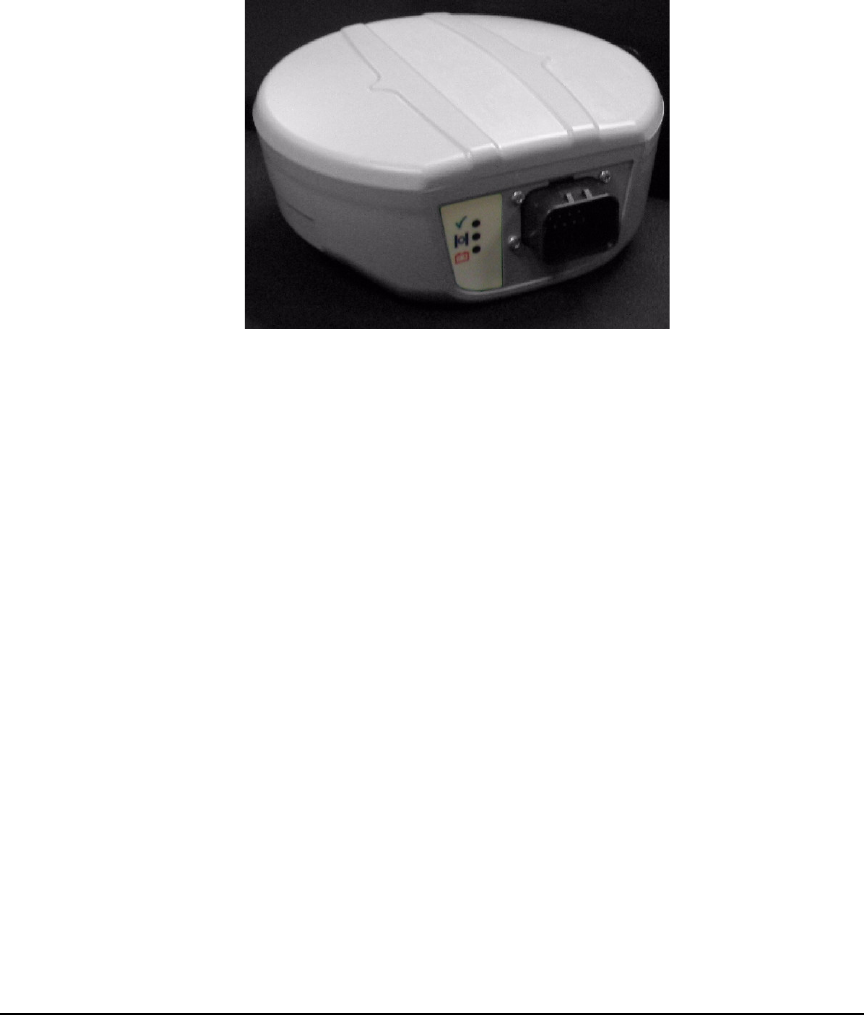
OM-20000123 Rev 3C
SMART-AG
User Manual

2 SMART-AG User Manual Rev 3C
SMART-AG User Manual
Publication Number: OM-20000123
Revision Level: 3C
Revision Date: 2009/10/19
Firmware Version: 3.600 or higher and 1.000 userapp
Proprietary Notice
Information in this document is subject to change without notice and does not represent a commitment
on the part of NovAtel Inc. The software described in this document is furnished under a licence
agreement or non-disclosure agreement. The software may be used or copied only in accordance with
the terms of the agreement. It is against the law to copy the software on any medium except as
specifically allowed in the license or non-disclosure agreement.
No part of this manual may be reproduced or transmitted in any form or by any means, electronic or
mechanical, including photocopying and recording, for any purpose without the express written
permission of a duly authorized representative of NovAtel Inc.
The information contained within this manual is believed to be true and correct at the time of
publication.
AdVance, NovAtel, Narrow Correlator tracking technology, OEMV, ProPak, and RT-2, RT-20 are
registered trademarks of NovAtel Inc.
PAC, and SMART-AG are trademarks of NovAtel Inc.
The Bluetooth® word mark and logos are registered trademarks owned by Bluetooth SIG, Inc. and
any use of such marks by NovAtel Inc. is under license. All other brand names are trademarks of their
respective holders.
Manufactured and protected under U.S. Patent:
© Copyright 2009 NovAtel Inc. All rights reserved. Unpublished rights reserved
under International copyright laws. Printed in Canada on recycled paper.
Recyclable.
PAC Correlator
#6,243,409 B1
#5,414,729
Narrow Correlator
#5,101,416
#5,390,207
#5,495,499
#5,809,064
GLONASS
#6,608,998 B1
GALILEO
#6,184,822 B1
Dual Frequency GPS
#5,736,961
Position for Velocity Kalman Filter
#6,664,923 B1
Anti-Jamming Technology
#5,734,674
RTK Positioning
#6,728,637 B2
#6,664,923 B1

SMART-AG User Manual Rev 3C 3
Table of Contents
Foreword 16
Congratulations!.......................................................................................................... 16
Scope.......................................................................................................................... 16
Prerequisites ............................................................................................................... 16
What’s New in Rev 4 of this Manual? ......................................................................... 16
Conventions ................................................................................................................ 17
1 Introduction 18
1.1 Models and Features ............................................................................................ 18
2 Installation and Setup 20
2.1 Additional Equipment Required ............................................................................ 20
2.1.1 SMART-AG Setup ....................................................................................... 20
2.1.2 Installing the PC Utilities.............................................................................. 22
2.1.3 Power Supply Requirements ....................................................................... 22
2.1.4 Mounting Plate............................................................................................. 23
2.1.5 Mounting the SMART-AG............................................................................ 23
2.1.6 Connecting Data Communications Equipment............................................ 23
2.2 Additional Features and Information ..................................................................... 24
2.2.1 MKI and PPS Strobes.................................................................................. 24
2.2.2 Status Indicators.......................................................................................... 24
2.2.3 Emulated Radar (ER) .................................................................................. 25
2.2.4 Controller Area Network (CAN) ................................................................... 25
2.2.5 Terrain Compensation ................................................................................. 26
3 Operation 27
3.1 Communications with the Receiver....................................................................... 27
3.1.1 Serial Port Default Settings ......................................................................... 27
3.1.2 Communicating Using a Remote Terminal.................................................. 28
3.1.3 Communicating Using a Personal Computer .............................................. 28
3.2 Getting Started...................................................................................................... 28
3.2.1 Starting the Receiver ................................................................................... 28
3.2.2 Communicating with the Receiver Using CDU ............................................ 29
3.3 Transmitting and Receiving Corrections ............................................................... 30
3.3.1 Base Station Configuration.......................................................................... 32
3.3.2 Rover Station Configuration ........................................................................ 33
3.3.3 GPS + GLONASS Base and Rover Configuration ...................................... 33
3.3.4 Configuration Notes..................................................................................... 33
3.3.5 EGNOS........................................................................................................ 34
3.4 GL1DE .................................................................................................................. 35
3.5 Tilt ......................................................................................................................... 36
3.6 Recommended Configuration ............................................................................... 37
4 PC Utilities 38
4.1 CDU/Convert4 Installation .................................................................................... 38
4.2 CDU ...................................................................................................................... 39
4.3 Convert4 ............................................................................................................... 44
4.3.1 Rinex Format ............................................................................................... 44

4 SMART-AG User Manual Rev 3C
Table of Contents
4.3.2 Convert4 Command Line Switches............................................................. 46
4.4 Firmware Upgrades.............................................................................................. 47
4.4.1 Upgrading Using the AUTH Command....................................................... 47
4.4.2 Updating Using the WinLoad Utility ............................................................ 48
5 Bluetooth® Configuration 53
5.1 Bluetooth on the SMART-AG Receiver ................................................................ 53
5.2 Set Up a PC/Laptop with a Bluetooth Adaptor ..................................................... 53
5.3 Locate a Bluetooth-Enabled SMART-AG in Range.............................................. 54
5.4 Communicate with the SMART-AG Using Bluetooth............................................ 55
5.5 Stop Communicating with the SMART-AG Using Bluetooth ................................ 56
A Technical Specifications 57
SMART-AG Receiver Performance ........................................................................... 57
SMART-AG Specifications ........................................................................................ 58
B Commands 64
Syntax Conventions .................................................................................................. 64
FRESET Clear Selected Data from NVM and Reset .............................................. 65
LOG Request Logs from the Receiver .................................................................... 66
$PMDT Configure Tilt Compensation ..................................................................... 71
RADARCFG Configure the ER Output ................................................................... 72
C Logs 74
RADARSIGNAL ER Signal and Position Information ............................................. 75
TILT Compensation ................................................................................................... 78
VERSION HW & SW Versions and Serial Numbers ............................................... 79
D Replacement Parts 80
SMART-AG ............................................................................................................... 80
Accessories ............................................................................................................... 80

SMART-AG User Manual Rev 3C 5
Tables
1 SMART-AG Controller Models ................................................................................... 19
2 SMART-AG Connector Pin-Out ................................................................................. 21
3 SMART-AG LED Status Indicators ............................................................................ 24
4 Available CAN Signals on the SMART-AG ................................................................ 25
5 Tilt Commands ........................................................................................................... 36
6 NovAtel Logs for Rinex Conversion ........................................................................... 46
7 SMART-AG Development Kit Cable Pinouts ............................................................. 61
8 SMART-AG Mating Connectors ................................................................................. 62
9 Recommended Fuse and Fuse Holders .................................................................... 63
10 SMART-AG Commands in Alphabetical Order .......................................................... 64
11 FRESET Target.......................................................................................................... 65
12 Detailed Serial Port Identifiers.................................................................................... 69
13 Response Modes ....................................................................................................... 73
14 SMART-AG Logs in Alphabetical Order..................................................................... 74
15 Position or Velocity Type............................................................................................ 76
16 Solution Status ........................................................................................................... 77
17 Component Type........................................................................................................ 79

6SMART-AG User Manual Rev 3C
Figures
1 SMART-AG Receiver ....................................................................................................... 18
2 SMART-AG Connector ..................................................................................................... 20
3 Simplified SMART-AG Setup ........................................................................................... 22
4 OEMV CD ........................................................................................................................ 22
5 SMART-AG Mounting Plate ............................................................................................. 23
6 SMART-AG Tilt Feature ................................................................................................... 26
7 Open Configuration Window ............................................................................................ 29
8 Basic Differential Setup .................................................................................................... 31
9 Convert4 Screen Examples ............................................................................................. 44
10 Convert4 Command Line Arguments ............................................................................... 46
11 Main Screen of WinLoad .................................................................................................. 49
12 WinLoad’s Open Dialog ................................................................................................... 50
13 Open File in WinLoad ....................................................................................................... 50
14 COM Port Setup ...............................................................................................................51
15 Searching for Card ...........................................................................................................51
16 Authorization Code Dialog ............................................................................................... 51
17 Upgrade Process Complete ............................................................................................. 52
18 Bluetooth Adapter for PC/Laptop ..................................................................................... 53
19 Bluetooth Standby: White ................................................................................................. 53
20 Bluetooth Error: Red ........................................................................................................ 53
21 My Bluetooth Places Window ........................................................................................... 54
22 Bluetooth PIN Code Request ........................................................................................... 55
23 PC/Laptop COM3 Port Assignment ................................................................................. 55
24 Bluetooth Connected: Green ............................................................................................ 56
25 COM3 Disconnect? .......................................................................................................... 56
26 SMART-AG Development Kit Cable ................................................................................ 60

SMART-AG User Manual Rev 3C 7
Software License
Software License
BY INSTALLING, COPYING, OR OTHERWISE USING THE SOFTWARE PRODUCT, YOU
AGREE TO BE BOUND BY THE TERMS OF THIS AGREEMENT. IF YOU DO NOT
AGREE WITH THESE TERMS OF USE, DO NOT INSTALL, COPY OR USE THIS ELEC-
TRONIC PRODUCT (SOFTWARE, FIRMWARE, SCRIPT FILES, OR OTHER ELEC-
TRONIC PRODUCT WHETHER EMBEDDED IN THE HARDWARE, ON A CD OR
AVAILABLE ON THE COMPANY WEB SITE) (hereinafter referred to as "Software").
1. License: NovAtel Inc. ("NovAtel") grants you a non-exclusive, non-transferable license (not a sale)
to, where the Software will be used on NovAtel supplied hardware or in conjunction with other
NovAtel supplied software, use the Software with the product(s) as supplied by NovAtel. You agree
not to use the Software for any purpose other than the due exercise of the rights and licences hereby
agreed to be granted to you.
2. Copyright: NovAtel owns, or has the right to sublicense, all copyright, trade secret, patent and
other proprietary rights in the Software and the Software is protected by national copyright laws,
international treaty provisions and all other applicable national laws. You must treat the Software like
any other copyrighted material except that you may make one copy of the Software solely for backup
or archival purposes (one copy may be made for each piece of NovAtel hardware on which it is
installed or where used in conjunction with other NovAtel supplied software), the media of said copy
shall bear labels showing all trademark and copyright notices that appear on the original copy. You
may not copy the product manual or written materials accompanying the Software. No right is con-
veyed by this Agreement for the use, directly, indirectly, by implication or otherwise by Licensee of
the name of NovAtel, or of any trade names or nomenclature used by NovAtel, or any other words or
combinations of words proprietary to NovAtel, in connection with this Agreement, without the prior
written consent of NovAtel.
3. Patent Infringement: NovAtel shall not be liable to indemnify the Licensee against any loss sus-
tained by it as the result of any claim made or action brought by any third party for infringement of
any letters patent, registered design or like instrument of privilege by reason of the use or application
of the Software by the Licensee or any other information supplied or to be supplied to the Licensee
pursuant to the terms of this Agreement. NovAtel shall not be bound to take legal proceedings against
any third party in respect of any infringement of letters patent, registered design or like instrument of
privilege which may now or at any future time be owned by it. However, should NovAtel elect to take
such legal proceedings, at NovAtel's request, Licensee shall co-operate reasonably with NovAtel in all
legal actions concerning this license of the Software under this Agreement taken against any third
party by NovAtel to protect its rights in the Software. NovAtel shall bear all reasonable costs and
expenses incurred by Licensee in the course of co-operating with NovAtel in such legal action.
4. Restrictions: You may not:
(a) copy (other than as provided for in paragraph 2), distribute, transfer, rent, lease, lend, sell or
sublicense all or any portion of the Software except in the case of sale of the hardware to a
third party;
(b) modify or prepare derivative works of the Software;
(c) use the Software in connection with computer-based services business or publicly display

8 SMART-AG User Manual Rev 3C
Software License
visual output of the Software;
(d) transmit the Software over a network, by telephone or electronically using any means (except
when downloading a purchased up[grade from the NovAtel Web site); or
(e) reverse engineer, decompile or disassemble the Software.
You agree to keep confidential and use your best efforts to prevent and protect the contents of the Soft-
ware from unauthorized disclosure or use.
5. Term and Termination: This Agreement and the rights and licences hereby granted shall continue
in force in perpetuity unless terminated by NovAtel or Licensee in accordance herewith. In the event
that the Licensee shall at any time during the term of this Agreement: i) be in breach of its obligations
hereunder where such breach is irremediable or if capable of remedy is not remedied within 30 days
of notice from NovAtel requiring its remedy; then and in any event NovAtel may forthwith by notice
in writing terminate this Agreement together with the rights and licences hereby granted by NovAtel.
Licensee may terminate this Agreement by providing written notice to NovAtel. Upon termination,
for any reasons, the Licensee shall promptly, on NovAtel's request, return to NovAtel or at the election
of NovAtel destroy all copies of any documents and extracts comprising or containing the Software.
The Licensee shall also erase any copies of the Software residing on Licensee's computer equipment.
Termination shall be without prejudice to the accrued rights of either party, including payments due to
NovAtel. This provision shall survive termination of this Agreement howsoever arising.
6. Warranty: NovAtel does not warrant the contents of the Software or that it will be error free. The
Software is furnished "AS IS" and without warranty as to the performance or results you may obtain
by using the Software. The entire risk as to the results and performance of the Software is assumed by
you. See product enclosure, if any for any additional warranty.
7. Indemnification: NovAtel shall be under no obligation or liability of any kind (in contract, tort or
otherwise and whether directly or indirectly or by way of indemnity contribution or otherwise howso-
ever) to the Licensee and the Licensee will indemnify and hold NovAtel harmless against all or any
loss, damage, actions, costs, claims, demands and other liabilities or any kind whatsoever (direct, con-
sequential, special or otherwise) arising directly or indirectly out of or by reason of the use by the
Licensee of the Software whether the same shall arise in consequence of any such infringement, defi-
ciency, inaccuracy, error or other defect therein and whether or not involving negligence on the part of
any person.
8. Disclaimer and Limitation of Liability:
(a) THE WARRANTIES IN THIS AGREEMENT REPLACE ALL OTHER WARRAN-
TIES, EXPRESS OR IMPLIED, INCLUDING ANY WARRANTIES OF MER-
CHANTABILITY OR FITNESS FOR A PARTICULAR PURPOSE. NovAtel
DISCLAIMS AND EXCLUDES ALL OTHER WARRANTIES. IN NO EVENT WILL
NovAtel's LIABILITY OF ANY KIND INCLUDE ANY SPECIAL, INCIDENTAL OR
CONSEQUENTIAL DAMAGES, INCLUDING LOST PROFITS, EVEN IF NovAtel
HAS KNOWLEDGE OF THE POTENTIAL LOSS OR DAMAGE.
(b) NovAtel will not be liable for any loss or damage caused by delay in furnishing the Software
or any other performance under this Agreement.
(c) NovAtel's entire liability and your exclusive remedies for our liability of any kind (including
liability for negligence) for the Software covered by this Agreement and all other perfor-
mance or non-performance by NovAtel under or related to this Agreement are to the reme-
dies specified by this Agreement.

Software License
SMART-AG User Manual Rev 3C 9
9. Governing Law: This Agreement is governed by the laws of the Province of Alberta, Canada.
Each of the parties hereto irrevocably attorns to the jurisdiction of the courts of the Province of
Alberta.
10. Customer Support: For Software UPDATES and UPGRADES, and regular customer support,
contact the NovAtel GPS Hotline at 1-800-NOVATEL (U.S. or Canada only), or +1-403-295-4900,
Fax +1-403-295-4901, email to support@novatel.ca, Web site: http://www.novatel.com or write to:
NovAtel Inc.Customer Service Department
1120 - 68 Avenue NE
Calgary, Alberta, Canada T2E 8S5

10 SMART-AG User Manual Rev 3C
Terms and Conditions
Standard Terms and Conditions of Sales
1. PRICES: All prices are Firm Fixed Price, FCA 1120 - 68th Avenue N.E., Calgary, Alberta. All
prices include standard commercial packing for domestic shipment. All transportation, insurance,
special packing costs and expenses, and all Federal, provincial and local excise, duties, sales, and
other similar taxes are the responsibility of the Purchaser.
2. PAYMENT: Terms are prepayment unless otherwise agreed in writing. Interest shall be charged
on overdue accounts at the rate of 18% per annum (1.5% per month) from due date. To expedite
payment by wire transfer to NovAtel Inc.: Bank - HSBC Bank of Canada
3. DELIVERY: Purchaser shall supply shipping instructions with each order. (Ship to and bill to
address, NovAtel Quotation #, Preferred carrier and account #, Custom broker/freight forwarder
including name and contact #) In the absence of specific instructions, NovAtel may select a carrier
and insure Products in transit and charge Purchaser accordingly. NovAtel shall not be responsible for
any failure to perform due to unforeseen circumstances or causes beyond its ability to reasonably
control. Risk of loss, damage or destruction shall pass to Purchaser upon delivery to carrier. Goods are
provided solely for incorporation into the Purchaser’s end product and shall not be onward delivered
except as incorporated in the Purchaser’s end product.
4. COPYRIGHT AND CONFIDENTIALITY: Copyright in any specification, drawing, computer
software, technical description and other document supplied by NovAtel under or in connection with
the Order and all intellectual property rights in the design of any part of the Equipment or provision of
services, whether such design be registered or not, shall vest in NovAtel absolutely. The Buyer shall
keep confidential any information expressed or confirmed by NovAtel in writing to be confidential
and shall not disclose it without NovAtel's prior consent in writing to any third party or use it other
than for the operation and maintenance of any Equipment provided.
5. GENERAL PROVISIONS: All Purchase Orders are subject to approval and acceptance by
NovAtel. Any Purchase Order or other form from the Purchaser, which purports to expand, alter or
amend these terms and conditions, is expressly rejected and is and shall not become a part of any
agreement between NovAtel and the Purchaser. This agreement shall be interpreted under the laws of
the Province of Alberta.
Bank: HSBC Bank of Canada US Account # 788889-002
407 - 8 Avenue S.W. CDN Account # 788889-001
Calgary, AB, Canada T2P 1E5 EURO Account # 788889-270
Transit # 10029-016
Swift HKBCCATTCAL

Terms and Conditions
SMART-AG User Manual Rev 3C 11
6. LIMITED WARRANTY AND LIABILITY: Warranty Period: Products - 1 year; Accessories -
90 days (in each case from the date of invoice). NovAtel warrants that during the Warranty Period that
(a) the Product will be free from defects in material and workmanship and conform to NovAtel
specifications; (b) the software will be free from error which materially affect performance; and (c) if
applicable as defined in the User’s Manual, be eligible for access to post contract support and software
updates when available. THESE WARRANTIES ARE EXPRESSLY IN LIEU OF ALL OTHER
WARRANTIES, EXPRESS OR IMPLIED, INCLUDING, WITHOUT LIMITATION, ALL
IMPLIED WARRANTIES OF MERCHANTABILITY AND FITNESS FOR A PARTICULAR
PURPOSE. NOVATEL SHALL IN NO EVENT BE LIABLE FOR SPECIAL, INDIRECT,
INCIDENTAL, OR CONSEQUENTIAL DAMAGES OF ANY KIND OR NATURE DUE TO
ANY CAUSE.
Purchaser’s exclusive remedy for a claim under this warranty shall be limited to the repair or
replacement at NovAtel’s option and at NovAtel’s facility, of defective or nonconforming materials,
parts or components or in the case of software, provision of a software revision for implementation by
the Buyer. All material returned under warranty shall be returned to NovAtel prepaid by the Buyer
and returned to the Buyer, prepaid by NovAtel. The foregoing warranties do not extend to (i)
nonconformities, defects or errors in the Products due to accident, abuse, misuse or negligent use of
the Products or use in other than a normal and customary manner, environmental conditions not
conforming to NovAtel’s specifications, or failure to follow prescribed installation, operating and
maintenance procedures, (ii) defects, errors or nonconformities in the Products due to modifications,
alterations, additions or changes not made in accordance with NovAtel’s specifications or authorized
by NovAtel, (iii) normal wear and tear, (iv) damage caused by force of nature or act of any third
person, (v) shipping damage, (vi) service or repair of Product by the Purchaser without prior written
consent from NovAtel, (vii) Products designated by NovAtel as beta site test samples, experimental,
developmental, preproduction, sample, incomplete or out of specification Products, (viii) returned
Products if the original identification marks have been removed or altered or (ix) Services or research
activities.
7. EXCLUSION OF LIABILITY: If a Party would, but for this paragraph (7), have concurrent
claims in contract and tort (including negligence) such claims in tort (including negligence) shall to
the extent permitted by law be wholly barred, unenforceable and excluded.
NovAtel shall not be liable to the Buyer by way of indemnity or by reason of any breach of the Order
or of statutory duty or by reason of tort (including but not limited to negligence) for any loss of profit,
loss of use, loss of production, loss of contracts or for any financing costs or for any indirect or
consequential damage whatsoever that may be suffered by the Buyer.
In the event and to the extent that NovAtel shall have any liability to Buyer pursuant to the terms of
the Order, NovAtel shall be liable to Buyer only for those damages which have been foreseen or might
have reasonably been foreseen on the date of effectivity of the Order and which are solely an
immediate and direct result of any act or omission of NovAtel in performing the work or any portion
thereof under the Order and which are not in the aggregate in excess of ten (10%) percent of the total
Order price.

SMART-AG User Manual Rev 3C 12
Warranty
Warra nty
NovAtel Inc. warrants that its products are free from defects in materials and workmanship, subject to
the conditions set forth below, for the following periods of time, from the date of sale:
SMART-AG One (1) Year
Antenna One (1) Year
Cables and Accessories Ninety (90) Days
Computer Discs Ninety (90) Days
Software Warranty One (1) Year
Date of sale shall mean the date of the invoice to the original customer for the product. NovAtel’s
responsibility respecting this warranty is solely to product replacement or product repair at an
authorized NovAtel location, or in the case of software, provision of a software revision for
implementation by the customer.
Determination of replacement or repair will be made by NovAtel personnel or by technical personnel
expressly authorized by NovAtel for this purpose.
There are no user serviceable parts in the NovAtel receiver and no maintenance is required. When the
status code indicates that a unit is faulty, replace with another unit and return the faulty unit to
NovAtel Inc.
Once you have obtained an RMA number, you will be advised of proper shipping procedures to return
any defective product. When returning any product to NovAtel, please return the defective product in
the original packaging to avoid ESD and shipping damage.
THE FOREGOING WARRANTIES DO NOT EXTEND TO (I) NONCONFORMITIES, DEFECTS OR ERRORS
IN THE PRODUCTS DUE TO ACCIDENT, ABUSE, MISUSE OR NEGLIGENT USE OF THE PRODUCTS OR
USE IN OTHER THAN A NORMAL AND CUSTOMARY MANNER, ENVIRONMENTAL CONDITIONS NOT
CONFORMING TO NOVATEL’S SPECIFICATIONS, OR FAILURE TO FOLLOW PRESCRIBED INSTALLA-
TION, OPERATING AND MAINTENANCE PROCEDURES, (II) DEFECTS, ERRORS OR NONCONFORMI-
TIES IN THE PRODUCTS DUE TO MODIFICATIONS, ALTERATIONS, ADDITIONS OR CHANGES NOT
MADE IN ACCORDANCE WITH NOVATEL’S SPECIFICATIONS OR AUTHORIZED BY NOVATEL, (III) NOR-
MAL WEAR AND TEAR, (IV) DAMAGE CAUSED BY FORCE OF NATURE OR ACT OF ANY THIRD PER-
SON, (V) SHIPPING DAMAGE; OR (VI) SERVICE OR REPAIR OF PRODUCT BY THE DEALER WITHOUT
PRIOR WRITTEN CONSENT FROM NOVATEL. IN ADDITION, THE FOREGOING WARRANTIES SHALL
NOT APPLY TO PRODUCTS DESIGNATED BY NOVATEL AS BETA SITE TEST SAMPLES, EXPERIMENTAL,
DEVELOPMENTAL, PREPRODUCTION, SAMPLE, INCOMPLETE OR OUT OF SPECIFICATION PROD-
UCTS OR TO RETURNED PRODUCTS IF THE ORIGINAL IDENTIFICATION MARKS HAVE BEEN
REMOVED OR ALTERED. THE WARRANTIES AND REMEDIES ARE EXCLUSIVE AND ALL OTHER WAR-
RANTIES, EXPRESS OR IMPLIED, WRITTEN OR ORAL, INCLUDING THE IMPLIED WARRANTIES OF
MERCHANTABILITY OR FITNESS FOR ANY PARTICULAR PURPOSE ARE EXCLUDED. NOVATEL SHALL
NOT BE LIABLE FOR ANY LOSS, DAMAGE, EXPENSE, OR INJURY ARISING DIRECTLY OR INDIRECTLY
OUT OF THE PURCHASE, INSTALLATION, OPERATION, USE OR LICENSING OR PRODUCTS OR SER-
VICES. IN NO EVENT SHALL NOVATEL BE LIABLE FOR SPECIAL, INDIRECT, INCIDENTAL OR CONSE-
QUENTIAL DAMAGES OF ANY KIND OR NATURE DUE TO ANY CAUSE.
Before shipping any material to NovAtel or Dealer, please obtain a Return Material Authorization (RMA)
number from the point of purchase. You may also visit our Web site at http://www.novatel.com and select
Support | Repair Requests from the top menu.

SMART-AG User Manual Rev 3C 13
Notices
bbbNotice
The following notices apply to the SMART-AG. For more information on emissions testing, please
refer to the regulatory body in your geographic area. For example, in the US that is the Federal
Communications Commission (FCC) and in Europe the Conformité Européenne (CE).
FCC
This device complies with part 15 of the FCC Rules. Operation is subject to the following two
conditions: (1) this device may not cause harmful interference, and (2) this device must accept any
interference received, including interference that may cause undesired operation.
SMART-AG-PVT, SMART-AG-PVT-G, SMART-AG-PVT-S and SMART-AG-PVT-RT20 have been
tested and found to comply with the emission limits for a Class A digital device. The SMART-AG-B
and SMART-AG-TB comply with the emission limits for a Class B digital device. The Class B limits
are designed to provide reasonable protection against harmful interference in a residential installation.
This equipment generates, uses, and can radiate radio frequency energy and, if not installed and used
in accordance with the instructions, may cause harmful interference to radio communications.
However, there is no guarantee that interference will not occur in a particular installation. If this
equipment does cause harmful interference to radio or television reception, which can be determined
turning the equipment off and on, the user is encouraged to try to correct the interference by one or
more of the following measures:
• Re-orient or relocate the SMART-AG
• Increase the separation between the equipment and the SMART-AG
• Connect the equipment to an outlet on a circuit different from that to which the SMART-AG
is connected
• Consult the dealer or an experienced radio/TV technician for help
IMPORTANT: In order to maintain compliance as a Class “A” or Class “B” digital device,
shielded cables should be used for the RS-232 serial data ports (Belden 1036A
or equivalent) and twisted pair cable should be used for the CAN port
(shielded twisted pair will improve CAN performance in electrically harsh
environments). I/O signals should be referred to signal ground (connector pin
5) and not power ground (connector pin 9). If I/O signals route to different
areas of the vehicle, dedicated signal grounds for I/O should be spliced into a
common connection to connector pin 5 at a point close to the SMART-AG.
WARNING: Changes or modifications to this equipment not expressly approved by NovAtel
Inc. could result in violation of Part 15 of the FCC rules and void the user’s
authority to operate this equipment.

14 SMART-AG User Manual Rev 3C
Notice
Industry Canada
SMART-AG-PVT, SMART-AG-PVT-G, SMART-AG-PVT-S and SMART-AG-PVT-RT20
Class A digital apparatuses all comply with Canadian ICES-003.
SMART-AG-PVT, SMART-AG-PVT-G, SMART-AG-PVT-S et le SMART-AG-PVT-RT20 appareils
numérique de la classe B sont conforme à la norme NMB-003 du Canada.
SMART-AG-B and SMART-AG-TB Class B digital apparatues comply with Canadian ICES-003.
SMART-AG-B et SMART-AG-TB appareils numérique de la classe B sont conforme à la norme
NMB-003 du Canada.
CE
The enclosures carry the CE mark.
"Hereby, NovAtel Inc. declares that this SMART-AG is in compliance with the essential requirements
and other relevant provisions of the R&TTE Directive 1999/5/EC and with the EMC Directive 2004/
108/EC."
WEEE
If you purchased your OEMV family product in Europe, please return it to your dealer or supplier at
the end of its life. The objectives of the European Community's environment policy are, in particular,
to preserve, protect and improve the quality of the environment, protect human health and utilise
natural resources prudently and rationally. Sustainable development advocates the reduction of
wasteful consumption of natural resources and the prevention of pollution. Waste electrical and
electronic equipment (WEEE) is a regulated area. Where the generation of waste cannot be avoided, it
should be reused or recovered for its material or energy. WEEE products may be recognized by their
wheeled bin label ( ). 1
RoHS
The SMART-AG is compliant with the European Union (EU) Restriction of Hazardous Substances
(RoHS) Directive 2002/95/EC. 1
1. Please visit the NovAtel Web site at http://www.novatel.com/support/weee.htm for more information
on WEEE and RoHS.

SMART-AG User Manual Rev 3C 15
Customer Service
OEMV Firmware UPGRADES
Firmware upgrades are firmware releases, which increase basic functionality of the receiver from one
model to a higher level model type. When available, upgrades may be purchased at a price, which is
the difference between the two model types on the current NovAtel GPS Price List plus a nominal
service charge.
WINLOAD
Please refer to the OEMV Family Installation and Operation User Manual for instructions on how to
use the WinLoad program to upgrade your OEMVcard.
Contact Information
Model upgrades are accomplished through NovAtel authorized dealers.
Contact your local NovAtel dealer first for more information. To locate a dealer in your area or if the
problem is not resolved, contact NovAtel Inc. directly using one of the following methods:
Call the NovAtel GPS Hotline at 1-800-NOVATEL (U.S. & Canada), or 403-295-4900 (international)
Fax: 403-295-4901
E-mail: support@novatel.com
Web site: http://www.novatel.com
Write: NovAtel Inc., Customer Service Dept., 1120 - 68 Avenue NE, Calgary, AB., Canada, T2E 8S5
Before contacting NovAtel Customer Service regarding software concerns, please do the
following:
1. Issue a FRESET command
2. Log the following data to a file on your PC/laptop for 30 minutes
RXSTATUSA once
BESTPOSA ontime 1
RXCONFIGA once
VERSIONA once
3. Send the file containing the logs to NovAtel Customer Service, using either the NovAtel ftp
site at ftp://ftp.novatel.com/incoming or the support@novatel.com e-mail address.

16 SMART-AG User Manual Rev 3C
Foreword
Foreword
Congratulations!
Congratulations on your purchase of the SMART-AG, a GPS L1 plus GLONASS L1 receiver and
antenna with exceptional flexibility and performance.
NovAtel is an industry leader in state-of-the-art Global Navigation Satellite Systems (GNSS) receiver
design. We believe that our SMART-AG will meet your high expectations, and are working hard to
ensure that future products and enhancements maintain that level of satisfaction.
This is your primary hardware and software reference.
Scope
This manual provides sufficient detail on the SMART-AG, to allow you to effectively integrate and
fully operate it. The information in this manual is a companion to the OEMV family information in
the OEMV Firmware Reference Manual and the OEMV Installation and Operation User Manual.
After the addition of accessories and a power supply, the SMART-AG is ready to go.
SMART-AG utilizes a comprehensive user-interface command structure, which requires
communications through its communications (COM) ports. This manual describes the SMART-AG-
specific commands and logs, see Commands starting on Page 64 and Logs starting on Page 73.
Other supplementary manuals, available on the accompanying CD and on our Web site at
http://www.novatel.com/support/docupdates.htm, aid you in using the other commands and logs
available in the OEMV family of receivers.
PC Utilities are also described, see Chapter 4 starting on Page 37. Integrated with the Control and
Display Unit (CDU) software, these utilities provide graphical user interfaces for logging to a PC/
laptop, upgrading, and converting data types.
Prerequisites
The installation chapters of this document provide information concerning the installation
requirements and considerations for SMART-AG. To run the PC software supplied, your personal
computer must meet or exceed this minimum configuration:
• Windows compatible mouse or pointing device and SVGA display
Although previous experience with Windows is not necessary to use CDU, familiarity with certain
actions that are customary in Windows will assist in the usage of the program. This manual has been
written with the expectation that you already have a basic familiarity with Windows.
What’s New in Rev 4 of this Manual?
This manual has been revised to include information on the following:
• Terrain compensation, see “Terrain Compensation” on page 26.
• Bluetooth®, see “Bluetooth on the SMART-AG Receiver” on page 53.

Foreword
SMART-AG User Manual Rev 3C 17
Conventions
Conventions used in this manual are the following:
This is a notebox that contains important information.
• The letter H in the Offset columns of the commands and logs tables represents the
header length for that command or log. Refer to the OEMV Family Firmware
Reference Manual for ASCII and binary header details.
• The number following 0x is a hexadecimal number.
• Command descriptions’ brackets, [ ], represent the optionality of parameters.
• In tables where values are missing they are assumed to be reserved for future use.
• Status words are output as hexadecimal numbers and must be converted to binary
format (and in some cases then also to decimal). For an example of this type of
conversion, please refer to the RANGE log in the OEMV Family Firmware
Reference Manual.
Conversions and their binary or decimal results are always read from right to left.
For a complete list of hexadecimal, binary and decimal equivalents, please refer to
the Unit Conversion section of the GNSS Reference Book available on our Web site
at http://www.novatel.com/support/docupdates.htm.
See also Section B.1, Syntax Conventions on Page 64 for more syntax when entering commands.
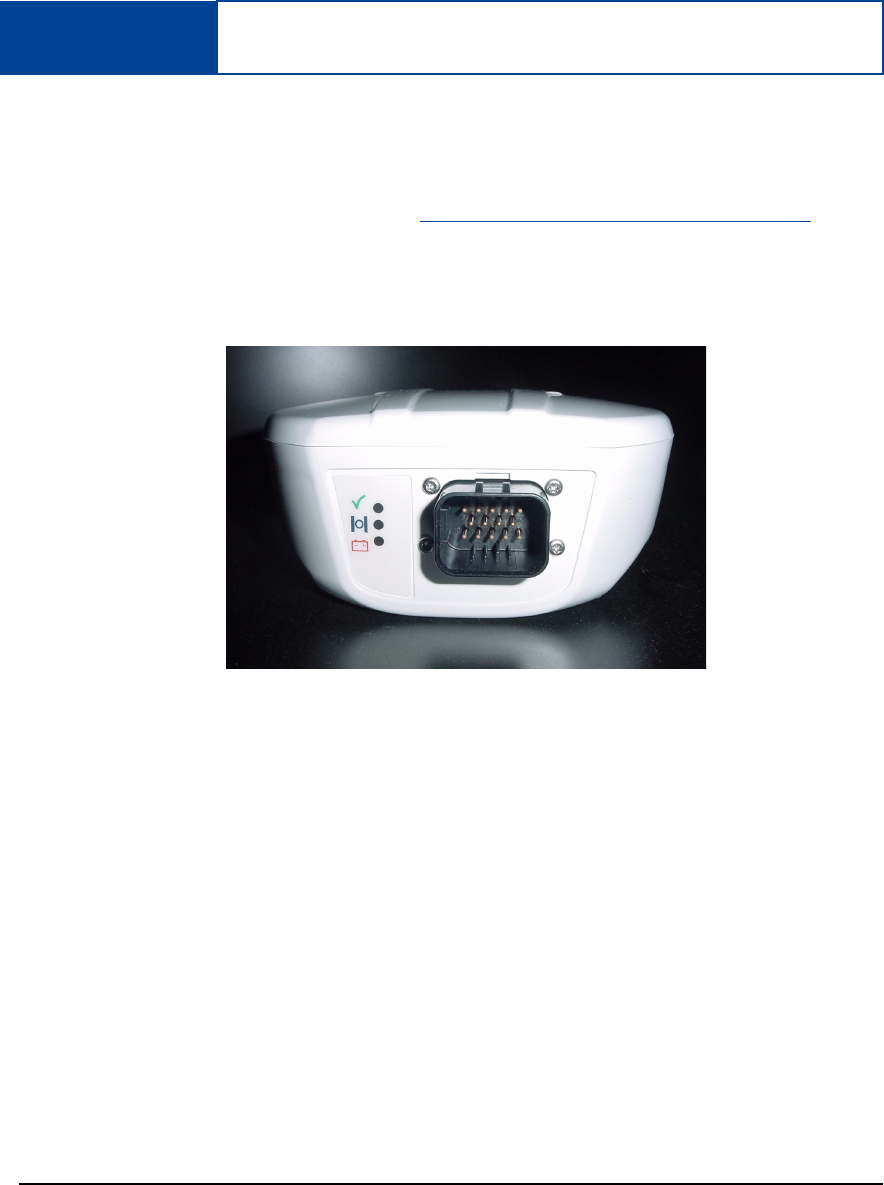
18 SMART-AG User Manual Rev 3C
Chapter 1 Introduction
The SMART-AG is a high-performance GNSS receiver and antenna, capable of receiving and
tracking different combinations of GPS L1 and GLONASS L1 code and carrier signals on a maximum
of 36 channels. SBAS (Satellite Based Augmentation Systems) includes WAAS, EGNOS, and MSAS.
SBAS support is standard. Refer to the GNSS Reference Book for an overview of each of the above
signal types, available from our Web site at http://www.novatel.com/support/docupdates.htm. The
SMART-AG’s rear panel also features light emitting diodes (LEDs) for status indication.
Once you connect the SMART-AG to a vehicle, it begins operating as a fully functional GNSS
system. Figure 1 below shows the SMART-AG without connecting cables.
Figure 1: SMART-AG Receiver
1.1 Models and Features
The main features of the SMART-AG are the following:
• an enhanced high performance GPS+GLONASS L1 receiver
• a high performance GPS+GLONASS L1 antenna
• emulated radar output
• a CAN port
• two (2) RS-232 COM ports
• three (3) LED status indicators
• a water and dust tight enclosure

Introduction Chapter 1
SMART-AG User Manual Rev 3C 19
The SMART-AG is available in several different firmware models whose configurations may include
other additional features. Some possible configurations can be seen in Table 1 below.
Refer also to the OEMV Family Installation and Operation User Manual for information on receiver
communications and operation.
Table 1: SMART-AG Controller Models
Model Name Firmware Feature
SMART-AG-PVT GPS L1 only Autonomous, SBAS, or DGPS
20 Hz positions with emulated radar output
SMART-AG-PVT-G As above with GLONASS L1
SMART-AG-PVT-S GPS L1 only Autonomous, SBAS, or DGPS
5 Hz positions with emulated radar output
SMART-AG-RT20 GPS L1 only Autonomous, SBAS, DGPS, or
20 cm RT-20 positions

20 SMART-AG User Manual Rev 3C
Chapter 2 Installation and Setup
This chapter contains instructions and tips to set up your SMART-AG to create a GNSS receiver
system.
2.1 Additional Equipment Required
In order for the receiver to perform optimally, the following additional equipment is required:
• A PC/laptop (user-supplied)
• A means of communicating with, and powering, the SMART-AG
• SMART-AG cable (01018256) (included with the receiver Development Kit),
NovAtel part number 01018257, see Figure 3, Simplified SMART-AG Setup on
Page 22 for COM and power connections
Use a serial COM connection to communicate with the receiver first.
• A fused power supply (user-supplied) or other user equipment
2.1.1 SMART-AG Setup
Complete the following steps to connect and power your SMART-AG.
1. Mount the SMART-AG on a secure, stable part of the vehicle (i.e. cab roof) with an unobstructed
view of the sky from horizon to horizon, see Section 2.1.5, Mounting the SMART-AG on Page 23.
2. Establish a physical communication connection between the SMART-AG and the PC/laptop.
Connect the COM and Power port on the back of the SMART-AG, see Figure 2 below, to a DB-9
serial port on a PC, laptop or other data storage device.
Figure 2: SMART-AG Connector
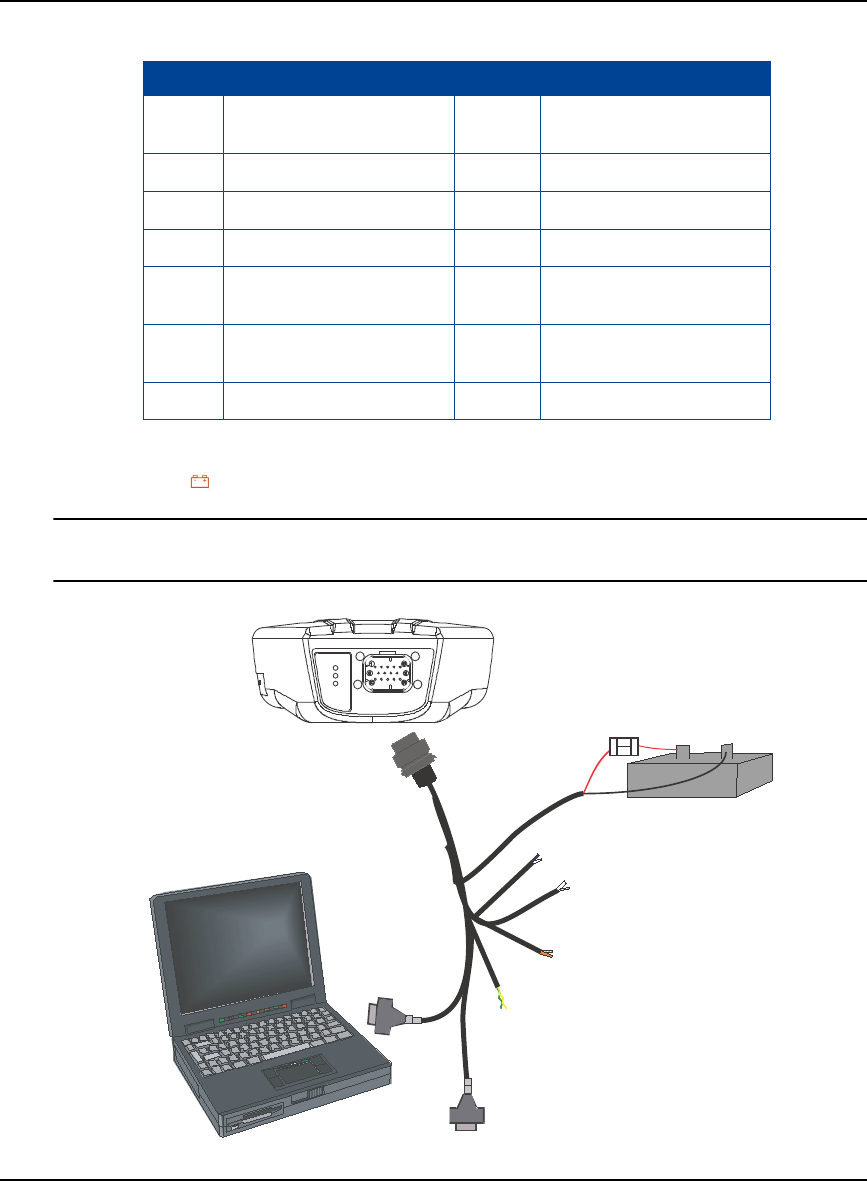
Installation and Setup Chapter 2
SMART-AG User Manual Rev 3C 21
3. Turn on the power supply to the SMART-AG (the SMART-AG cable is also a power cable). The
power LED on the back of the receiver glows red when the SMART-AG is properly powered.
Fuse/holder recommendations can be found in Table 9, Recommended Fuse and Fuse Holders
on page 63
Table 2: SMART-AG Connector Pin-Out
Pin Use Pin Use
1COM 1 TxD 8RESERVED (Do not
connect)
2COM 1 RxD 9Power Negative/Return
3COM 2 TxD 10 Emulated Radar Output
4COM 2 RxD 11 MKI (Mark Input)
5Signal Ground
(COM/ER/MKI/PPS)
12 PPS (Pulse Per Second)
Output
6CAN+ 13 RESERVED (Do not
connect)
7CAN- 14 Power Positive/Source
+-
Emulated Radar
MKI
PPS
CAN
COM
COM
User Supplied
5A Fast Blow
Fuse
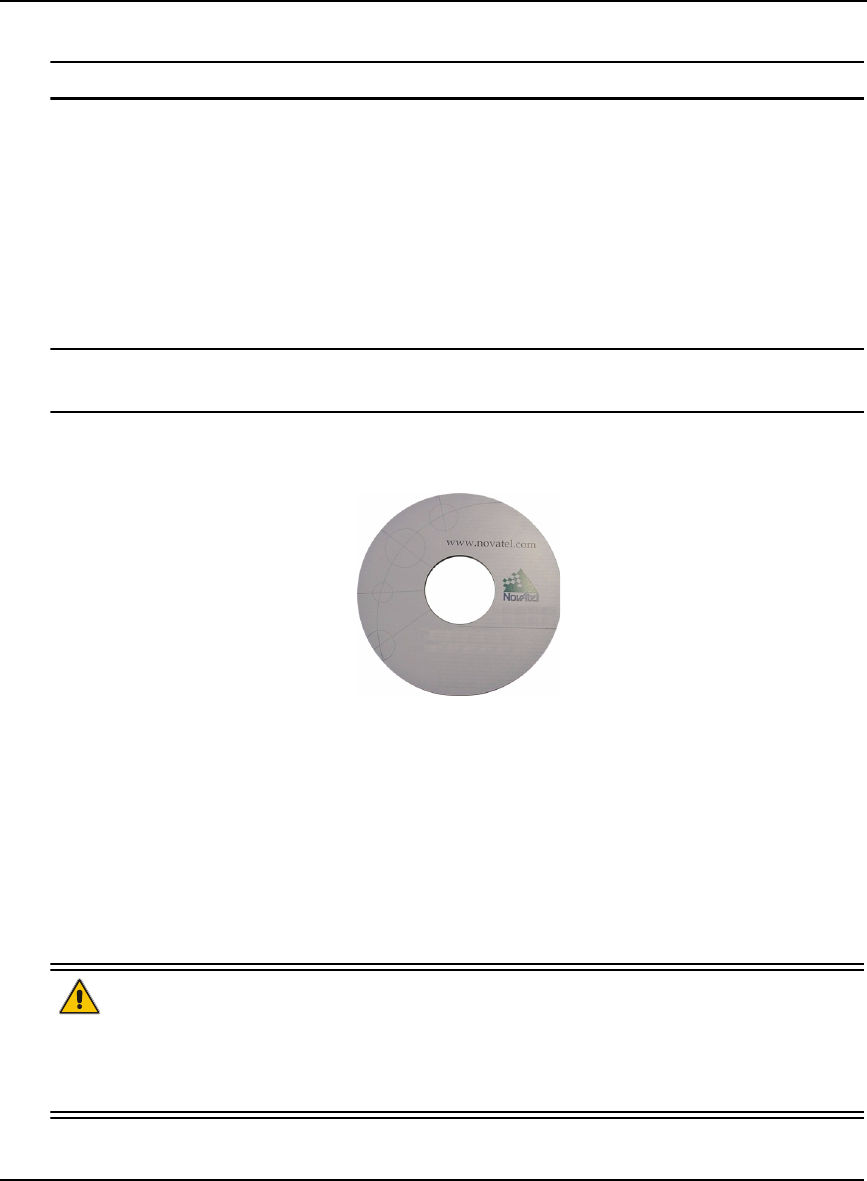
22 SMART-AG User Manual Rev 3C
Chapter 2 Installation and Setup
Figure 3: Simplified SMART-AG Setup
Minimum conductor size for all wiring is 0.5 mm / 20 AWG
2.1.2 Installing the PC Utilities
Once the SMART-AG is connected to the PC/laptop and a power supply, install NovAtel’s PC
Utilities. These include CDU, a graphical user interface program.
1. Start up the PC/laptop.
2. Insert the accompanying CD, see Figure 4 below, in the CD-ROM drive of the computer.
3. Select Install the OEMV GPS PC Utilities from the window that is automatically displayed.
If the window does not automatically open when the CD is inserted, select Run from the Start
menu and select the Browse button to locate Setup.exe on the CD drive.
4. Install the PC Utilities by advancing through the steps provided in the NovAtel PC Utilities setup
program.
Figure 4: OEMV CD
2.1.3 Power Supply Requirements
The SMART-AG requires +8 to +36 VDC for the input power to the receiver. See Page 58 for more
power supply specifications.
The SMART-AG cable provides power in (with a BATT+ label) and power ground (with a BATT-
label) bare wires for connections from the SMART-AG to a 12 to 24V vehicular power system (or
equivalent) protected by a 5A Fast Blow Fuse (user supplied). See its cable details starting on Page
62.
WARNING!: The SMART-AG power source must be protected by a 5A Fast Blow Fuse
or damage to wiring may result (not covered by warranty).
If the voltage supplied is above or below the specified range, the receiver will
suspend operation. If the voltage supplied is above 48V, the receiver may be
permanently damaged, voiding your warranty.
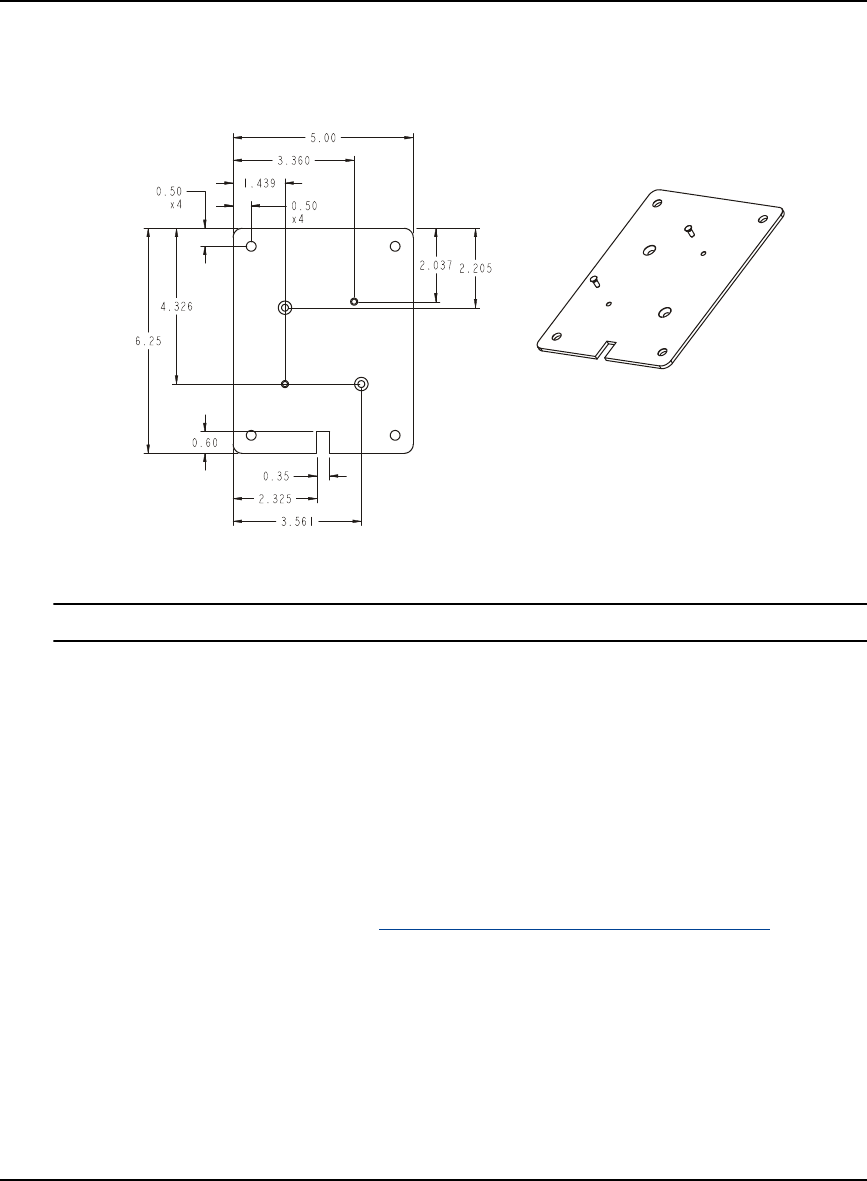
Installation and Setup Chapter 2
SMART-AG User Manual Rev 3C 23
2.1.4 Mounting Plate
A mounting plate is available to facilitate mounting the receiver to a surface
.
Figure 5: SMART-AG Mounting Plate
All measurements are in inches unless specified otherwise.
To install the mounting plate provided with the SMART-AG Development Kit, use the adhesive tape
attached or the mounting holes at each corner of the plate.
2.1.5 Mounting the SMART-AG
The SMART-AG is a single-frequency GNSS receiver and antenna.
When installing the SMART-AG, do the following:
• Choose a location that has a clear view of the sky so that each satellite above the
horizon can be tracked without obstruction. For more information, refer to the
GNSS Reference Book found at http://www.novatel.com/support/docupdates.htm.
• Mount on a secure, stable structure capable of safe operation in the specific
environment. Typical installation is the tractor cab roof, ideally close to the pivot
point of the tractor.
2.1.6 Connecting Data Communications Equipment
To communicate with the receiver by sending commands and obtaining logs, a connection to data
communications equipment is required. See the SMART-AG Cable Pinouts table on Page 61 for more
information.
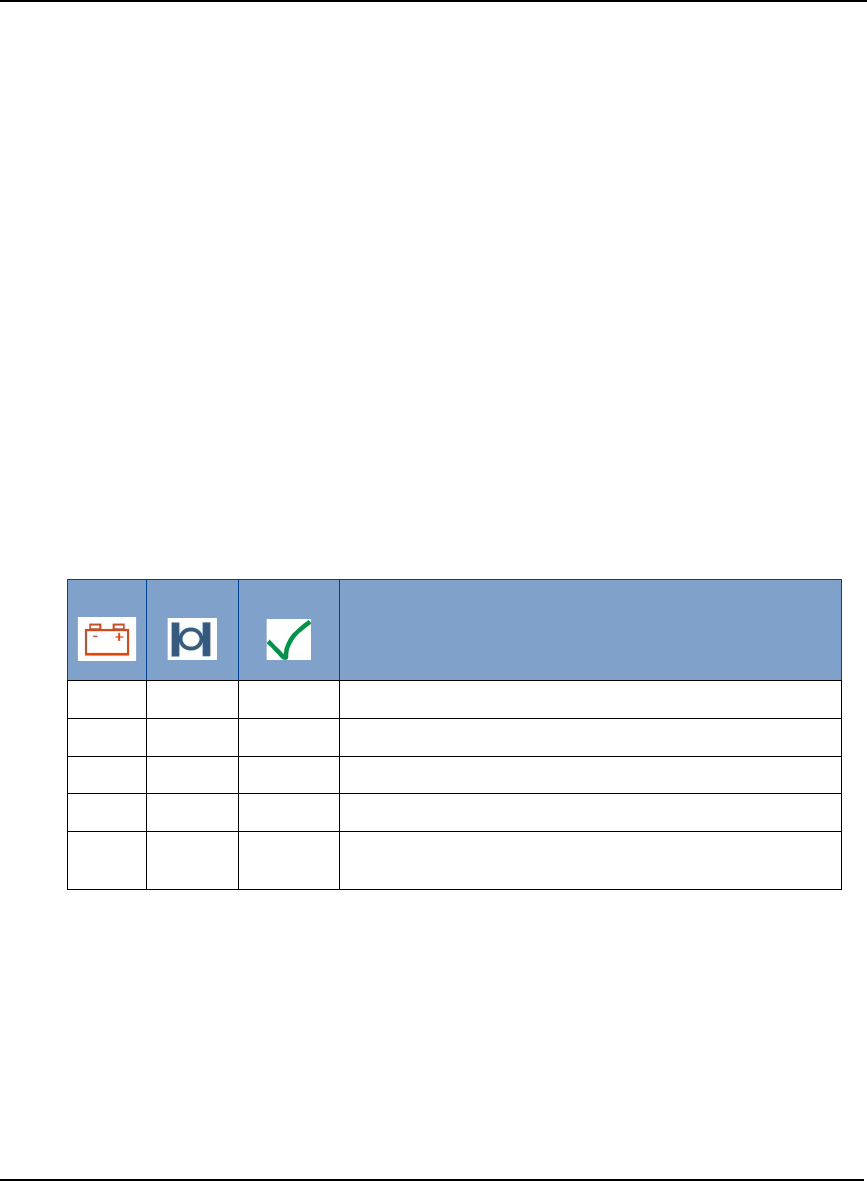
24 SMART-AG User Manual Rev 3C
Chapter 2 Installation and Setup
2.2 Additional Features and Information
This section contains information on the additional features of the SMART-AG, which may affect the
overall design of your receiver system.
2.2.1 MKI and PPS Strobes
An input (MKI) and output (PPS) strobe provide status and synchronization signals. PPS is a 3.3V
CMOS output; MKI is a 5V logic tolerant input.
Pin-out information can also be found on Page 61.
2.2.2 Status Indicators
LED indicators on the SMART-AG provide the status of the receiver. They represent these categories:
• Position Status
• Position Type
• Power
Table 3 shows the meaning of the LED states in the expected sequence after power is applied.
Flashing means that the LED is turning on and off at a 1 Hz rate - 0.5 seconds on and 0.5 seconds off.
Debugging:
• If the power is on but the yellow LED doesn’t flash within one minute, then no satellites are
tracking. There may be excessive blockage or the unit may be defective. Make sure the unit has
an unobstructed view of the sky. Try power cycling the unit.
• If the yellow LED is flashing but doesn’t progress to solid yellow within one minute, then
insufficient satellites are tracking or the signal quality is poor and ephemeris data can’t be
received. Normally, four satellites are sufficient for a valid position as long as they are widely
Table 3: SMART-AG LED Status Indicators
Red Yellow Green
Condition
Off Off Off Power is not available
On Off Off Power available but no satellites are tracking yet
On Flashing Off Tracking at least one satellite but not a valid position
On On Off Position valid in basic autonomous mode
On On On Position valid in an enhanced accuracy mode
(WAAS/EGNOS/MSAS/DGPS or RTK)

Installation and Setup Chapter 2
SMART-AG User Manual Rev 3C 25
distributed in the sky. If it is stuck on blinking yellow, there may be excessive blockage or the unit
may be defective. Make sure the unit has an unobstructed view of the sky. Try power cycling the
unit.
• If the yellow LED is on, but the green doesn’t turn on within five minutes than no SBAS or DGPS
positions are available. If you are using SBAS, make sure SBAS is available in your area and that
the unit is configured to enable SBAS positions (SBASCONTROL ENABLE). For DGPS, make
sure the unit is configured with the correct serial port parameters and to accept the DGPS protocol
your area is using and that your data modem is connected and working.
• The green LED blinks when SBAS is detected then it comes on solid when SBAS is enabled. The
LED will stay dark if SBAS is not detected.
2.2.3 Emulated Radar (ER)
The SMART-AG outputs an emulated RADAR signal via the bare wires labeled ER GND and
ER_OUT on the SMART-AG cable. See Table 6 on Page 61 for the pin-out details of this cable.
The ER outputs a logic high of supply voltage minus 0.5V minimum and logic low of 0.5V maximum
with a rise and fall time of less than 1 ms. Its output references signal GND and provides logic low
output until its speed is greater than 1 km/Hr. ER provides an output frequency that represents 36.11
Hz/km/Hr with an effective range from 1 km/Hr to 55 km/Hr for near-horizontal applications. Please
see B.4, RADARCFG Configure the ER Output starting on Page 71 for more information.
2.2.4 Controller Area Network (CAN)
NEMA 2000 is a CAN standard created by the National Marine Electronics Association and designed
to support networking in marine applications. It functions over a longer physical distance, and
supports more physical nodes than ISO 11783. The relationship between NMEA2000 and SAE J1939
is that J1939 is the standard, while the NMEA 2000 group has added some new messages (called
PGNs or Parameter Group Numbers) and added a new, additional transport protocol called
FastPacket. NMEA2000 compliant, for all intents and purposes, means J1939 compliant plus support
for new NMEA2000 messages. In other word, one cannot have NMEA2000 without J1939 support as
well. J1939 is additionally “harmonized” with ISO 11783, a standard for the agriculture industry.
The CAN module is generally not user-interactive. It is activated when a SETCANNAME command
is entered, and after a SAVECONFIG, the CAN module is activated immediately on all subsequent
start-ups. The module supports the following NMEA2000 Parameter Group Message (PGN):
• PGN 129029 GNSSPositionData
• PGN 129025 GNSSPositionRapidUpdate
• PGN 129026 COGandSOGRapidUpdate
Table 4: Available CAN Signals on the SMART-AG
CAN Pins
CANI+ Pin 6
CANI- Pin 7
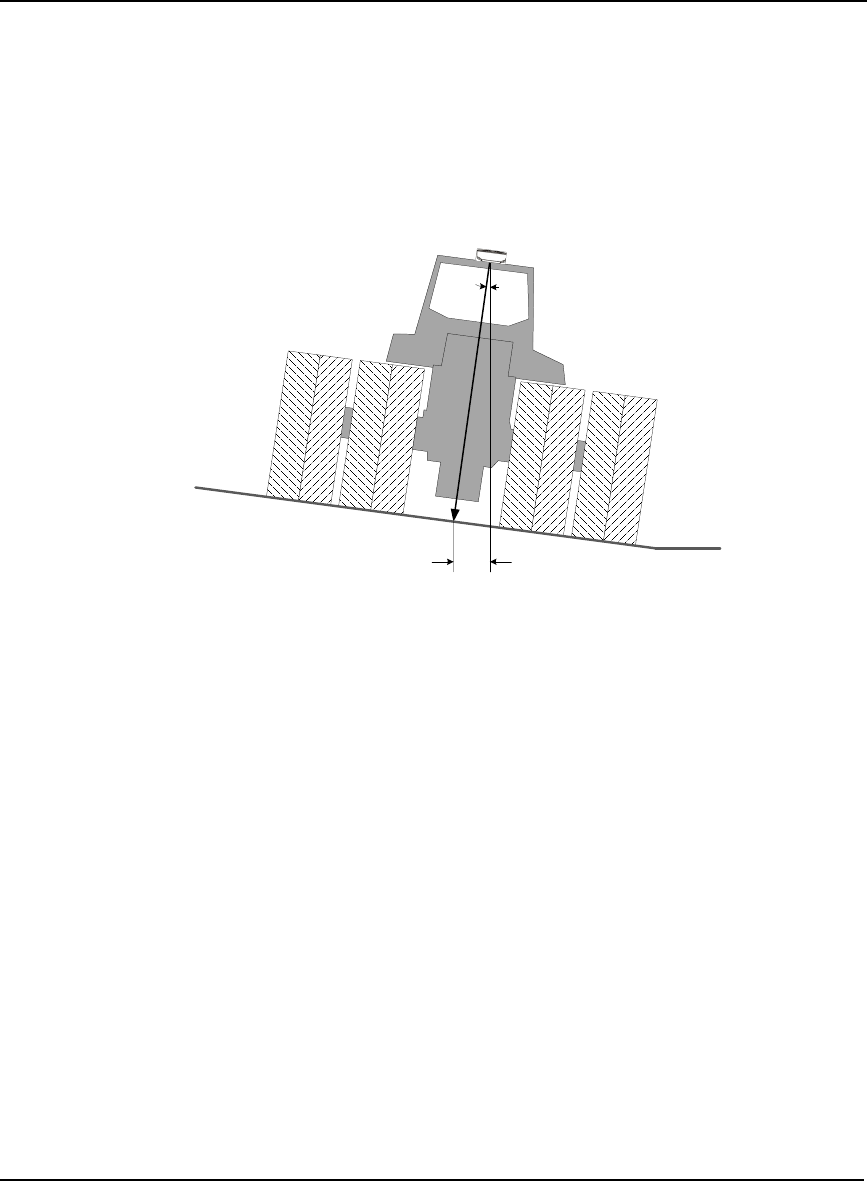
26 SMART-AG User Manual Rev 3C
Chapter 2 Installation and Setup
2.2.5 Terrain Compensation
The SMART-AG Terrain Compensation feature corrects for errors in position caused by tilting of the
vehicle. The SMART-AG senses the vehicle’s roll angle and, with the user-entered “height above
ground”, compensates the position output to give the position under the vehicle rather than at the
antenna.
As shown in Figure 6, if an agricultural implement is operating on sloped terrain, the position will be
in error by an amount proportional to the tilt angle.
Figure 6: SMART-AG Tilt Feature
If enabled, the SMART-AG determines the tilt and corrects the position data before it is forwarded to
the user equipment. In the above example, the tilt is 10 degrees, and the position correction that needs
to be applied is 60 cm. Accuracy of the compensation is a function of the accuracy of the
measurements of both the height of the SMART-AG above ground and the tilt angle, which will be
less than 1 degree.
The Tilt functionality is physically integrated with the SMART-AG, so if Tilt is enabled, it will be
used. For accurate Tilt compensation, the SMART-AG should be installed and oriented on the center
line of the vehicle. When the SMART-AG is correctly installed and oriented, the cables should line up
with the back of the vehicle. The SMART-AG connector can be used as a guide.
Once the SMART-AG is installed, measure the distance from the middle of the SMART-AG (from the
bottom of the connector) to the ground and enter this measurement through the command line, as
outlined in section 3.5 on page 36. For accurate tilt compensation, the height measurement should be
accurate within 2.5 - 5 cm. The error in compensation is proportional to the error in height. If tires
become deflated, the vehicle sinks in mud, or if the height is not measured accurately, the tilt
correction will be in error.
SMART-AG Tilt functionality works with NMEA (GPGGA for example) and NovAtel (BESTPOS,
for example) position logs.
Instructions for setting up and using the Tilt function are outlined in Chapter 3.
Level Ground
10o slope
10o
SMART-AG
3.5 m
Position Error
60 cm
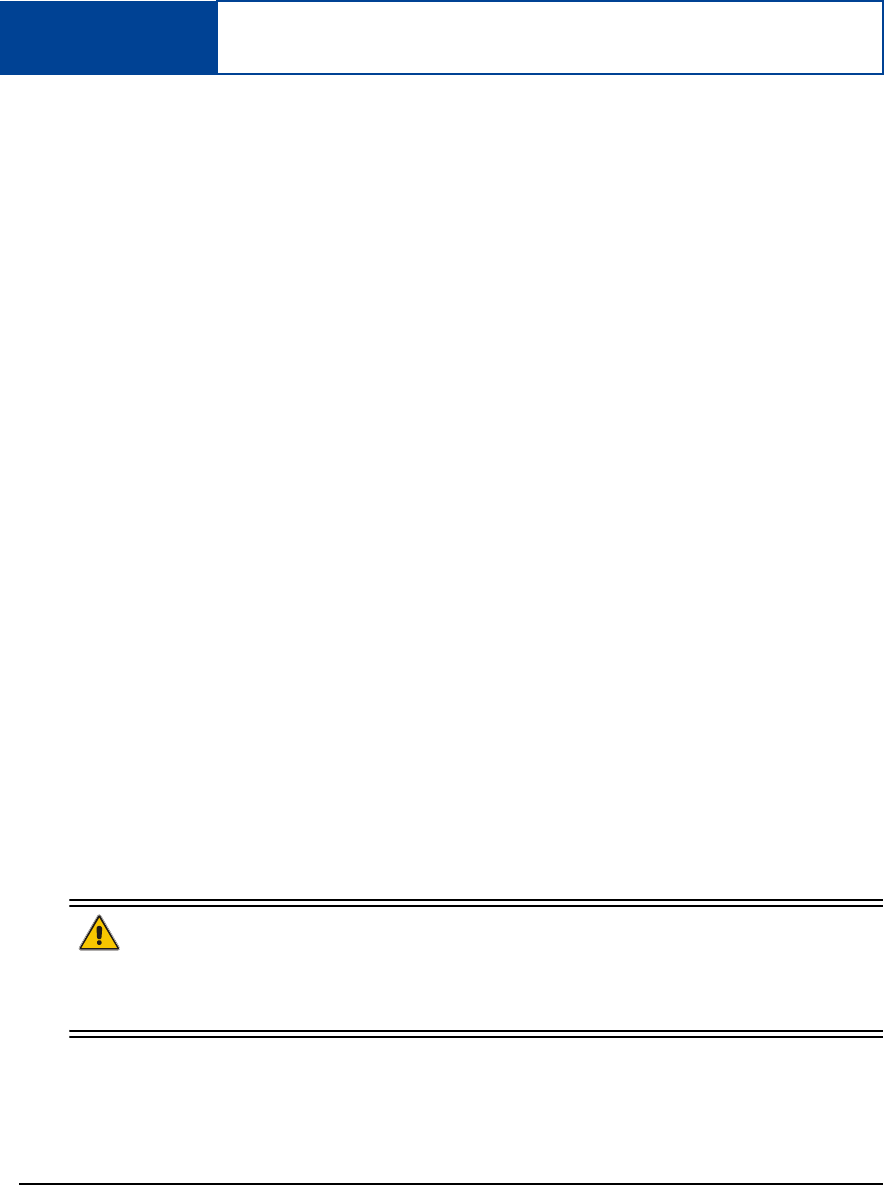
27 SMART-AG User Manual Rev 3C
Chapter 3 Operation
Before operating the SMART-AG for the first time, please ensure that you have followed the
installation instructions in Chapter 2, Installation and Setup starting on Page 21. The following
instructions are based on a COM port configuration such as that shown in Figure 8 on Page 31. It is
assumed that a personal computer (PC), or laptop, is used during initial operation and testing for
greater ease and versatility.
3.1 Communications with the Receiver
Communication with the receiver typically consists of issuing commands through the communication
ports from an external serial communications device. This could be either a terminal or PC/laptop that
is directly connected to the receiver serial port using a DB-9 connector on the SMART-AG multi-
cable. If you are using a radio, it connects to another DB-9 connector on the same multi-cable by
means of the radio serial cable supplied with the radio. It is recommended that you become thoroughly
familiar with the commands and logs detailed in the OEMV Firmware Reference Manual to ensure
maximum utilization of the receiver’s capabilities.
3.1.1 Serial Port Default Settings
The receiver communicates with your PC/laptop or terminal via an RS-232 serial port. For
communication to occur, both the receiver and the operator interface have to be configured properly.
The receiver’s COM1and COM2 default port settings are as follows:
• 9600 bps, no parity, 8 data bits, 1 stop bit, no handshaking, echo off
Changing the default settings requires using the COM command.
The data transfer rate you choose determines how fast information is transmitted. Take for example a
log whose message byte count is 96. The default port settings allows 10 bits/byte (8 data bits + 1 stop
bit + 1 framing bit). It therefore takes 960 bits per message. To get 10 messages per second then
requires 9600 bps. Please also remember that even if you set the bps to 9600 the actual data transfer
rate is lower and depends on the number of satellites being tracked, data filters in use, and idle time. It
is suggested that you leave yourself a margin when choosing a data rate (115200 is recommended for
most applications).
CAUTION!: Although the receiver can operate at data transfer rates as low as 300 bps,
this is not desirable. For example, if several data logs are active (that is, a
significant amount of information needs to be transmitted every second)
but the bit rate is set too low, data will overflow the serial port buffers,
cause an error condition in the receiver status and result in lost data.

28 SMART-AG User Manual Rev 3C
Chapter 3 Operation
3.1.2 Communicating Using a Remote Terminal
One method of communicating with the receiver is through a remote terminal. The receiver has been
pre-wired to allow proper RS-232 interface with your data terminal. To communicate with the
terminal, the receiver only requires the RX, TX, and GND lines to be used. Request to Send (RTS)/
Clear to Send (CTS) hardware handshaking is not available. Ensure the terminal’s communications
set-up matches the receiver’s RS-232 protocol.
3.1.3 Communicating Using a Personal Computer
An IBM-compatible PC/laptop can be set up to emulate a remote terminal as well as provide the
added flexibility of creating multiple-command batch files and data logging storage files. Any
standard communications software package that emulates a terminal can be used to establish
bidirectional communications with the receiver, for example, HyperTerminal or our own graphic user
interface (GUI) program, CDU. All data is sent as raw 8-bit binary or ASCII characters.
3.2 Getting Started
Included with your receiver are NovAtel’s CDU and Convert programs. CDU is a windows-based
GUI which allows you to access the receiver's many features without the need for communications
protocol or to write special software. The Convert utility is a windows-based utility that allows you to
convert between file formats, and strips unwanted records for data file compilation. See also Page 22.
3.2.1 Starting the Receiver
When first powered, the SMART-AG undergoes a complete self-test. If an error condition is detected
during a self-test, the self-test status word changes. This self-test status word can be viewed in the
header of any data output log. Refer to the chapter on Messages in the OEMV Firmware Reference
Manual for header information. If a persistent error develops, please contact your local NovAtel
dealer first. If the problem is still unresolved, please contact NovAtel directly through any of the
methods listed in the Customer Service section at the beginning of this manual on Page 16.
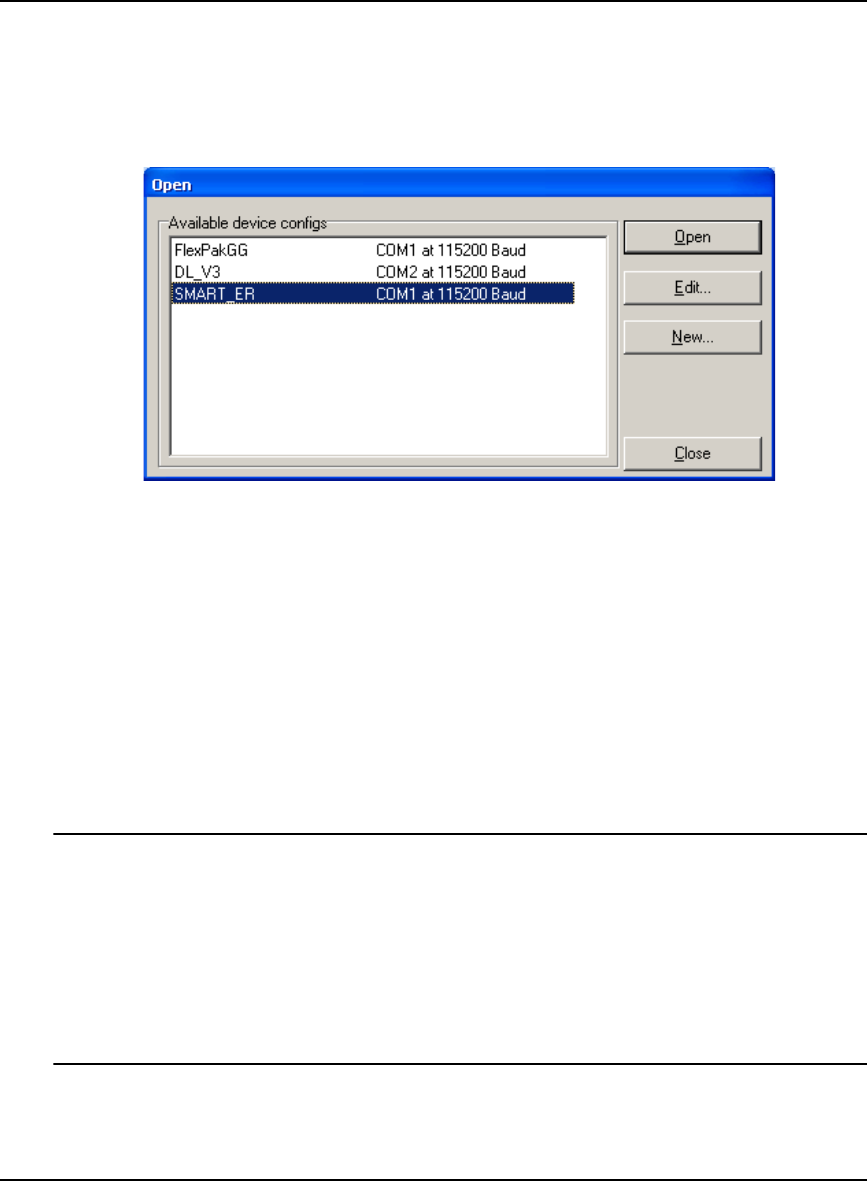
Operation Chapter 3
SMART-AG User Manual Rev 3C 29
3.2.2 Communicating with the Receiver Using CDU
Launch the CDU program and select Device | Open from its main menu. The Open Configuration
window appears. Figure 7, below, shows an Open Configuration window with two possible
configurations already set up. Your configurations may be different or you may have none at all, in
which case, the Open Configuration window is empty.
Figure 7: Open Configuration Window
Refer to CDU’s help file by selecting the Help | Contents menu. Ensure you can see the Console and
ASCII Messages windows by selecting them from the View menu.
When the receiver is first turned on, no data is transmitted from the COM ports except for the port
prompt. The console window displays a port name:
[COM1] if connected to COM1 port,
or
[COM2] if connected to COM2 port,
Any of the above prompts indicate that the receiver is ready and waiting for command input.
1. You may also have to wait for output from receiver self tests. For example, on start-up,
the OEMV family receiver is set to log the RXSTATUSEVENTA log ONNEW on all
ports. Refer to the OEMV Family Firmware Reference Manual for more details.
2. If you find that CDU is unable to locate your OEMV family receiver, it may be that you
have previously used the SAVECONFIG command. In this case, try using a different
COM port to communicate to the receiver. Once communication has been established,
issue the command FRESET STANDARD. You should now be able to use your original
communication port again.

30 SMART-AG User Manual Rev 3C
Chapter 3 Operation
Commands are typed at the interfacing computing device’s keypad or keyboard, and executed after
issuing a carriage return command which is usually the same as pressing the <Enter> key.
An example of a response to an input command is the FIX POSITION command. It can be as:
[COM2] fix position 51.11635 -114.0383 1048.2 [carriage return]
<OK
where [COM2] is the port prompt, followed by the command you enter from your keypad or keyboard
and [carriage return] indicates that you should press the <Enter> key.
The example above illustrates the command input to the base receiver’s COM2 port, which sets the
position of the base station receiver for differential operation. Confirmation that the command was
actually accepted is the appearance of <OK.
If a command is entered incorrectly, the receiver responds with:
<INVALID MESSAGE ID (or a more detailed message)
WARNING!: Ensure the Control Panel’s Power Settings on your PC/laptop are not set
to go into Hibernate or Standby modes. Data will be lost if one of these
modes occurs during a logging session.
3.3 Transmitting and Receiving Corrections
RTK or DGPS corrections can be transmitted from a base station to a rover station to improve position
accuracy. The base station is the GNSS receiver, which is acting as the stationary reference. It has a
known position and transmits correction messages to the rover station. The rover station is the GNSS
receiver which does not know its exact position and can be sent correction messages from a base
station to calculate differential GNSS positions. The SMART-AG can be used as a base receiver to
transmit RTK or DGPS corrections or a rover to receive the same corrections. An example of a
differential setup is given in Figure 8 on Page 31.
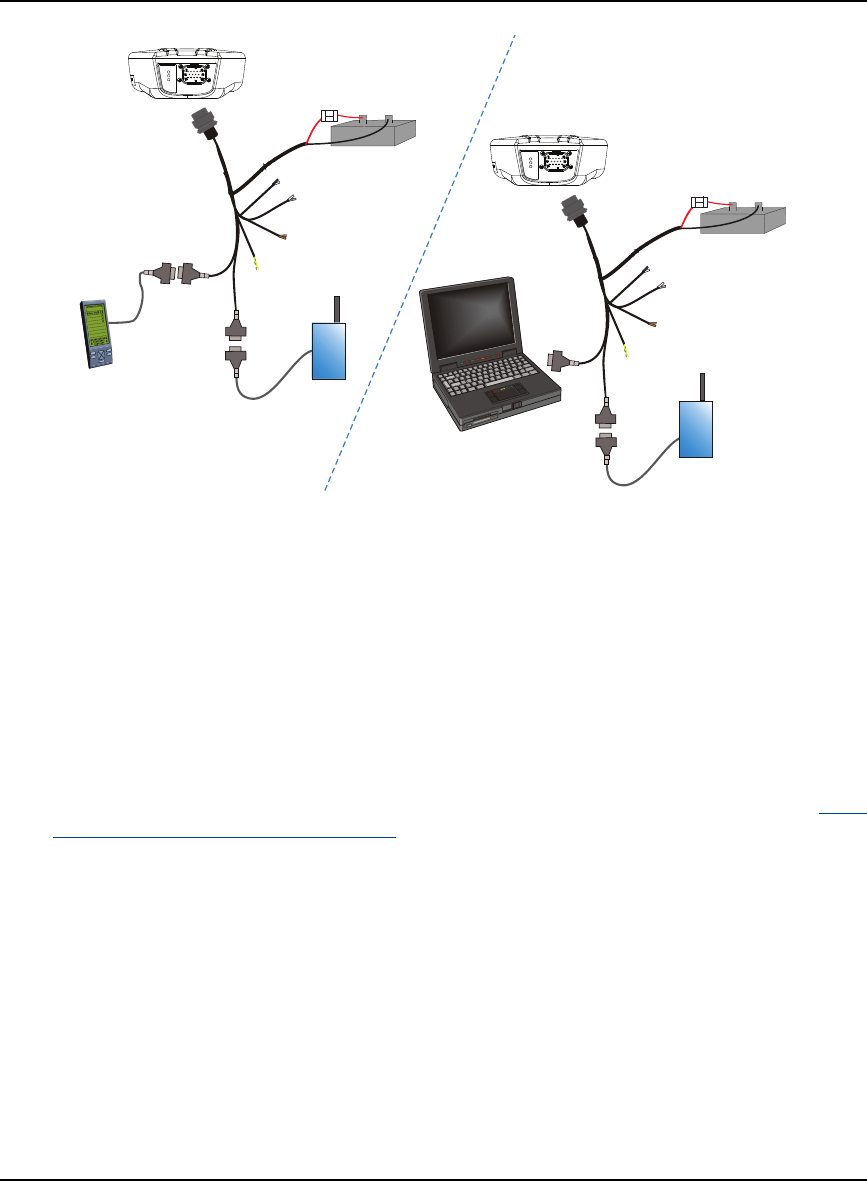
Operation Chapter 3
SMART-AG User Manual Rev 3C 31
Figure 8: Basic Differential Setup
Reference Description
1 SMART-AG receiver
2 User-supplied 5A fast blow fuse
3 User-supplied power supply, for example a battery
4 User-supplied device to COM1
5 User-supplied radio device to COM2
6 User-supplied PC/laptop, for setting up and monitoring, to COM1
System biases can introduce errors, refer to our GNSS Reference Book found on our Web site at http://
www.novatel.com/support/docupdates.htm for more information. In most cases you need to provide a
data link between the base station and rover station (two NovAtel receivers) in order to receive
corrections. SBAS corrections can be accomplished with one receiver and are exceptions to the base/
rover concept. Generally a link capable of data throughput at a rate of 9600 bits per second, and less
than 4.0 s latency, is recommended.
Once your base and rover are set up, you can configure them as shown in the configuration examples
that follow in Sections 3.3.1 - 3.3.2 starting on Page 32.
Base
Rover
3
+
-
4
+
-
1
2
1
2
3
5
6
5

32 SMART-AG User Manual Rev 3C
Chapter 3 Operation
3.3.1 Base Station Configuration
At the base station, enter the following commands:
interfacemode port rx_type tx_type [responses]
fix position latitude longitude height
log port message [trigger [period]]
Examples of these commands include the following:
RTCA interfacemode com2 none rtca off
fix position 51.11358042 -114.04358013 1059.4105
log com2 rtcaobs ontime 1
log com2 rtcaref ontime 10
log com2 rtca1 ontime 5 (optional for rtk)
log com2 rtcaephem ontime 10 1 (optional)
RTCM interfacemode com2 none rtcm off
fix position 51.11358042 -114.04358013 1059.4105
log com2 rtcm3 ontime 10 (required for RTK)
log com2 rtcm22 ontime 10 1 (optional)
log com2 rtcm1819 ontime 1
log com2 rtcm1 ontime 5
RTCMV3 interfacemode com2 none rtcmv3 off
fix position 51.11358042 -114.04358013 1059.4105
log com2 rtcm1006 ontime 10
log com2 rtcm1003 ontime 1
CMR+ interfacemode com2 none cmr off
fix position 51.11358042 -114.04358013 1059.4105
log com2 cmrobs ontime 1
log com2 cmrplus ontime 1 (important to use ontime 1 with cmrplus)
CMR interfacemode com2 none cmr off
fix position 51.11358042 -114.04358013 1059.4105
log com2 cmrobs ontime 1
log com2 cmrref ontime 10
log com2 cmrdesc ontime 10 1

Operation Chapter 3
SMART-AG User Manual Rev 3C 33
3.3.2 Rover Station Configuration
At the rover station, enter:
interfacemode port rx_type tx_type [responses]
For example:
RTCA interfacemode com2 rtca none off
RTCM interfacemode com2 rtcm none off
RTCMV3 interfacemode com2 rtcmv3 none off
CMR+ interfacemode com2 cmr none off
CMR interfacemode com2 cmr none off (same as CMR+)
3.3.3 GPS + GLONASS Base and Rover Configuration
This section shows you how to set up your base and rover OEMV GPS + GLONASS-enabled
receivers for GPS + GLONASS RTK operation:
Base Station:
fix position lat lon hgt (enter your own lat, lon, and hgt values)
com com2 9600 N 8 1 N off
interfacemode com2 none rtca off
log com2 rtcaref ontime 10
log com2 rtcaobs2 ontime 1
log com2 rtca1 ontime 5 (optional, enable code-DGPS coverage)
saveconfig (optional, save configuration to non-volatile memory)
Rover Station:
com com2 9600 N 8 1 N off
interfacemode com2 rtca none off
log com1 bestposa ontime 1 (optional, view position information)
saveconfig (optional, save configuration to non-volatile memory)
3.3.4 Configuration Notes
For compatibility with other GNSS receivers, and to minimize message size, it is recommended that
you use the standard form of RTCA, RTCM, RTCMV3 or CMR corrections as shown in the base and
rover examples above. This requires using the INTERFACEMODE command to dedicate one
direction of a serial port to only that message type. When the INTERFACEMODE command is used
to change the mode from the default, NOVATEL, you can no longer use NovAtel format messages.

34 SMART-AG User Manual Rev 3C
Chapter 3 Operation
If you wish to mix NovAtel format messages and RTCA, RTCM, RTCMV3 or CMR messages on the
same port, you can leave the INTERFACEMODE set to NOVATEL and log out variants of the
standard correction messages with a NovAtel header. ASCII or binary variants can be requested by
simply appending an "A" or "B" to the standard message name. For example on the base station:
interfacemode com2 novatel novatel
fix position 51.11358042 -114.04358013 1059.4105
log com2 rtcm1b ontime 2
Using the receiver in this mode consumes more CPU bandwidth than using the native
differential messages as shown in Section 3.3.1, Base Station Configuration on Page 32.
At the rover station you can leave the INTERFACEMODE default settings (interfacemode com2
novatel novatel). The rover receiver recognizes the default and uses the corrections it receives with a
NovAtel header.
The PSRDIFFSOURCE and RTKSOURCE commands set the station ID values which identify the
base stations from which to accept pseudorange or RTK corrections respectively. They are useful
commands when the rover station is receiving corrections from multiple base stations. Refer to the
GNSS Reference Book for more information on SBAS, available from our Web site at:
http://www.novatel.com/support/docupdates.htm
All PSRDIFFSOURCE entries fall back to SBAS (even NONE) for backwards compatibility.
At the base station it is also possible to log out the contents of the standard corrections in a form that is
easier to read or process. These larger variants have the correction fields broken out into standard
types within the log, rather than compressed into bit fields. This can be useful if you wish to modify
the format of the corrections for a non-standard application, or if you wish to look at the corrections
for system debugging purposes. These variants have "DATA" as part of their names (for example,
RTCADATA1, RTCMDATA1, CMRDATAOBS, and more). Refer also to the OEMV Firmware
Reference Manual, which describes the various message formats in more detail.
Information on how to send multiple commands and log requests using DOS or Windows, can
be found on our Web site at http://www.novatel.com/support/knowledgedb.htm.
3.3.5 EGNOS
EGNOS (European Geostationary Navigation Overlay Service) has been developed to work with
existing satellite navigation systems to improve the accuracy of navigation signals. The EGNOS
signal is transmitted by two geostationary satellites and covers all of Europe. EGNOS transmits a
signal containing information on the reliability and accuracy of the positioning signals sent out by
GPS.
ESTB (EGNOS System Test Bed) is a reduced version of EGNOS using dedicated monitoring stations
and processing devices. EGNOS and ESTB are two independent systems making use of its own

Operation Chapter 3
SMART-AG User Manual Rev 3C 35
ground segment infrastructure and different GEOs. EGNOS and ESTB broadcast two different
signals.
The ESTB is broadcasted on PRN (pseudorandom number) 126 and EGNOS is broadcasted on PRNs
120 and 124.
Due to the experimental nature of the ESTB, the signals are broadcast without any guarantee of
service.
Use of the ESTB signal is not recommended by NovAtel. Use this command to prevent
tracking PRN 126: WAAS17 0 1 0 126 255 0 0 0 0 0 0 0.
EGNOS entered its pre-operational phase in 2006 and at the time of writing is still in test mode and so
the signal broadcast by the EGNOS satellites (via PRNs 120 & 124) should be used with caution. By
default NovAtel receivers will not use SBAS signals in test mode. If you wish to use these signals you
must issue the following command:
sbascontrol enable egnos 0 zerototwo
More information on the ESTB can be found at http://www.esa.int/estb. More information on EGNOS
can be found at http://www.esa.int/egnos.
3.4 GL1DE
SMART-AG contains NovAtel’s GL1DE which is a positioning algorithms for single frequency GPS
and GPS/GLONASS applications. GL1DE produces a smooth position output tuned for applications
where optimal time relative (pass to pass) accuracy is more important than absolute accuracy. Because
of this, it is well suited for agricultural applications.
Multipath signals tend to induce time-varying biases and increase the measurement noise on the L1
pseudorange measurements. Carrier phase measurements are much less susceptible to the effects of
multipath. The GL1DE algorithm fuses the information from the L1 code and the L1 phase
measurements into a Position-Time-Velocity (PVT) solution.
GL1DE includes settings for a dynamic mode, a static mode, and an “auto” mode, where the filtering
parameters are automatically adjusted as vehicle velocity varies between stationary and dynamic
states.
Refer to our white papers at www.novatel.ca/products/whitepapers.htm for more information on
GL1DE.

36 SMART-AG User Manual Rev 3C
Chapter 3 Operation
3.5 Tilt
The commands used to configure the Tilt feature are summarized in Table 5.
Tilt commands start with $PMDT and end with *cksum<crlf> and are described in more detail in
Appendix B in section “$PMDT Configure the Tilt Function”.
As noted, Tilt commands are sent with a checksum, to ensure message integrity in noisy
environments. The checksum, which is a two-hex-digit parameter, is calculated by XORing all
characters between $ and *.
Tilt is disabled by default. To enable Tilt:
1. Set the height using the $PMDT,u.... command
2. Enter $PMDT,x command to save this height to non-volatile memory. The unit will boot up with
the height entered.
To disable Tilt, repeat the above process, but set the height to 0.
Table 5: Tilt Commands
Command Description Description
lSet Field Level For calibration purposes, informs
the SMART-AG that the vehicle is
located on level ground.
uSet GPS Sensor Height For calibration purposes, allows
the user to enter the sensor’s
height above ground, in feet and
inches, or metres.
xUpdate Flash Values Update calibration parameters in
flash memory.

Operation Chapter 3
SMART-AG User Manual Rev 3C 37
3.6 Recommended Configuration
The following command is recommended to enable CAN:
setcanname 305
The following command is recommended to enable SBAS(WAAS/EGNOS/MSAS) corrections:
sbascontrol enable
The following commands are recommended to enable GL1DE:
pdpfilter enable
pdpmode relative auto
NovAtel has registered manufactured ID code 305 with J1939. When complete, your configuration
can be saved with the SAVECONFIG command. Refer to the OEMV Family Firmware Reference
Manual and APN-050 SMART-AG Firmware Release for further details on these commands.

SMART-AG User Manual Rev 3C 38
Chapter 4 PC Utilities
Visit http://www.novatel.com/support/fwswupdates.htm for the most recent versions of the PC
software and receiver firmware.
4.1 CDU/Convert4 Installation
The CD accompanying this manual contains the Windows applications CDU (Control and Display
Unit) and Convert4. The DL Explorer is part of CDU. They are installed via a standard Install Shield
set-up application. Also included on the CD is sample source code, to aid development of software for
interfacing with the receiver, and product documentation.
These applications utilize a database in their operations so the necessary components of the Borland
Database Engine (BDE) are installed as well as the necessary database tables and an alias for the
database. The install set-up application does all this automatically so you have only to select where
you would like the applications installed on your PC. It is strongly recommended that you close all
applications before installing CDU and Convert4. You must close any applications that may be using
the BDE before installing. The install set-up modifies the BDE configuration so that it can recognize
the new CDU and Convert4.
The software operates from your PC’s hard drive. You will need to install the software from the CD
supplied by NovAtel or from our Web site:
1. Start Microsoft Windows.
2. Place the NovAtel CD in your CD-ROM drive. If the setup utility is not automatically accessible,
follow these steps:
a. Select Run from the Start menu.
b. Select the Browse button.
c. Locate Setup.exe on the CD drive and select Open.
d. Select OK to run the setup utility.
3. Advance through the steps provided by the setup utility.
When the installation is complete, click on a program icon to launch the application.
The latest CDU is available to download from our Web site at:
http://www.novatel.com/support/fwswupdates.htm
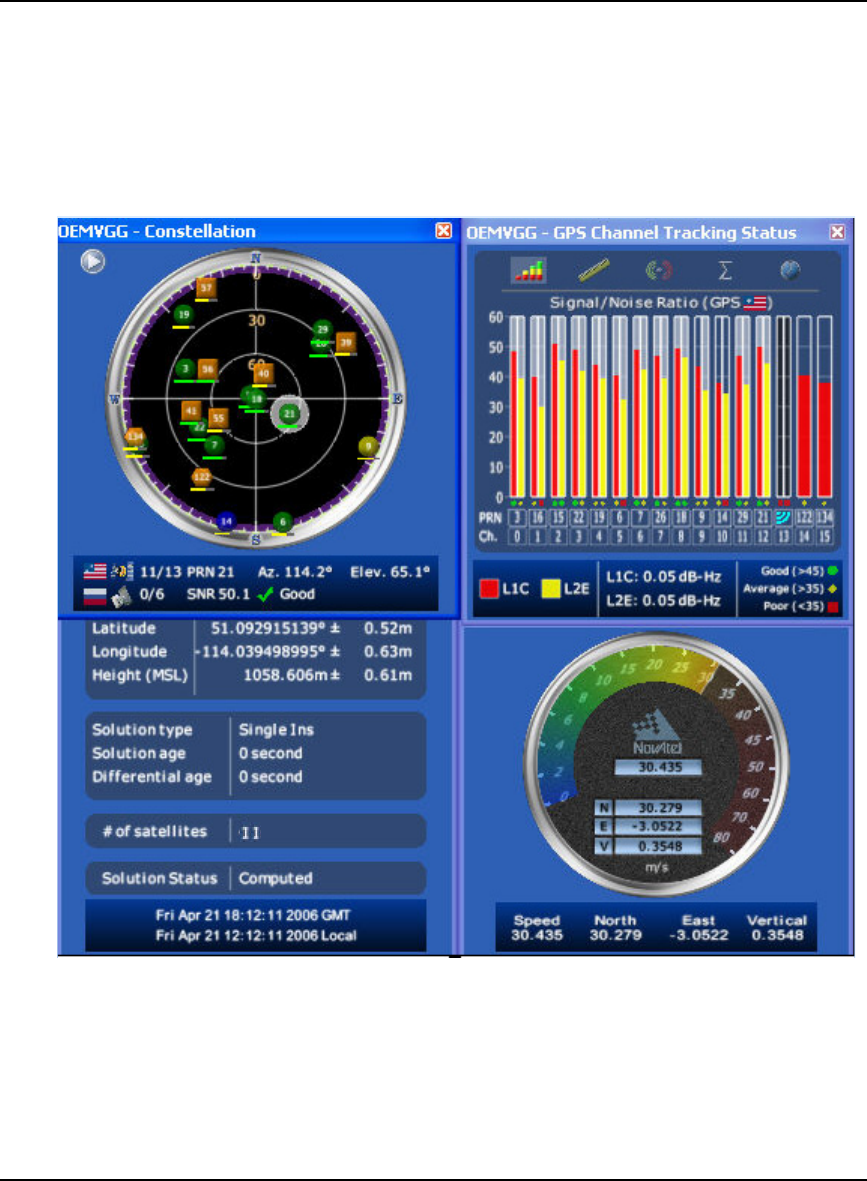
PC Utilities Chapter 4
SMART-AG User Manual Rev 3C 39
4.2 CDU
CDU is a 32-bit Windows application. The application provides a graphical user interface (GUI) to
allow you to set-up and monitor the operation of the NovAtel receiver by providing a series of
windows whose functionality is explained in this section. A help file is included with CDU. To access
the file, select Contents from the Help menu.
The rest of this section shows the CDU windows from the View menu and their descriptions.
Most windows have a popup menu accessible by right clicking on the window with the mouse. They
provide a way to customize the window by changing the font or to print the window contents. Some of
the windows have access to the Options dialog which contains further settings for certain windows.
•Constellation Window: The Constellation window displays each satellite being tracked by the
receiver. When you select a satellite, the window shows details of its PRN, Signal to Noise Ratio
(SNR), azimuth and elevation. Concentric circles from 0° to 90° represent elevations from the
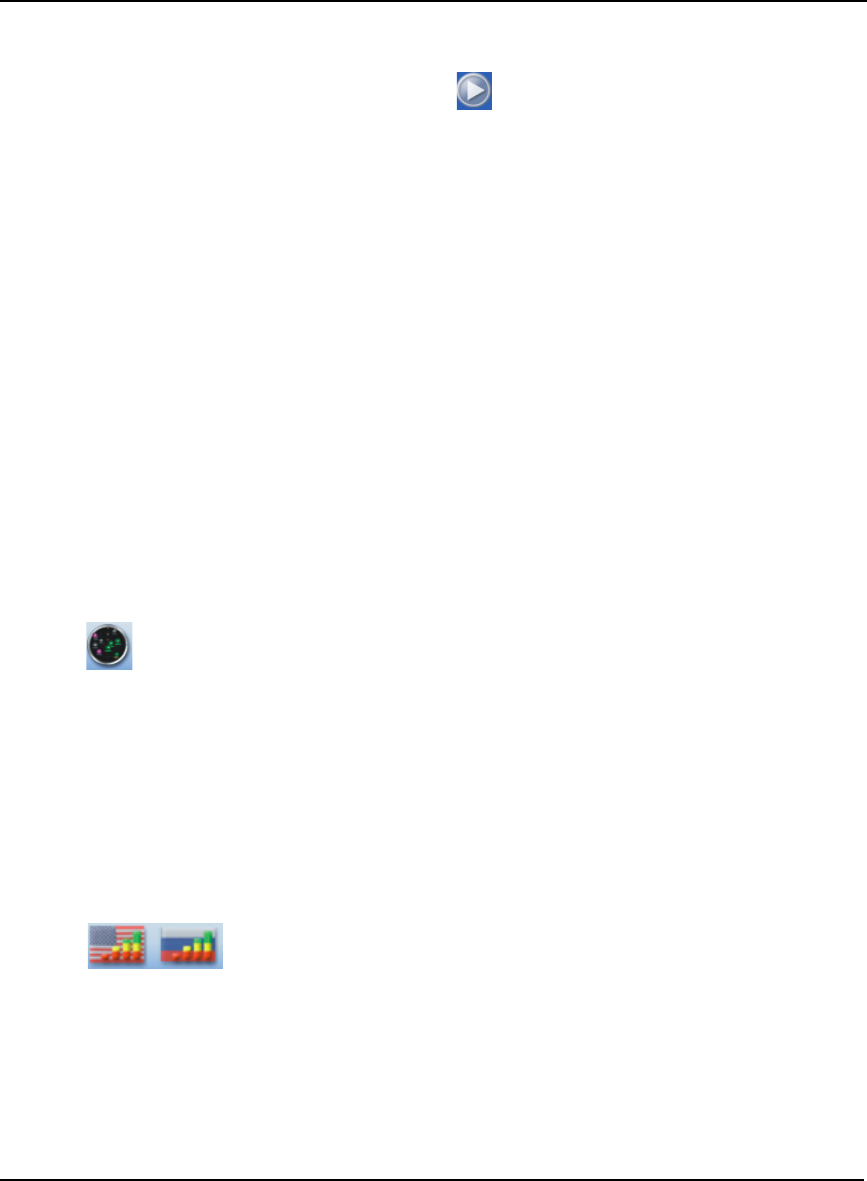
40 SMART-AG User Manual Rev 3C
Chapter 4 PC Utilities
horizon to directly overhead, respectively. The azimuth is mapped on a compass relative to true
North. The colored rings indicate the lowest elevation cut-off angles at which satellites are
tracked and can be changed or viewed via the button.
Each of the satellites being tracked are represented with icons according to their satellite system
as follows:
• Circular for GPS
• Square for GLONASS
• Hexagon for SBAS
There are also information icons and values at the bottom of the window:
• The number of GPS/GLONASS satellites used in the solution verses the number
being tracked. For example, 0/5 next to the Russian flag means that while the
receiver is tracking 5 GLONASS satellites, none are currently used in the position
solution.
• Satellite PRN number Azimuth and elevation angle values
• Signal to Noise Ratio (SNR) value and indicator
The PRN of the satellite is displayed on the icon and color-coding is used to indicate the status of
the satellite or the tracking channel. Click on a satellite to display information on that satellite.
When a valid position has been achieved, dilution of precision (DOP) values can be viewed in the
DOP window.
Open this window by selecting Constellation Window from the View menu or by clicking
its button in the Window Toolbar.
•Channel Tracking Status Window: The Channel Tracking Status window displays key
information for each of the receiver's processing channels, including the PRN of the satellite
being tracked by that channel, the Signal to Noise Ratio, Pseudorange measurements, Doppler
values, Residuals measurements and Lock Time from the satellite.
The TRACKSTAT log provides the data for many of the fields listed in this window. The number
of channels displayed depends on the model of your receiver and the bars are color-keyed to indi-
cate the frequency type on the channel.
Open these windows by selecting Tracking Status Window GPS/GLONASS
from the View menu or by selecting the American and Russian flag buttons in the Window Tool-
bar.
•Position Window: The Position window displays:
• The receiver's latitude, longitude and height
• The Solution Type, also known as Position Type
• The solution or differential age (number of seconds the current solution has been
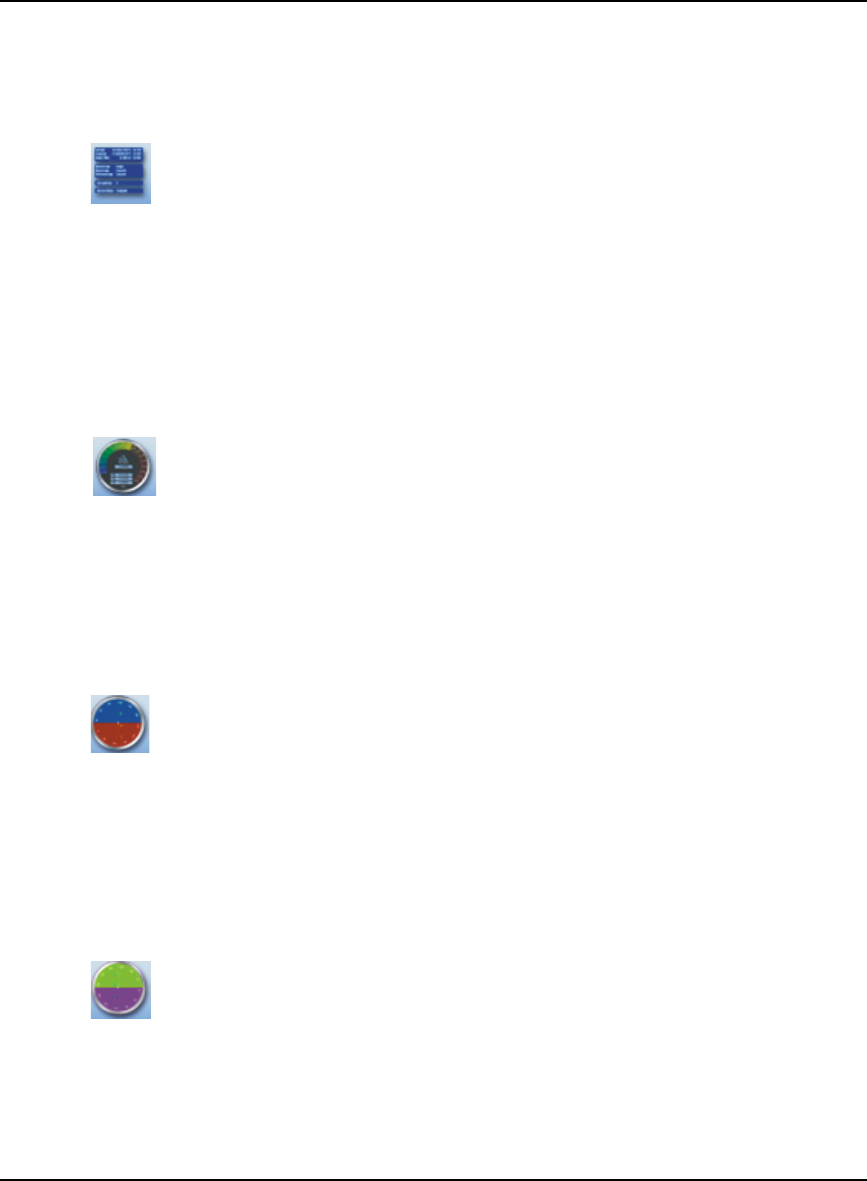
PC Utilities Chapter 4
SMART-AG User Manual Rev 3C 41
valid). Normally this represents the latency in the correction data.
• The number of satellites used in the solution
• The Solution Status
• The receiver's date and time (GMT and local)
Open this window by selecting Position Window from the View menu or its button in
the Window Toolbar.
Right-click in the Position window to that enables you to set the PC clock to the receiver's time,
change the font used to display the position data or set the units through the Options dialog box.
•Velocity Window: The Velocity window displays vertical and horizontal speed and direction.The
numeric displays within the dial, and the velocity values below the dial, show the vector velocity
as well as the vertical, North, and East velocity components. If necessary, the scale in the dial
increases so that you have room to accelerate.
Open this window by selecting Velocity Window from the View menu or its button in
the Window Toolbar.
• Compass Window: The direction dial is a compass that displays the direction of motion of the
receiver over ground and its elevation (both in degrees). The white arrow indicates the elevation
value on the vertical scale down the centre of the dial. The black arrow on the outer rim of the dial
indicates the Track Over Ground value. Both the track over ground and elevation angles are also
shown at the bottom of the Compass window.
Open this window by selecting Compass Window from the View menu or its button in
the Window Toolbar.
•INS Window: If applicable, please refer to your SPAN User Manual for more on INS.
Information in the INS Position, Velocity, Attitude window is only available if you have an INS-
capable receiver model.
The dial is a graphical display of the Roll, Pitch and Azimuth values indicated by an arrow on
each axis.
Open this window by selecting INS Window from the View menu or its button in the
Window Toolbar.
•Plan Window: The Plan window provides real-time graphic plotting of the current position of
each connected device. The latitude and longitude shown at the bottom of the window indicate
the receiver's reference position, which is used as the center of the grid system. The receiver's
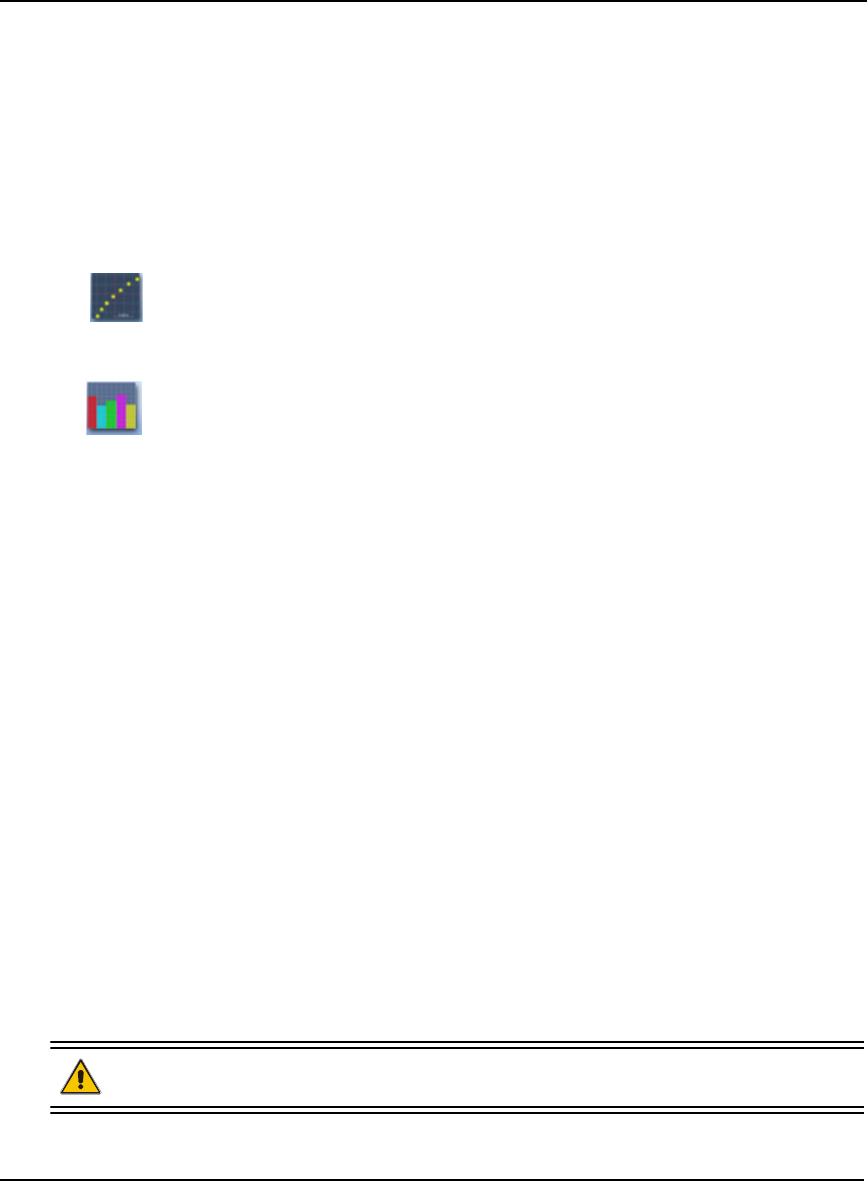
42 SMART-AG User Manual Rev 3C
Chapter 4 PC Utilities
subsequent positions, shown with a yellow + marker, are given relative to this initial starting
point. The current position is shown with a red + marker.
The buttons at the top of the window provide options for controlling the plan display:
• Zoom in or out of the Plan window
• View all configurations or center in on the active configuration
• Select a grid or circular display
• Show/Hide history
• Delete all history (no undo)
To open this window, select Plan Window from the View menu or select its button in the
Window Toolbar.
• Doppler Window: A value representing the uncertainty of the position solution based on
the current satellite geometry. The lower the value, the greater the confidence in the solution.
In the DOP window, DOP is displayed in the following forms:
• GDOP Geometric DOP: Uncertainty of all parameters (latitude,
longitude, height, clock offset)
• PDOP Position DOP: Uncertainty of the three-dimensional
parameters (latitude, longitude, height)
• HDOP Horizontal DOP: Uncertainty of the two-dimensional
parameters (latitude, longitude)
• VDOP Vertical DOP: Uncertainty of the height
• TDOP Time DOP: Uncertainty of the clock offset
•Console Window: This window allows the user to communicate directly to the receiver through
the serial port. It is essentially a terminal emulator with added receiver functionality. Commands
can be issued to the receiver via the command editor (at the bottom of the window) and sent by
pressing the Enter button or simply pressing <Enter> on the keyboard. The command editor has
recall functionality similar to DosKey whereby pressing the up arrow on the keyboard will move
backward through the previously issued commands and pressing the down arrow will move
forward through the previously issued commands. This allows the user to scroll through
previously issued commands and then press the <Enter> key to issue that command again.
Feedback from the receiver is displayed in the ASCII Messages or Console window depending on
the format of the message (ASCII or Abbreviated ASCII respectively).
WARNING!: Ensure all other windows are closed in CDU when entering the
SAVECONFIG command in the Console window.
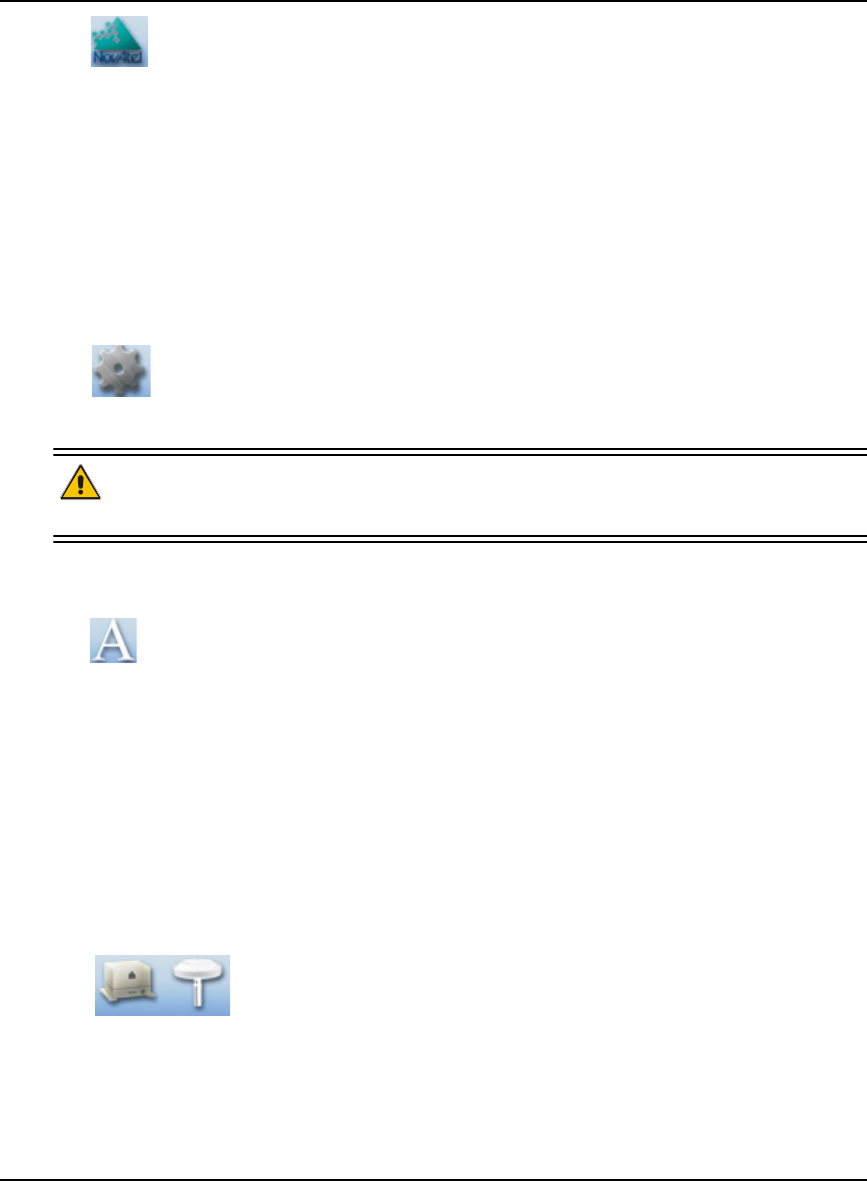
PC Utilities Chapter 4
SMART-AG User Manual Rev 3C 43
This window automatically opens when CDU is first connected to a receiver. To bring
the window to the front, select Console Window from the View menu or click its button in the
Window Toolbar.
•Logging Control Window: The Logging Control window provides a graphical interface for:
• Initiating data logging to a file
• Initiating logging to the receiver's serial ports
• Specifying a time window for data logging
• Stopping logging
• Editing log settings
To display the Logging Control window, select Logging Control Window from the
Tools menu or select its button in the Window Toolbar.
WARNING!: Ensure the Power Settings on your PC are not set to go into Hibernate or
Standby modes. Data will be lost if one of these modes occurs during a
logging session. Refer to CDU’s online Help for more information.
•ASCII Messages Window: This window displays ASCII formatted NovAtel logs.
To display the ASCII Messages window, select ASCII Messages Window from the View
menu or select its button in the Window Toolbar.
•Wizards: There are two wizards available: RTK and SPAN.
The Real Time Kinematic (RTK) wizard takes you through the steps needed to set up your RTK
system. You must have an RTK-capable receiver model or the wizard does not continue past its
opening page.
The SPAN wizard takes you through the steps needed to set up your Synchronized Position
Attitude Navigation (SPAN) system. You must have a SPAN-capable receiver model, or the
wizard does not continue past its opening page. The SPAN wizard can help with the alignment or
calibration of a SPAN system.
To display a wizard window, if you have the necessary receiver model, select
SPAN Wizard or RTK Wizard from the Tools menu or select one of their buttons in the Window
Toolbar.
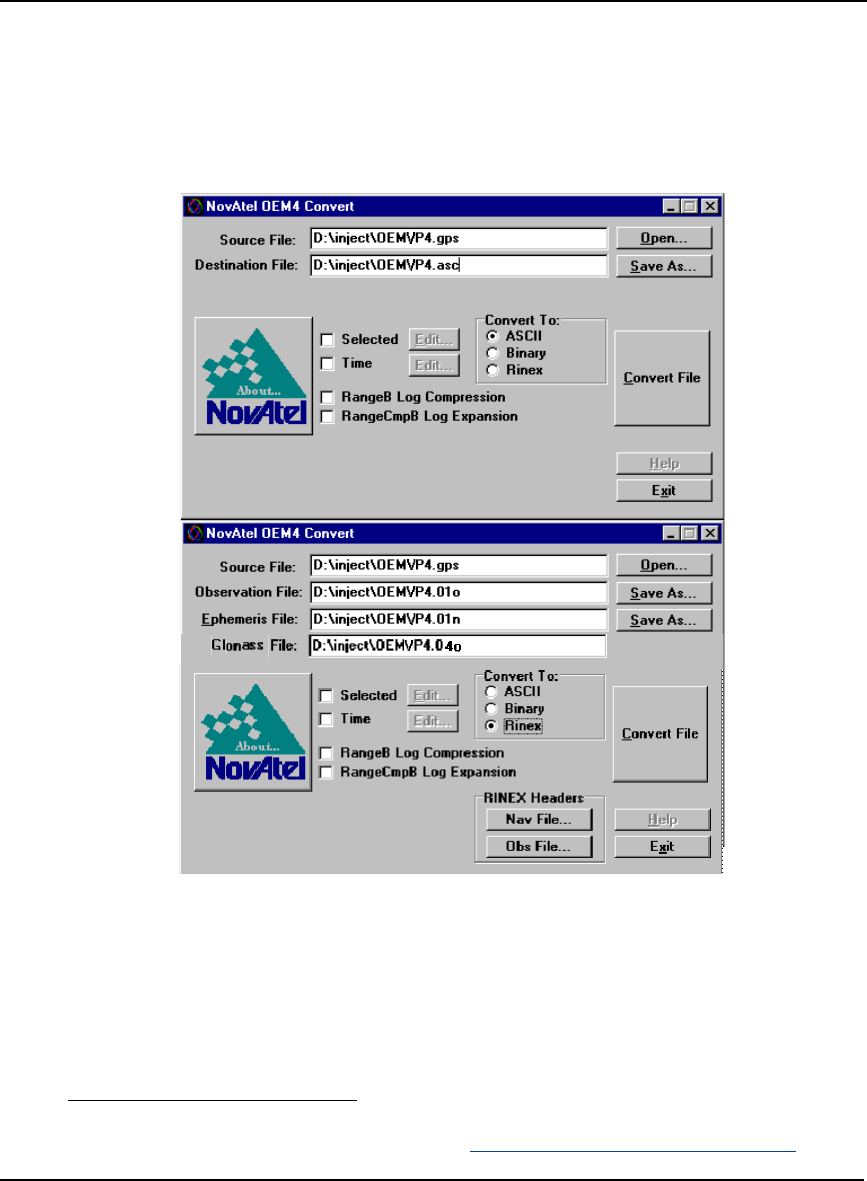
44 SMART-AG User Manual Rev 3C
Chapter 4 PC Utilities
4.3 Convert4
Convert4 is a 32-bit Windows application and is shown in Figure 9. Convert4 will accept GPS file
formats and convert them to ASCII, Binary or Rinex format. The application also allows the user to
screen out particular logs by selecting the desired logs from the list of available logs. This feature is
useful for screening particular logs out of large data files in either ASCII or Binary formats.
Figure 9: Convert4 Screen Examples
4.3.1 Rinex Format
The Receiver-Independent Exchange (RINEX1) format is a broadly-accepted, receiver-independent
format for storing GPS data. It features a non-proprietary ASCII file format that can be used to
combine or process data generated by receivers made by different manufacturers.
1. For further information on RINEX Version 2.10 file descriptions, you may wish to consult the
U.S. National Geodetic Survey Web site at http://www.ngs.noaa.gov/CORS/Rinex2.html.

PC Utilities Chapter 4
SMART-AG User Manual Rev 3C 45
The Convert4 utility can be used to produce RINEX files from NovAtel receiver data files.
Although RINEX is intended to be a receiver-independent format, there are many optional
records and fields. Please keep this in mind when combining NovAtel and non-NovAtel
RINEX data.
When converting to RINEX, two files are produced - a RINEX observation file and a RINEX
navigation file. A third GLONASS file is produced if the data contains GLONASS observations. The
default names of these files conform to the RINEX Version 2.10 recommended naming convention of
ssssdddf.yyt, where:
ssss 4 character station name - Convert4 uses the first four characters of the <infile>
parameter as the station ID
ddd day of year
f file sequence number within the day - Convert4 sets this to zero
t file type: o for the observation and n for the navigation file
Selecting the RINEX field, see Figure 9, Convert4 Screen Examples on Page 44, in the Convert4 To
section causes the:
1. Destination File: field to be replaced by the Observation File: and Ephemeris File: fields. Note
that Observation File refers to the RINEX OBS file while Ephemeris File refers to the RINEX
NAV file.
2. RINEX Headers buttons to appear allowing you to supply additional information that appears in
the header records of the RINEX output files (for example, Company Name, Marker Name and
Marker Number).
For best results, the NovAtel receiver input data file should contain the logs as in Table 6, NovAtel
Logs for Rinex Conversion on Page 46.
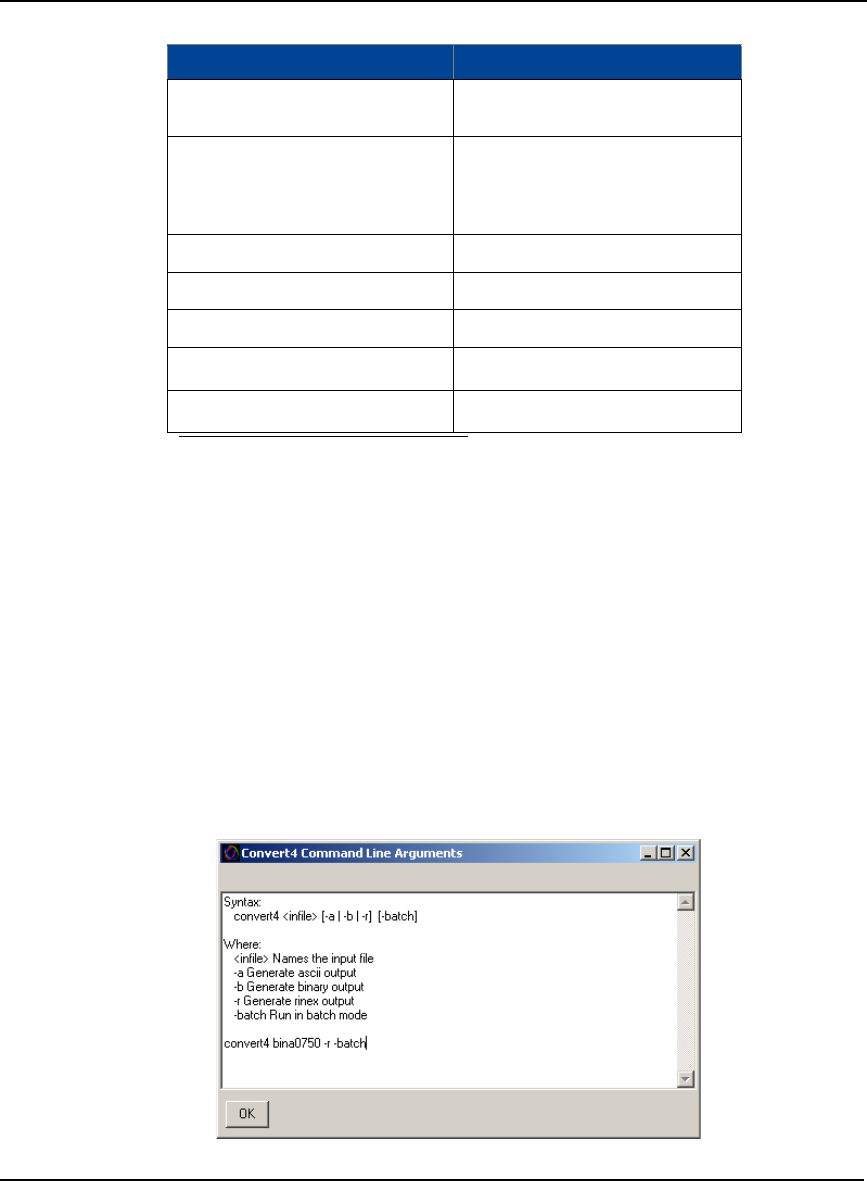
46 SMART-AG User Manual Rev 3C
Chapter 4 PC Utilities
Table 6: NovAtel Logs for Rinex Conversion
4.3.2 Convert4 Command Line Switches
Convert4 supports several command-line switches to facilitate batch processing. To access its
Command Line Arguments window, open a command prompt window (select Accessories |
Command Prompt from the Start menu). Change directory (cd) to the directory on your hard drive that
Convert4 is stored. Type the following: convert4 -h
The Convert4 Command Line Arguments window appears as shown in Figure 10.
Figure 10: Convert4 Command Line Arguments
NovAtel OEMV Family Log Recommended Trigger
RANGEA/B, or
RANGECMPA/B
ontime 15
BESTPOSA/B, or
PSRPOSA/B, or
RTKPOSA/B, or
MARKPOSA/B
once
IONUTCA/B onchanged
RAWEPHEMA/B onchanged
GLORAWEPHEMA/B onchanged
VERSIONA/B a
a. Information from this log overrides data entered into the Receiver
Number, Type and Version fields using the OBS file button of the
RINEX Headers section, see Figure 9 on Page 44.
once
SITEDEFA/B b
b. Available on DL-V3 receivers, refer to the DL-V3 User
Manual. Information from this log overrides data entered into
the Marker Name, Marker Number, Antenna Type and
Antenna Delta H fields using the OBS file button of the
RINEX Headers section.
once

PC Utilities Chapter 4
SMART-AG User Manual Rev 3C 47
The name of the output file is the same as the input file when converting to ASCII or binary formats.
The file extension, however, is altered to indicate the format of the data:
*.asc for ASCII
*.bin for binary
When converting to RINEX, the output files are named according to the RINEX Version 2.10 naming
convention, see Section 4.3.1, Rinex Format on Page 44.
The -batch arguments suppress the window display and convert the specified file automatically.
When converting to RINEX in batch mode, the navigation and observation file header
information from the most recent interactive Convert4 session is used.
4.4 Firmware Upgrades
The receiver stores its program firmware in non-volatile memory, which allows you to perform
firmware upgrades without having to return the receiver to the distributor. New firmware can be
transferred to the receiver through COM1, and the unit will immediately be ready for operation at a
higher level of performance.
The first step in upgrading your receiver is to contact your local NovAtel dealer. Your dealer will
assist you in selecting the best upgrade option that suits your specific GPS needs. If your needs are
still unresolved after seeing your dealer then you can contact NovAtel directly through any of the
methods described in the Customer Service section, Page 16, at the beginning of this manual.
When you call, have your receiver model number, serial number, and program revision level
available. This information can be found by issuing the LOG VERSION command at the port prompt.
After establishing which new model/revision level would best suit your needs, and having described
the terms and conditions, you will be issued an authorization code (auth-code). The auth-code is
required to unlock the new features according to your authorized upgrade model type.
To upgrade to a higher performance model at the same firmware revision level (for example,
upgrading from a SMART-AG to a SMART-AG-ER on firmware version 3.600), you can use the
AUTH command with the issued auth-code.
If you are upgrading to a higher firmware revision level (for example, upgrading a SMART-AG- PVT
firmware version 3.600 to SMART-AG-RT-20 firmware version 3.700), you will need to transfer new
program firmware to the OEMV family receiver using the WinLoad utility program. As WinLoad and
the upgrade file are generally provided in a compressed file format, you will also be given a
decompression password. WinLoad and the upgrade files can be found on NovAtel's FTP site at http:/
/www.novatel.com, or can be sent to you by e-mail.
Your local NovAtel dealer will provide you with all the information that you require to upgrade your
receiver.
4.4.1 Upgrading Using the AUTH Command
The AUTH command is a special input command which authorizes the enabling or unlocking of the

48 SMART-AG User Manual Rev 3C
Chapter 4 PC Utilities
various model features. Use this command when upgrading to a higher performance OEMV family
model available within the same revision level as your current model (for example, upgrading from a
SMART-AG to a SMART-AG-ER on firmware version 3.600). This command only functions in
conjunction with a valid auth-code assigned by Customer Service.
The upgrade can be performed directly from CDU's Command Line Screen, or from any other
communications program. The procedure is as follows:
1. Power-up the OEMV family receiver and establish communications over a serial port (see
Chapter 4 Operation in the OEMV Family Installation and Operation User Manual
2. Issue the LOG VERSION command to verify the current firmware model number, revision level,
and serial number.
3. Issue the AUTH command, followed by the auth-code and model type. The syntax is as follows:
Syntax:
auth auth-code
where auth is a special command which allows program model upgrades
auth-code is the upgrade authorization code, expressed as hhhh,hhhh,hhhh,hhhh,hhhh,model# where
the h characters are an ASCII hexadecimal code, and the model# would be ASCII text
Example:
auth 17cb,29af,3d74,01ec,fd34,l1smrter
Once the AUTH command has been executed, the OEMV family receiver will reboot itself. Issuing
the LOG VERSION command will confirm the new upgrade model type and version number.
If communicating using CDU, the communication path needs to be closed and re-opened using the
Device menu.
4.4.2 Updating Using the WinLoad Utility
WinLoad is required (instead of the AUTH command) when upgrading previously released firmware
with a newer version of program and model firmware (for example, upgrading a SMART-AG- PVT
firmware version 3.600 to SMART-AG-RT-20 firmware version 3.700). WinLoad is a Windows utility
program designed to facilitate program and model upgrades. Once WinLoad is installed and running,
it will allow you to select a host PC serial port, bit rate, directory path, and file name of the new
program firmware to be transferred to the OEMV family receiver via its COM1 or COM2 port. The
port chosen must have an RS-232 interface to the PC.
Transferring Firmware Files
To proceed with your program upgrade, you must first acquire the latest firmware revision. You will
need a file with a name such as OEMXXXX.EXE (where XXXX is the firmware revision level). This
file is available from NovAtel's FTP site (http://www.novatel.com), or via e-mail
(support@novatel.ca). If transferring is not possible, the file can be mailed to you on CD. For more
information on how to contact NovAtel Customer Service please see Page 16 at the beginning of this
manual.
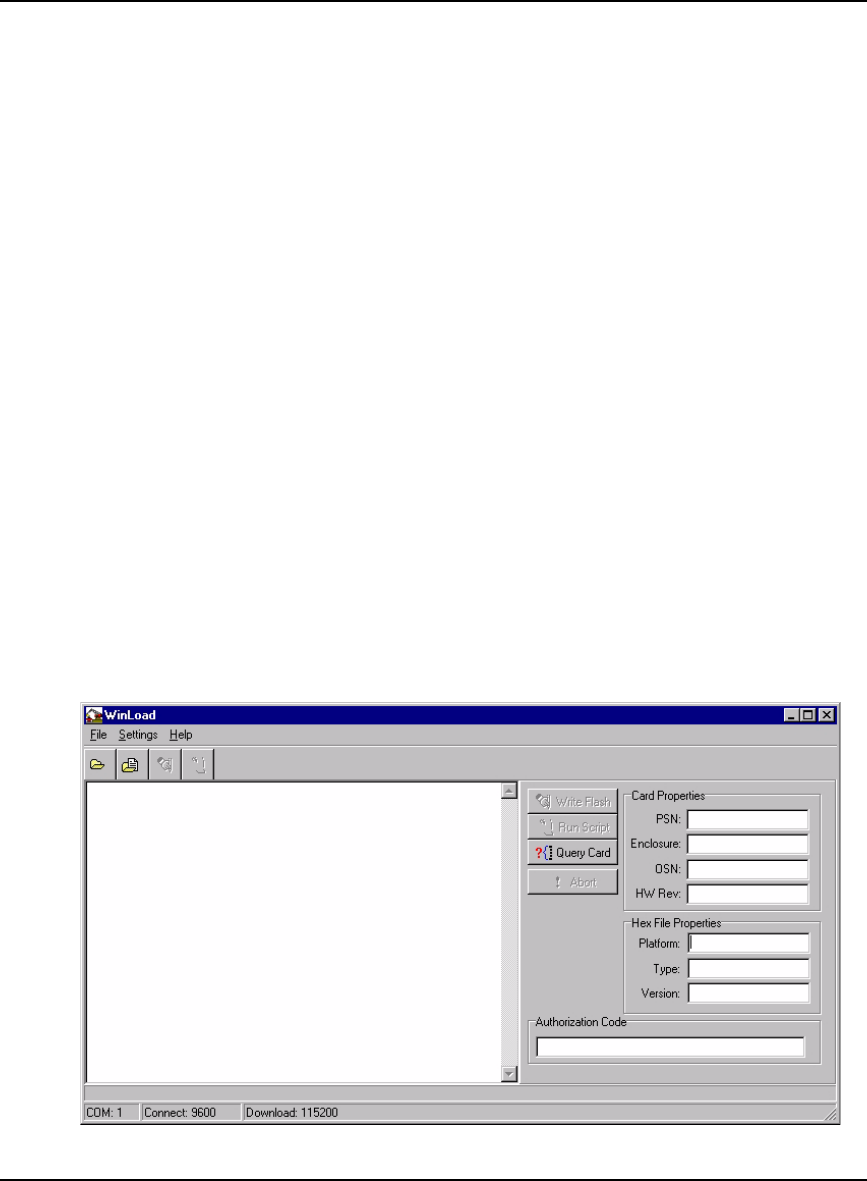
PC Utilities Chapter 4
SMART-AG User Manual Rev 3C 49
You will need at least 1 MB of available space on your hard drive. For convenience, you may wish to
copy this file to a GPS sub-directory (for example, C:\GPS\LOADER).
The file is available in a compressed format with password protection; Customer Service will provide
you with the required password. After copying the file to your computer, it must be decompressed.
The syntax for decompression is as follows:
Syntax:
[filename] [password]
where filename is the name of the compressed file (but not including the .EXE extension) and
password is the password required to allow decompression
Example:
oem1001 12345678
A windows-based dialog box is provided for password entry.
The self-extracting archive will then generate the following files:
WinLoad.exe WinLoad utility program
HowTo.txt Instructions on how to use the WinLoad utility
WhatsNew.txt Information on the changes made in the firmware since the last revision
XXXX.hex Firmware version upgrade file, where XXXX = program version level (for
example, 1001.hex)
Using the WinLoad Utility
WinLoad is a windows based program used to download firmware to OEMV family cards. The main
screen is shown in Figure 11 on Page 49.
Figure 11: Main Screen of WinLoad
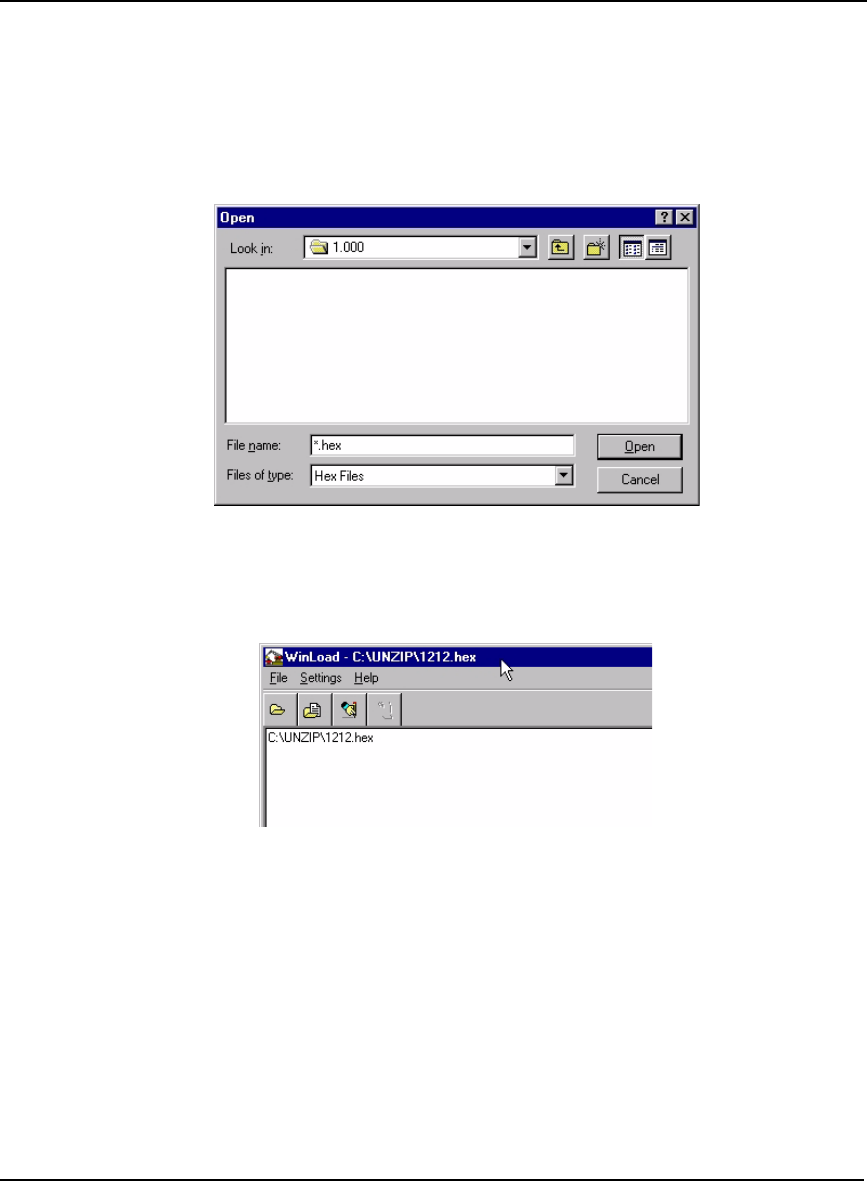
50 SMART-AG User Manual Rev 3C
Chapter 4 PC Utilities
If you are running WinLoad for the first time you will need to make sure the file and communications
settings are correct.
Open a File to Download
From the file menu choose Open. Use the Open dialog to browse for your file, see Figure 12,
WinLoad’s Open Dialog on Page 50.
Figure 12: WinLoad’s Open Dialog
Once you have selected your file, the name should appear in the main display area and in the title bar,
see Figure 13 below.
Figure 13: Open File in WinLoad
Communications Settings
To set the communications port and baud rate, select COM Settings from the Settings menu. Choose
the port on your PC from the Com Port dropdown list and the baud rate from the Download Baudrate
dropdown list. The baud rate should be as high as possible (the default of 115200 is preferred).
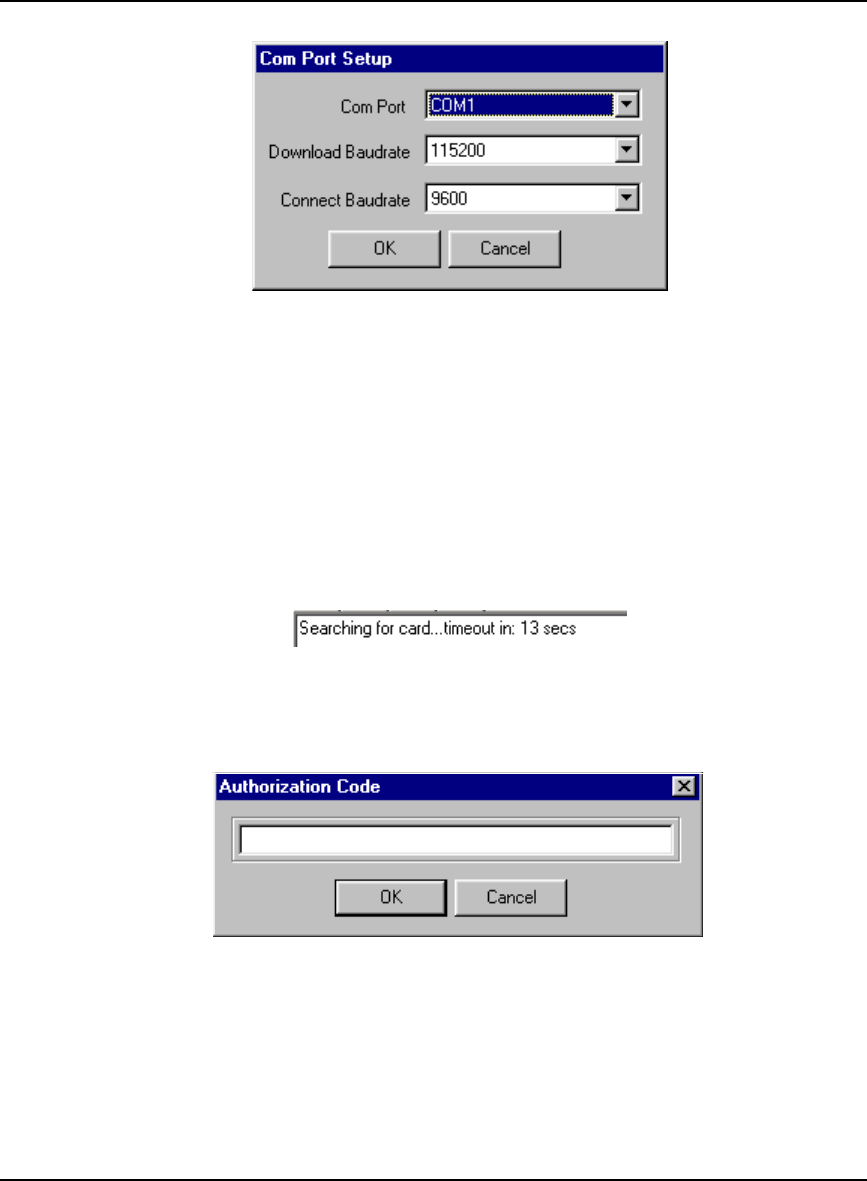
PC Utilities Chapter 4
SMART-AG User Manual Rev 3C 51
Figure 14: COM Port Setup
Downloading firmware
To download firmware follow these steps:
1. Set up the communications port as described in Communications Settings above.
2. Select the file to download, see Open a File to Download on Page 50.
3. Make sure the file path and file name are displayed in main display area, see Figure 13, Open File
in WinLoad on Page 50.
4. Click on the Write Flash button to download the firmware.
5. Power down and then power up the receiver when “Searching for card” appears in the main dis-
play, see Figure 15.
Figure 15: Searching for Card
6. Enter the authorization code and select OK when the Authorization Code dialog opens, see
Figure 16.
Figure 16: Authorization Code Dialog
The receiver should finish downloading and reset. The process is complete when “Done.” is
displayed in the main display area, see Figure 17.

52 SMART-AG User Manual Rev 3C
Chapter 4 PC Utilities
Figure 17: Upgrade Process Complete
7. Close WinLoad.
This completes the procedure required to upgrade an OEMV family receiver.
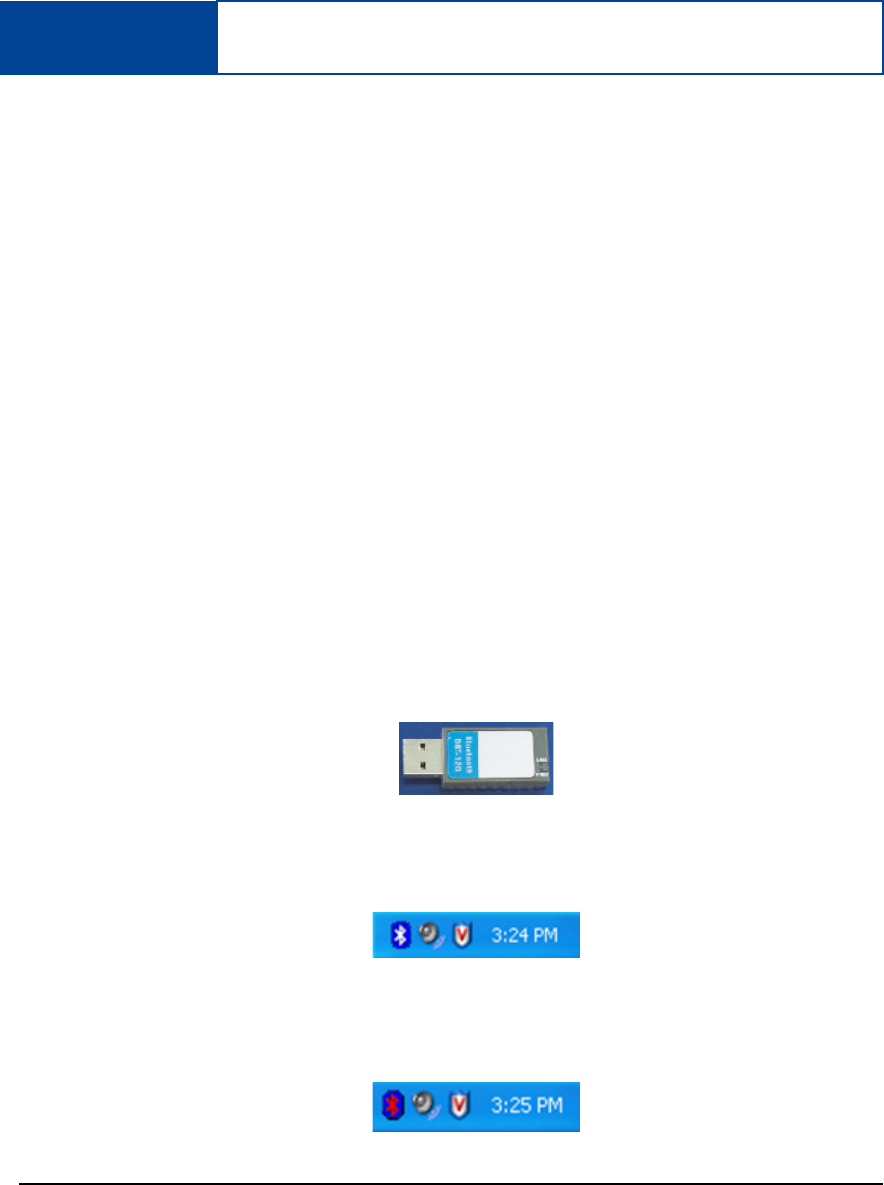
SMART-AG User Manual Rev 3C 53
Chapter 5 Bluetooth® Configuration
Bluetooth is a wireless radio communication standard designed for use over short ranges (within
10 m). This chapter describes how to:
• Enable Bluetooth on the SMART-AG receiver
• Set up a PC/laptop with a Bluetooth adaptor
• Locate a Bluetooth-enabled SMART-AG in range
• Communicate with the SMART-AG using Bluetooth
• Stop communicating with the SMART-AG using Bluetooth
5.1 Bluetooth on the SMART-AG Receiver
Bluetooth is automatically configured on the SMART-AG receiver’s COM3 port. Once your PC/
laptop is configured for Bluetooth operation, see the next section, use HyperTerminal or CDU to
communicate through COM3.
5.2 Set Up a PC/Laptop with a Bluetooth Adaptor
If your PC/laptop is already Bluetooth-equipped and ready, proceed to Section 5.3 on Page 54
1. With the PC/laptop powered on, install the driver(s) from the disc that came with your Bluetooth
adapter.
2. Connect the Bluetooth adapter. An example of a D-Link USB adapter is shown in Figure 18:
Figure 18: Bluetooth Adapter for PC/Laptop
Within two minutes of connecting the USB adapter, the Bluetooth icon appears in the Windows
task bar as shown in Figure 19 on page 53.
Figure 19: Bluetooth Standby: White
Continue on to the next section when you see the white Bluetooth icon. If the Bluetooth Icon is
red, see Figure 20 below, then the Bluetooth installation is on your PC/laptop is incorrect and you
should return to Step #1.
Figure 20: Bluetooth Error: Red
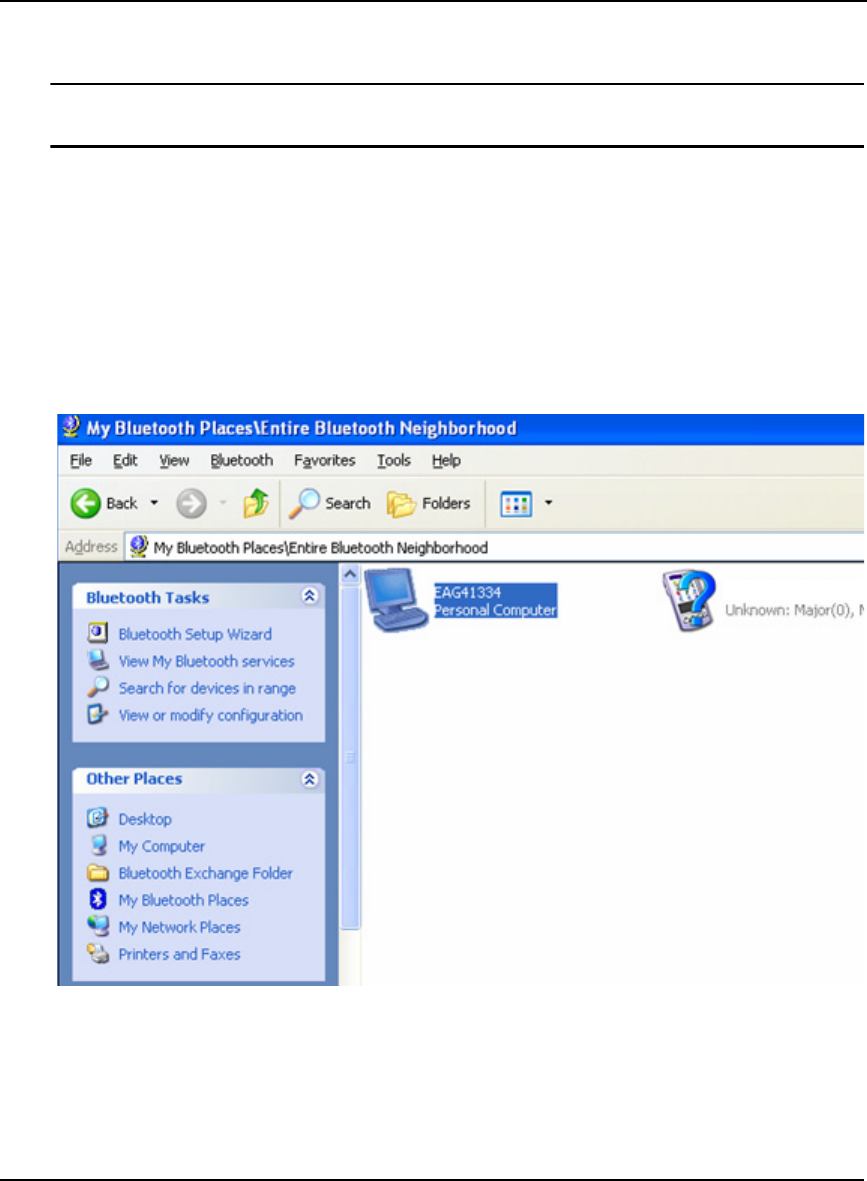
54 SMART-AG User Manual Rev 3C
Chapter 5 Bluetooth® Configuration
5.3 Locate a Bluetooth-Enabled SMART-AG in Range
Ensure that your PC/laptop is equipped with a built in, or external-plug-in, Bluetooth adapter
and is already configured with the appropriate Bluetooth driver.
1. Power on the SMART-AG.
2. Double-click on the Bluetooth icon in the task bar, see Figure 19 on page 53, or select Programs |
My Bluetooth Places from the Start menu in Windows. The My Bluetooth Places window opens.
3. Click on the Search for devices in range option from the Bluetooth Tasks side bar on the left of
the My Bluetooth Places window. Bluetooth-enabled devices within range appear in the Entire
Bluetooth Neighborhood folder, see Figure 21 below.
Figure 21: My Bluetooth Places Window
SMART-AG
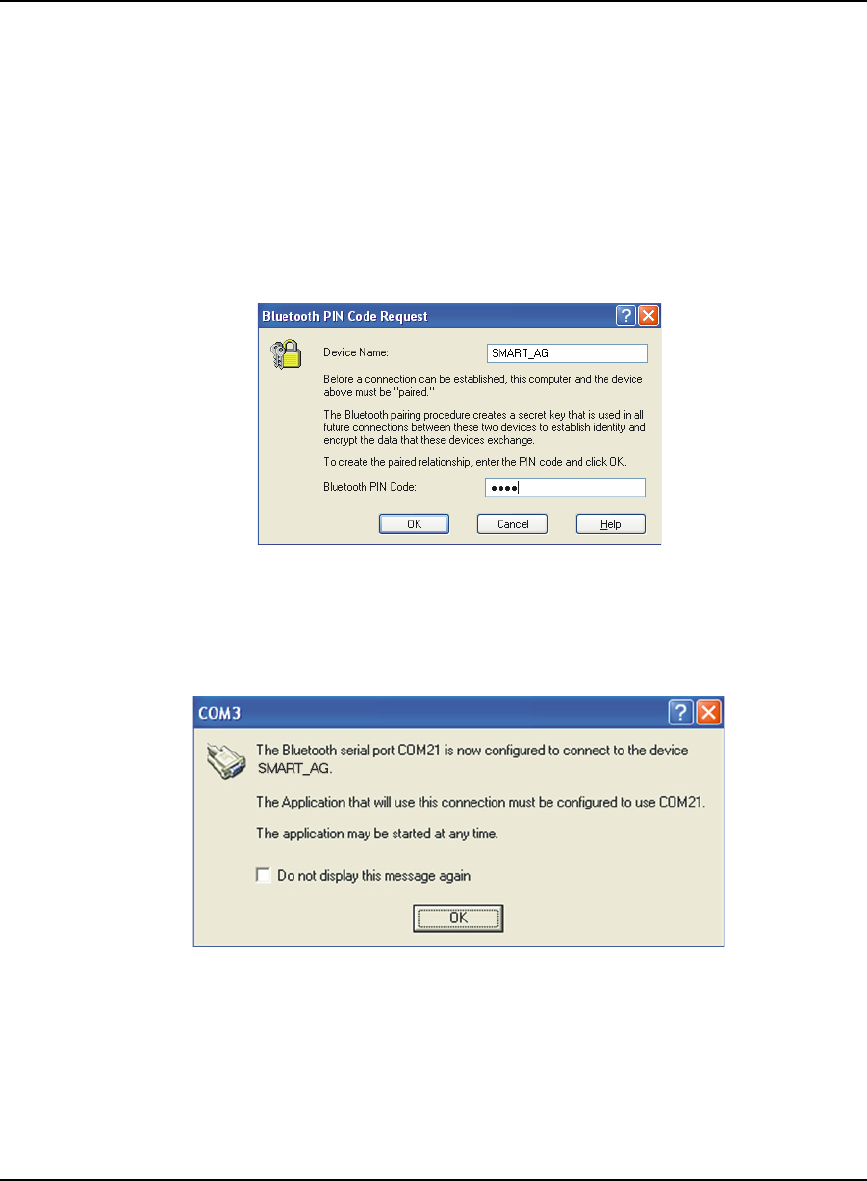
Bluetooth® Configuration Chapter 5
SMART-AG User Manual Rev 3C 55
5.4 Communicate with the SMART-AG Using Bluetooth
1. Double-click on the SMART-AG device icon in the Entire Bluetooth Neighborhood window, see
Figure 21 on page 54. The PC/laptop searches for available services. If Bluetooth is working
properly, COM port service appears.
2. Double-click on the COM3 icon. In order to use the serial COM port, the SMART-AG must be
paired with the PC/laptop to use the COM3 port. The Bluetooth PIN Code Request dialog
appears.
3. Enter the SMART-AG default pin number of four zeroes (0000), see Figure 22 below:
Figure 22: Bluetooth PIN Code Request
If the code is correct, a new COM dialog opens to show which PC/laptop COM port has been
assigned to the Bluetooth link. For example, in Figure 23, the PC/laptop port is COM21.
Figure 23: PC/Laptop COM3 Port Assignment
4. Type the following into the command prompt to test if the connection has worked:
CPTERM /C##
Where ## is the PC/laptop COM port number assigned in Step #3, see Figure 23 on page 55.
5. Type the following VERSION log request into the command prompt to ensure that the connection
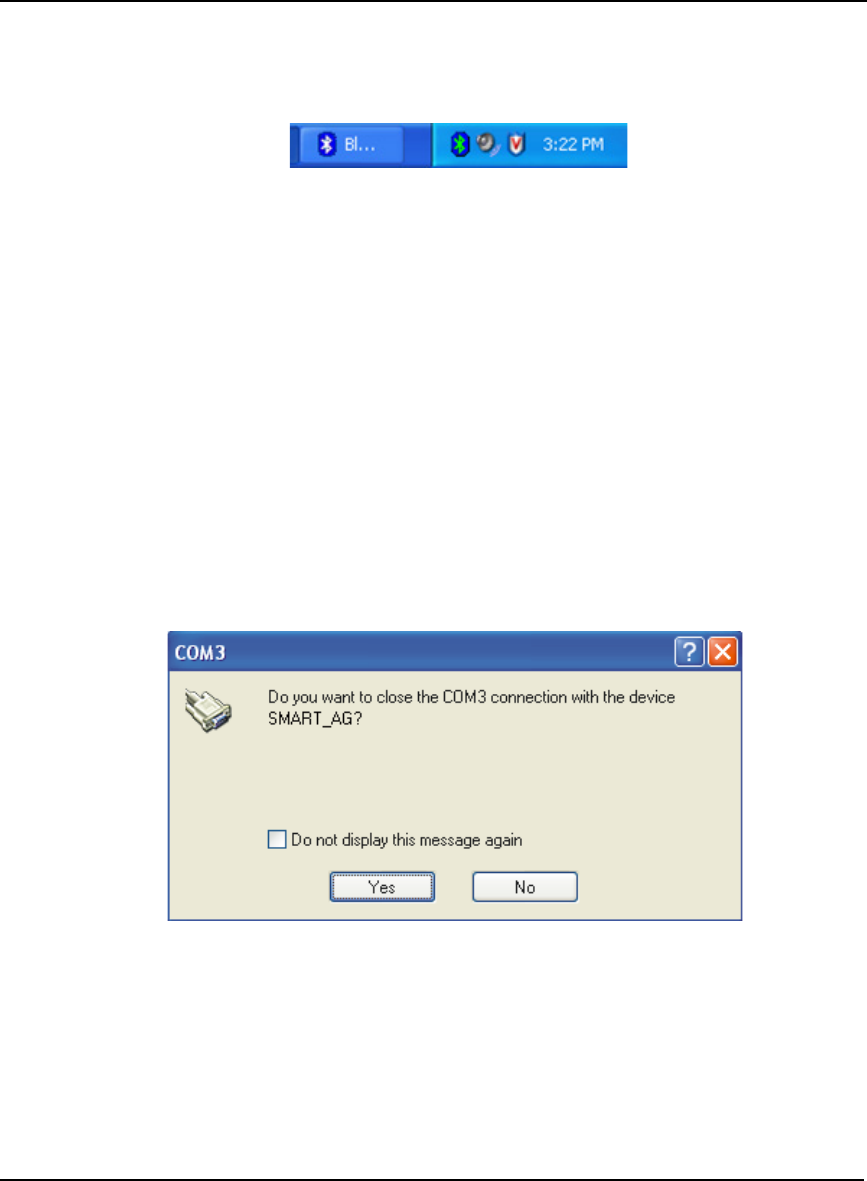
56 SMART-AG User Manual Rev 3C
Chapter 5 Bluetooth® Configuration
works:
LOG VERSION
The Bluetooth icon in the task bar turns green when it is connected, see Figure 24 below.
Figure 24: Bluetooth Connected: Green
5.5 Stop Communicating with the SMART-AG Using Bluetooth
1. Double-click on the Bluetooth icon in the task bar, see Figure 19 on page 53, or select Programs |
My Bluetooth Places from the Start menu in Windows. The My Bluetooth Places window opens.
2. Click on the Search for devices in range option from the Bluetooth Tasks side bar on the left of
the My Bluetooth Places window. Bluetooth-enabled devices within range appear in the Entire
Bluetooth Neighborhood folder, see Figure 21 on page 54.
3. Double-click on the SMART-AG device icon in the Entire Bluetooth Neighborhood window, see
Figure 21 on page 54. The PC/laptop searches for available services. If Bluetooth is working
properly, COM port service appears.
4. Right-click on the COM3 icon and select the Disconnect Serial COM Port option. A COM3
dialog box appears, see Figure 25 on page 56, to confirm that you want to disconnect.
Figure 25: COM3 Disconnect?
5. Click on the Yes button in the COM3 dialog and the SMART-AG’s Bluetooth is unpaired from
your PC/laptop. When the SMART-AG and PC/laptop Bluetooth are unpaired, the Bluetooth icon
in the task bar appears white, see Figure 19 on page 53.

57 SMART-AG User Manual Rev 3C
Appendix A Technical Specifications
A.1 SMART-AG Receiver Performance
PERFORMANCE
Channel Configuration
14 GPS L1
12 GLONASS L1 (optional)
2 SBASa
a. Satellite Based Augmentation Systems (SBAS) include WAAS (North America), EGNOS (Europe)
and MSAS (Japan).
Horizontal Position Accuracy (RMS)b
b. Typical values. Performance specifications subject to GPS system characteristics, US DOD
operational degradation, ionospheric and tropospheric conditions, satellite geometry, baseline
length, multipath effects and the presence of intentional or unintentional interference sources.
Export licensing restricts operation to a maximum velocity of 515 metres per second.
Absolute P2Pc
Autonomous 1.2 m 25 cm
SBASa0.8 m 18 cm
DGPS 0.4 m 23 cm
RT-20d (optional) 0.2 m 2 cm
c. Typical values with GL1DE enabled. “Pass to pass” or time relative position error is the one
dimensional horizontal (cross track) position error after 15 minutes or less after an initial
convergence of at least 10 minutes.
d. Expected accuracy after convergence. RT-20 is independent of GL1DE.
Measurement Precision L1 C/A Code 18 cm RMS
L1 Carrier Phase 1.5 mm RMS
Maximum Data Ratee
e. Model specific.
Measurements 20 Hz
Position 20 Hz
Time to First Fix Cold Startf65 s
Hot Startg35 s
f. Typical value. No almanac or ephemerides and no approximate position or time.
g. Typical value. Almanac and recent ephemerides saved and approximate time entered. For more
information, Please refer to the “SETAPPROXTIME” command in the OEMV Family Firmware
Reference Manual found on our Web site at http://www.novatel.com/support/docupdates.htm.
Signal Reacquisition L1 0.5 s (typical)
Time Accuracy 20 ns RMS
Velocity Accuracyb0.03 m/s RMS

58 SMART-AG User Manual Rev 3C
A.2 SMART-AG Specifications
INPUT/OUTPUT CONNECTORS
SMART-AG COM/PWR +8 to +36 V DC at 2.5 W (typical while logging) a
For the cable pinouts and drawings, see Section A.2.1, SMART-AG
Power/Communications Development Kit Cable starting on Page 60
a. When tracking GPS satellites.
Serial Com Ports RS-232 F Compliant (Rx and Tx signals only)
CAN SAE J1939/ ISO 11783/ ISO 11898 Compliant
Emulated Radar Output High= Supply Voltage -0.5V Minimum
Low= 0.5V Minimum
Load= 3K Ohm Minimum
PPS Output 3.3 V CMOS Logic Compatible
MKI Input 3.3V CMOS Logic/ 5V Tolerant
INPUT/ OUTPUT CONNECTOR PROTECTION
Electrical Conducted/
Coupled disturbance
tolerance
ISO 7637:2002 (Survives all pulse types)
LED INDICATORS
More details can also be found in Section 2.2.2, Status Indicators starting on Page 25
PHYSICAL
Size 155.3 x 66.8 x φ155 mm b
b. φ denotes diameter, here and in the Dimensions graphic on Page 59.
Weight 495 g maximum
ENVIRONMENTAL
Operating Temperature -40°C to +75°C
Storage Temperature -55°C to +90°C
Humidity Not to exceed 95% non-condensing
Immersion MIL-STD-810F Method 512.4 Procedure 1
Vibration c
c. See also the Notice section of this manual starting on Page 13.
Random MIL-STD-810F Method 514.5 C17
Sinusoidal IEC 68-2-6 ASAE EP455, 5.15.2 Level 1
Shock MIL-STD-810 F Method 516.5
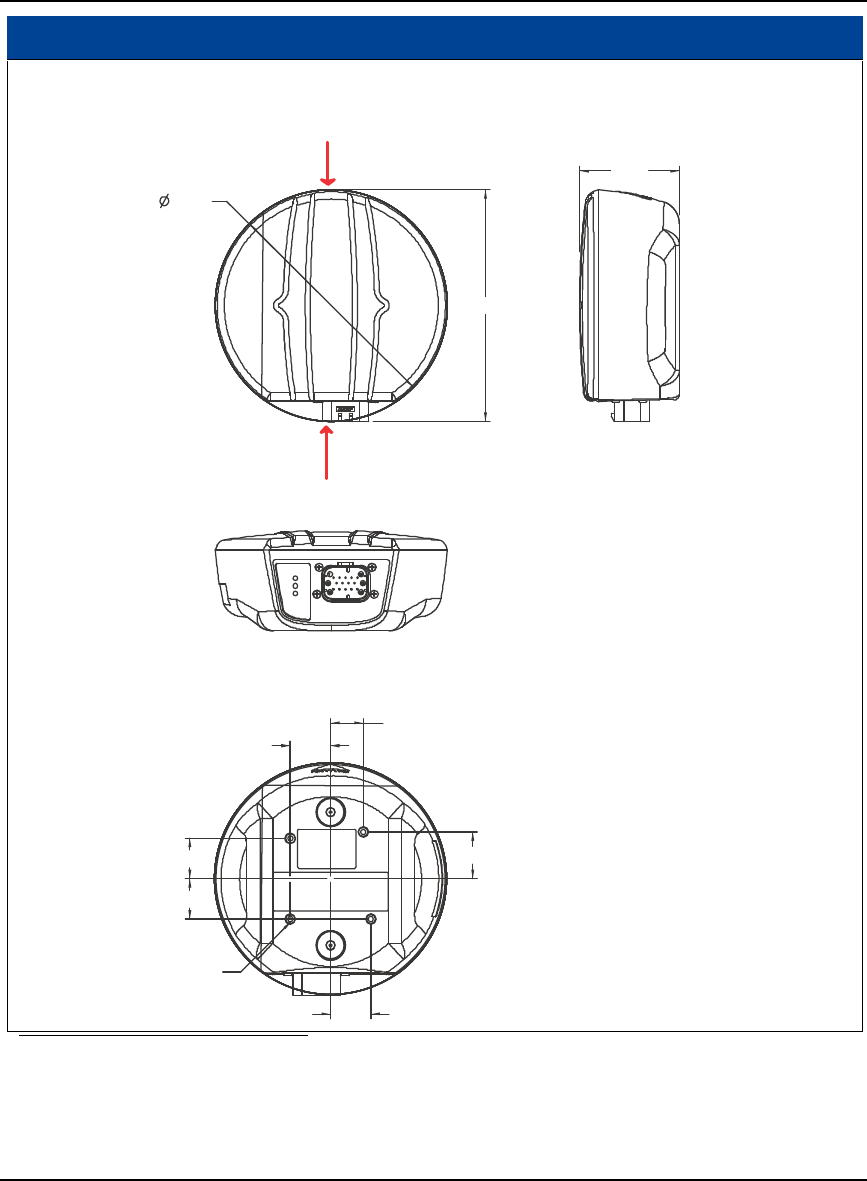
SMART-AG User Manual Rev 3C 59
DIMENSIONS
a
a. All dimension are in millimeters, please use the Unit Conversion section of the GNSS Reference
Book found at http://www.novatel.com/support/docupdates.htmfor conversion to other
measurements.
155.0
155.3
66.8
26.94
21.85
26.94
26.94
26.94
31.21
#8-32 THREADED
INSERT (4 PL.)
Back of SMART-AG unit
Front of SMART-AG unit
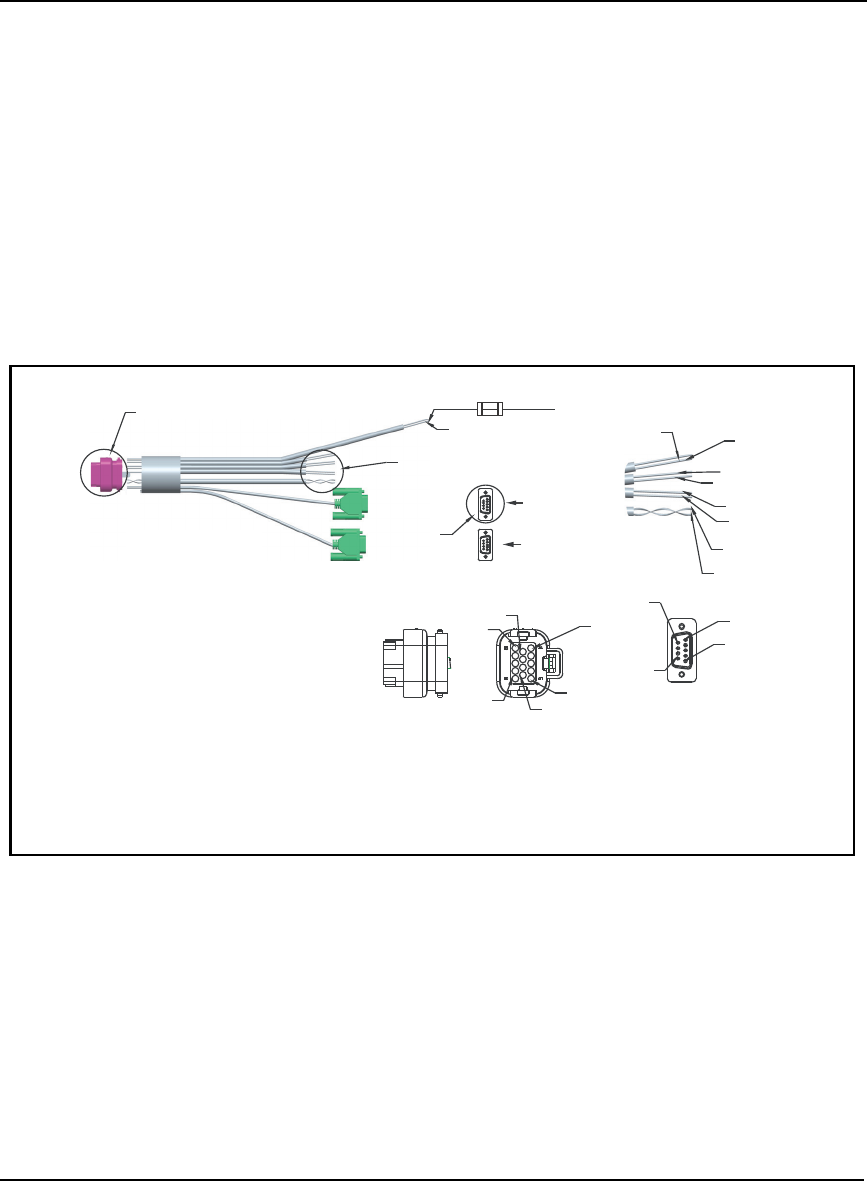
60 SMART-AG User Manual Rev 3C
A.2.1 SMART-AG Power/Communications Development Kit Cable
The SMART-AG cable that accompanies the SMART-AG Development Kit, see Figure 26 below,
provides a means of supplying power from a battery while operating in the field. The exposed wires
(red for positive and black for negative) can then be connected to a 12 or 24V vehicular power circuit
(or equivalent) protected by a 5A fast blow fuse (user supplied). The cable also has two DB-9
connectors. One can accommodate a PC/laptop serial (RS-232) communication port and the other can
connect to a modem or radio transmitter to propagate differential corrections (please refer to your
user-supplied modem or radio transmitter user guide for more information on its connectors).
In addition, there are a number of bare wires where the outer insulation is cut away but the wires
beneath are intact. See Table 7 on Page 61 for their pinouts. For more information on mating
connectors and part numbers, see Table 8 on Page 62.
This cable is RoHS compliant and its part number is 01018256.
Figure 26: SMART-AG Development Kit Cable
J2
J3
J1
0.500SCALE
SEE DETAIL A
SEE DETAIL B
RED,
BATT +
BLACK
BATT-
STRIP INSULATION FROM
12 WIRES AND CRIMP AMP/TYCO
TERMINAL # 770520-3 OR 770854-3
PER TYCO APPLICATION SPEC
114-16016
1.000SCALE
ADETAIL
BLUE,
ER_OUT WHT-BLK,
ER GND
WHITE, MKI
WHT-BLK,
MKI GND
ORANGE, PPS
WHT BLK,
PPS GND
YELLOW,
CAN1+
GREEN,
CAN1-
1.000SCALE
BDETAIL
PIN 1
PIN 2
PIN 6
PIN 9
PIN 10
PIN 14
SEE DETAIL C
1.000SCALE
CDETAIL
PIN 5
PIN 1
PIN 9
PIN 6
COM 1
COM 2
5A Fast Blow Fuse
(User Supplied)

SMART-AG User Manual Rev 3C 61
Table 7: SMART-AG Development Kit Cable Pinouts
Color Signal Name J1 J2 J3 Label
Red COM1_TXD 1 2
White COM1_RXD 2 3
Red COM2_TXD 3 2
White COM2_RXD 4 3
Black COM1 GND 5 5
Black COM2 GND 5 5
White-Black MKI GND 5 MKI GND
White-Black ER GND 5 ER GND
White-Black PPS GND 5 PULSE PER
SECOND
GND
Yellow CANI+ 6 CANI +
Green CANI- 7 CANI -
- RESERVED 8
Black PWR RET (GND) 9 BATT -
Blue EMULATED
RADAR OUT
10 ER_OUT
White EVENT MARK IN 11 MKI
Orange PPS 12 PPS
- RESERVED 13
Red PWR INPUT 14 BATT +
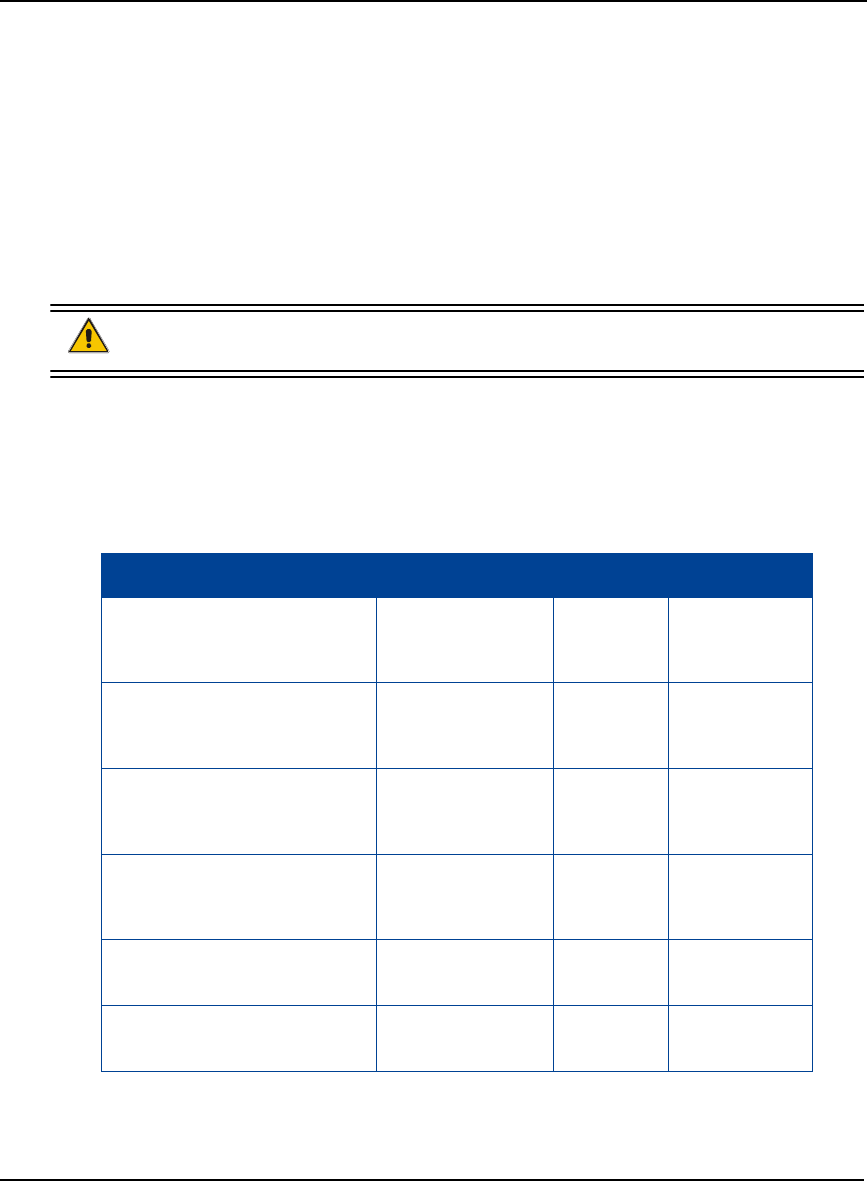
62 SMART-AG User Manual Rev 3C
A.2.2 SMART-AG Connector and Cable Requirements
Custom cables for installing your SMART-AG can be created using he following guidelines:
• Wire size: must be 0.5 mm-1.25 mm (20-16 AWG)
• Batt + connection must be protected by 5A fast blow fuse
• Serial data signals (TxD, RxD, signal ground) must be run in shielded cable.
Connect shields to ground at SMART-AG end only
• CAN signal conductors must be twisted (40 twists/m, 12 twists/ft)
• Use only the recommended mating connectors listed below. Use only gold plated
pins
WARNING!: Failure to observe the given cable construction guidelines in this section
will result in damage to the wiring (not covered by warranty).
The connector used in the SMART-AG is an “AMPSEAL” dust and water sealed type produced by
Tyco. The following part numbers pertain to the mating connector required to make connections to the
SMART-AG. These numbers are provided for information only and are not available from NovAtel as
separate parts.
Table 8: SMART-AG Mating Connectors
Table 9 details the part numbers for recommended fuses and fuse holders. These numbers are provided
for information only and are not available from NovAtel as separate parts.
Product Part Description Company Part Number
SMART-AG mating connector
(Figure 26 on Page 60)
14-pin sealed
receptacle
housing-black
Tyco/
AMP
776273-1
SMART-AG mating connector
(Figure 26 on Page 60)
14-pin sealed
receptacle
housing-natural
Tyco/
AMP
776273-2
SMART-AG mating connector
(Figure 26 on Page 60)
14-pin sealed
receptacle
housing-grey
Tyco/
AMP
776273-4
SMART-AG mating connector
(Figure 26 on Page 60)
14-pin sealed
receptacle
housing-blue
Tyco/
AMP
776273-5
Gold plated pins for SMART-
AG connector/loose
Pins, loose piece Tyco/
AMP
770854-3
Gold plated pins for SMART-
AG connector/strip
Pins, strip (reel) Tyco/
AMP
770520-3
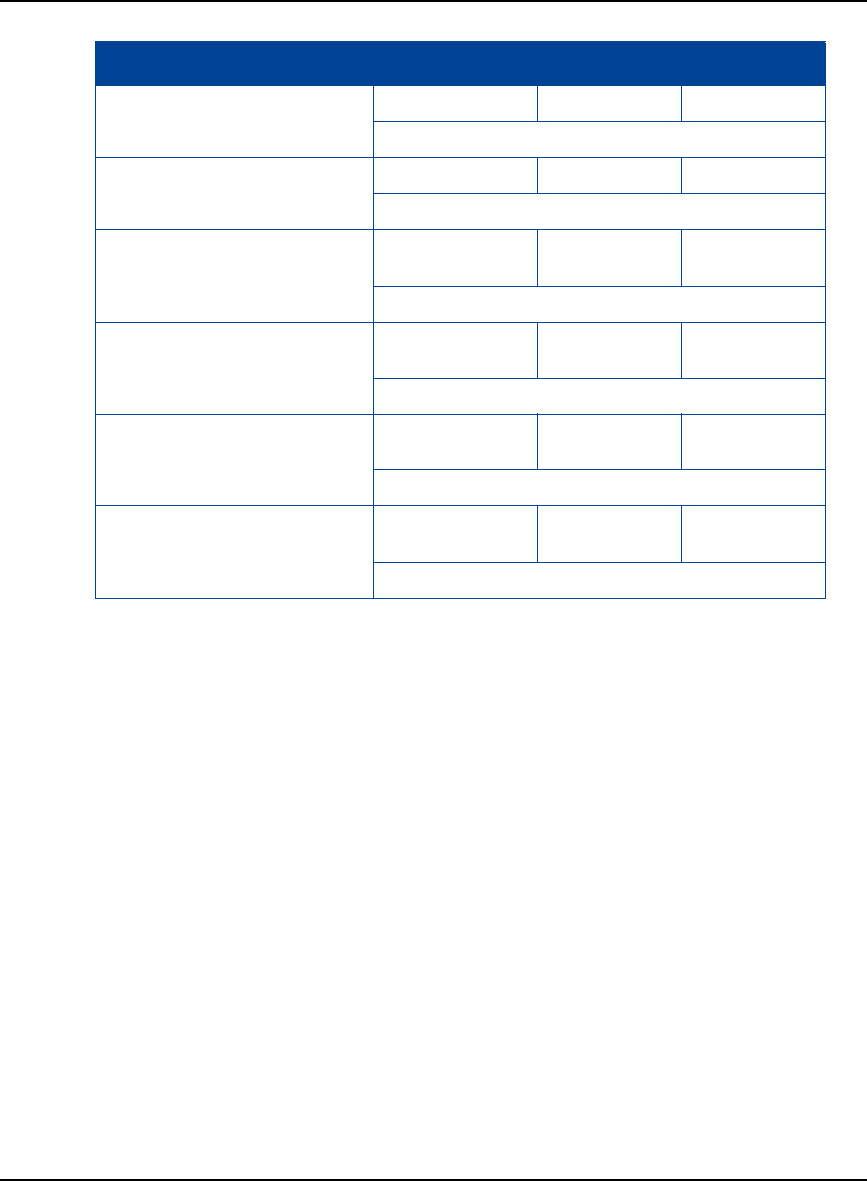
SMART-AG User Manual Rev 3C 63
Table 9: Recommended Fuse and Fuse Holders
Fuse Recommended Fuse/Fuse Holder
12 V Fuse (standard size blade) ATO Blade Fuse 5A Littelfuse 0257005
Or Equivalent
12 V Fuse (mini size blade) Mini Blade Fuse 5A Littelfuse 0297005
Or Equivalent
24V Fuse (standard size blade) TAC ATO Blade
Fuse 5A
Littelfuse 142.6185.450
Or Equivalent
24V Fuse (mini size blade) Mini Blade Fuse
58V 5A
Littelfuse 0997005
Or Equivalent
Fuse Holder (standard size blade) In-line ATO fuse
holder
Littelfuse FHAC0001
Or Equivalent
Fuse Holder (mini size blade) In-line mini fuse
holder
Littelfuse 0FHM0001
Or Equivalent
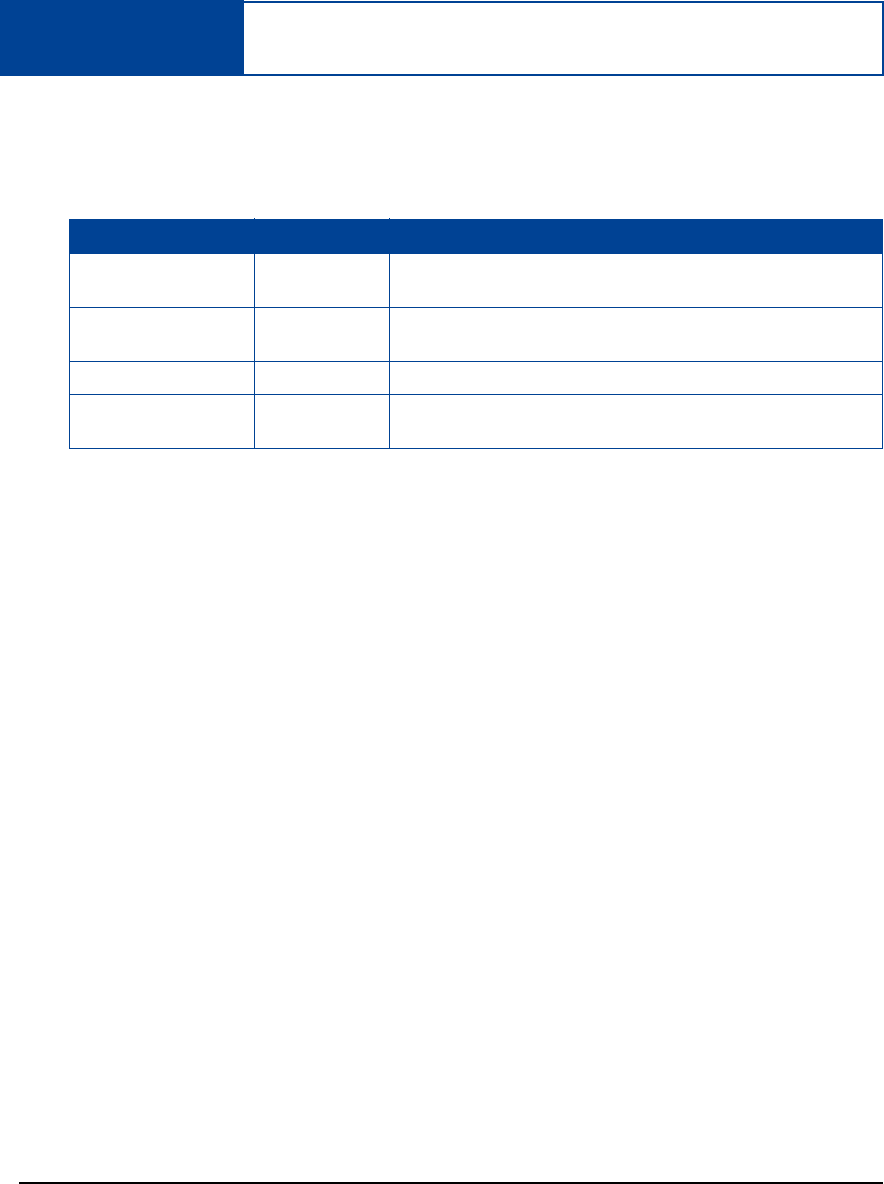
SMART-AG User Manual Rev 3C 64
Appendix B Commands
The SMART-AG firmware implements the commands in Tab le 1 0, in addition to the OEMV family
command set. The LOG command is available to all OEMV receivers but is an essential command to
do any logging. It is included in this appendix for your convenience.
Table 10: SMART-AG Commands in Alphabetical Order
The arguments for each of these commands are described in the following sections.
For a complete listing and description of the other commands that the SMART-AG, an OEMV-1G-
based receiver, is capable of processing, refer to the OEMV Family Firmware Reference Manual.
B.1 SYNTAX CONVENTIONS
The following rules apply when entering commands, at the command prompt, from a keyboard.
1. Courier font is used to illustrate program output or user input.
2. References to other commands, logs or any of their fields are shown in italics.
3. The commands are not case sensitive. For example, you could type either RESET or reset.
4. Except where noted, either a space or a comma can separate commands and their required entries.
For example, you could type either fix position 51.11358042 -114.04358013
1059.4105 or fix position 51.11358042, -114.04358013, 1059.4105.
5. At the end of a command, a carriage return is required. For example, press <Enter> or <Return>
on your keyboard.
6. Responses are provided to indicate whether or not an entered command was accepted. The format
of the response depends on the format of the command. Refer to the OEMV Family Firmware
Reference Manual for more information.
7. Optional parameters are indicated by square brackets ( [ ] ). For commands that contain
optional parameters, the value used if the optional parameter is not specified is given in the syntax
table for the command.
8. Data format definitions, as specified in the “Format” field, are detailed in the OEMV Family
Firmware Reference Manual. Note that all binary data is little-endian byte-ordered.
ASCII Command Message ID Description
freset 20 Factory reset (Existing OEMV Command extended to
SMART-AG)
log 1 Request logs from the receiver (Existing OEMV Command
extended to SMART-AG)
radarcfg 8192 Configure the ER signal output (New SMART-AG command)
reset 18 Perform a hardware reset (Existing OEMV Command
extended to SMART-AG)
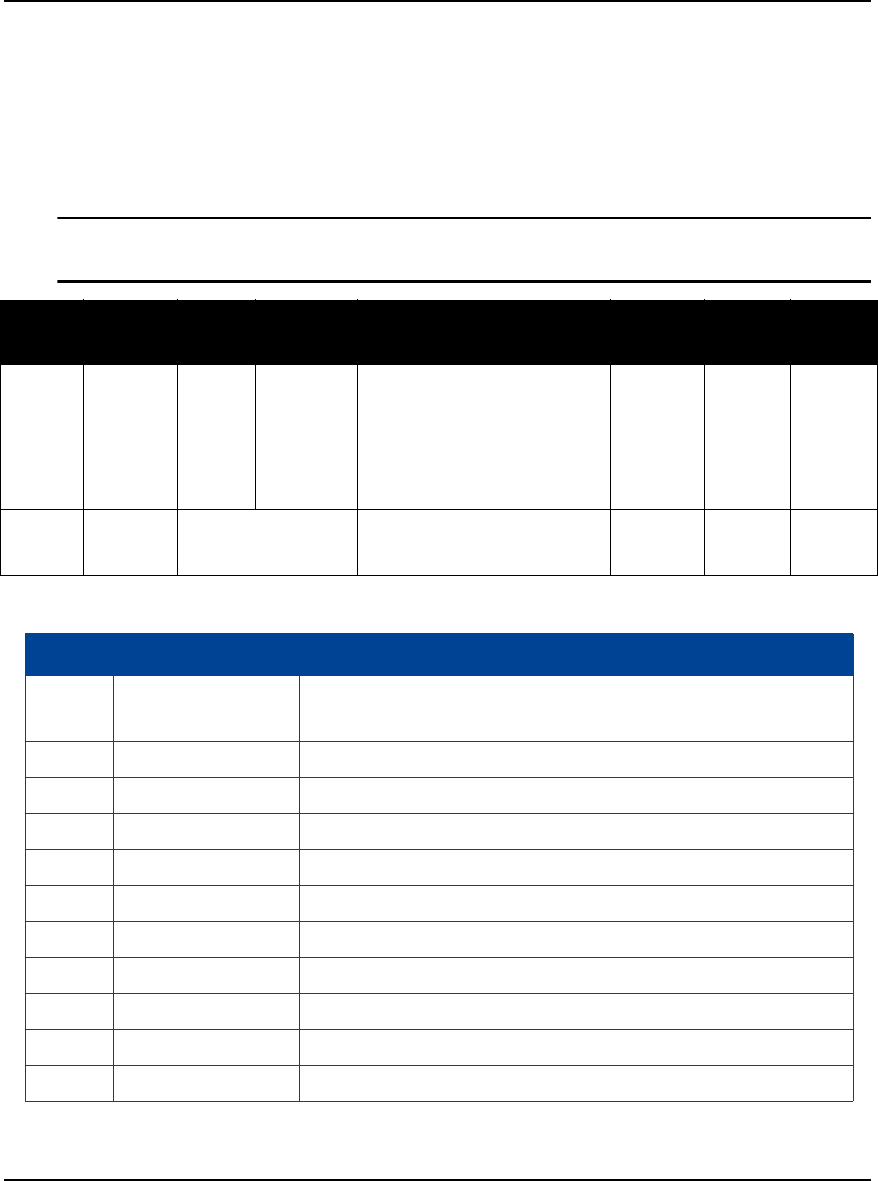
SMART-AG User Manual Rev 3C 65
B.2 FRESET Clear Selected Data from NVM and Reset
The OEMV freset command is extended to include SMART-AG features. An additional target field,
userdata (value = 10), resets only the SMART-AG user data NVM, thereby resetting all parameters
indicated in this document as “Stored in NVM” to factory defaults. Issuing the freset command with
the “target” field set to standard, resets the userdata NVM as well as OEMV parameters as indicated
in the OEMV Family Firmware Reference Manual.
If you issue the FRESET command without any parameters, it is the same as issuing a FRESET
STANDARD command.
Table 11: FRESET Target
Field Field
Type
ASCII
Value
Binary
Value Description Binary
Format
Binary
Bytes
Binary
Offset
1FRESE
T
header
- - This field contains the
command name or the
message header depending
on whether the command is
abbreviated ASCII, ASCII or
binary, respectively.
-H0
2 target See Table 11 Data to be reset by the
receiver
Enum 4 H
Binary ASCII Description
0 STANDARD Resets commands, ephemeris, and almanac (default). Also resets
all L-band related data except for subscription information.
1 COMMAND Resets the stored commands (saved configuration)
2 GPSALMANAC Resets the stored GPS almanac
3 GPSEPHEM Resets the stored GPS ephemeris
4 GLOEPHEM Resets the stored GLONASS ephemeris
5 MODEL Resets the currently selected model
10 USERDATA Reset SMART-AG-only commands
11 CLKCALIBRATION Resets the parameters entered using the CLOCKCALIBRATE
20 SBASALMANAC Resets the stored SBAS almanac
21 LAST_POSITION Resets the position using the last stored position
31 GLOALMANAC Resets the stored GLONASS almanac

66 SMART-AG User Manual Rev 3C
B.3 LOG Request Logs from the Receiver
Many different types of data can be logged using several different methods of triggering the log
events. Every log element can be directed to any combination of the three COM ports and three USB
ports. The ONTIME trigger option requires the addition of the period parameter. See the OEMV
Firmware Reference Manual and the SMART-AG Firmware Reference Manual for further information
and a complete list of data log structures. The LOG command tables in this section show the ASCII
command format.
The optional parameter [hold] prevents a log from being removed when the UNLOGALL command,
with its defaults, is issued. To remove a log which was invoked using the [hold] parameter requires the
specific use of the UNLOG command. To remove all logs that have the [hold] parameter, use the
UNLOGALL command with the held field set to 1.
The [port] parameter is optional. If [port] is not specified, [port] is defaulted to the port that the com-
mand was received on.
* 1. The OEMV family of receivers can handle 30 logs at a time. If you attempt to log more
than 30 logs at a time, the receiver responds with an Insufficient Resources error. Each
COM port (serial and USB) already has RXSTATUSEVENT log associated with it. This
means that with 3 serial ports and 3 USB ports, 6 logs are already accounted for. See the
example on the next page.
2. Maximum flexibility for logging data is provided to the user by these logs. The user is
cautioned, however, to recognize that each log requested requires additional CPU time and
memory buffer space. Too many logs may result in lost data and degraded CPU performance.
Receiver overload can be monitored using the idle-time field and buffer overload bits of the
Receiver Status in any log header.
3. Polled log types do not allow fractional offsets or ONTIME rates faster than 1Hz.
4. Use the ONNEW trigger with the MARKTIME, MARK2TIME, MARKPOS or
MARK2POS logs.

SMART-AG User Manual Rev 3C 67
5. Only the MARKPOS, MARK2POS, MARKTIME or MARK2TIME logs, and ‘polled’ log
types are generated ‘on the fly’ at the exact time of the mark. Synchronous and asynchronous
logs output the most recently available data.
6. If you do use the ONTIME trigger with asynchronous logs, the time stamp in the log does not
necessarily represent the time the data was generated, but rather the time when the log is
being transmitted.
Abbreviated ASCII Syntax: Message ID: 1
LOG [port] message [trigger [period [offset [hold]]]]
Factory Default:
log com1 rxstatuseventa onnew 0 0 hold
log com2 rxstatuseventa onnew 0 0 hold
log com3 rxstatuseventa onnew 0 0 hold
log aux rxstatuseventa onnew 0 0 hold
log usb1 rxstatuseventa onnew 0 0 hold
log usb2 rxstatuseventa onnew 0 0 hold
log usb3 rxstatuseventa onnew 0 0 hold
Abbreviated ASCII Example 1:
log com1 bestpos ontime 7 0.5 hold
The above example shows BESTPOS logging to COM port 1 at 7 second intervals and offset by 0.5
seconds (output at 0.5, 7.5, 14.5 seconds and so on). The [hold] parameter is set so that logging is not
disrupted by the UNLOGALL command.
To send a log only one time, the trigger option can be ignored.
Abbreviated ASCII Example 2:
log com1 bestpos once 0.000000 0.000000 nohold
Refer to the Command Formats section of the OEMV Firmware Reference Manual for additional
examples.
*1.In CDU there are two ways to initiate data logging to the receiver's serial ports. You can
either enter the LOG command in the Console window, or use the interface provided in
the Logging Control window. Ensure the Power Settings on your PC are not set to go into
Hibernate or Standby modes. Data is lost if one of these modes occurs during a logging
session.
2. Only the ASCII/Abbreviated ASCII log table is included in this manual. Please refer to the
LOG command in the OEMV Family Firmware Reference Manual for binary log details.

68 SMART-AG User Manual Rev 3C
Fiel
d
Field
Name
ASCII
Value Description Field
Type
1LOG
(ASCII)
header
- This field contains the command name or
the message header depending on whether
the command is abbreviated ASCII or ASCII
respectively.
-
2 port See Table 12,
Detailed Serial Port
Identifiers on Page 69
Output port
(default = THISPORT)
Enum
3 message Any valid message
name, with an optional
A or B suffix.
Message name of log to output Char [ ]
4 trigger ONNEW Output when the message is updated (not
necessarily changed)
Enum
ONCHANGED Output when the message is changed
ONTIME Output on a time interval
ONNEXT Output only the next message
ONCE Output only the current message. (default)
ONMARK Output when a pulse is detected on the mark
1 input, MK1I
5 period Any positive double
value larger than the
receiver’s minimum
raw measurement
period
Log period (for ONTIME trigger) in seconds
(default = 0)
Double
6 offset Any positive double
value smaller than the
period.
Offset for period (ONTIME trigger) in
seconds. If you wished to log data at 1
second after every minute you would set the
period to 60 and the offset to 1 (default = 0)
Double
7 hold NOHOLD Allow log to be removed by the UNLOGALL
command (default)
Enum
HOLD Prevent log from being removed by the
UNLOGALL command

SMART-AG User Manual Rev 3C 69
Table 12: Detailed Serial Port Identifiers
ASCII Port
Name
Hex Port
Value
Decimal Port
Value aDescription
NO_PORTS 0 0 No ports specified
COM1_ALL 1 1 All virtual ports for COM port 1
COM2_ALL 2 2 All virtual ports for COM port 2
COM3_ALL 3 3 All virtual ports for COM port 3
THISPORT_ALL 6 6 All virtual ports for the current port
ALL_PORTS 8 8 All virtual ports for all ports
XCOM1_ALL 9 9 All virtual COM1 ports
XCOM2_ALL 10 10 All virtual COM2 ports
USB1_ALL d 13 All virtual ports for USB port 1
USB2_ALL e 14 All virtual ports for USB port 2
USB3_ALL f 15 All virtual ports for USB port 3
AUX_ALL 10 16 All virtual ports for the AUX port b
XCOM3_ALL 11 17 All virtual COM3 ports
COM1 20 32 COM port 1, virtual port 0
COM1_1 21 33 COM port 1, virtual port 1
. . .
COM1_31 3f 63 COM port 1, virtual port 31
COM2 40 64 COM port 2, virtual port 0
. . .
COM2_31 5f 95 COM port 2, virtual port 31
COM3 60 96 COM port 3, virtual port 0
. . .
COM3_31 7f 127 COM port 3, virtual port 31
USB 80 128 USB port, virtual port 0
. . .
USB_31 9f 159 USB port, virtual port 31
SPECIAL a0 160 Unknown port, virtual port 0
. . .
SPECIAL_31 bf 191 Unknown port, virtual port 31
THISPORT c0 192 Current COM port, virtual port 0
Continued on Page 70

70 SMART-AG User Manual Rev 3C
THISPORT_31 df 223 Current COM port, virtual port 31
FILE ce0c224cUser-specified file destination, 0 c
FILE_1ce1c225cUser-specified file destination, 1 c
. . .
FILE_31cff c255cUser-specified file destination, 31 c
XCOM1 1a0 416 Virtual COM1 port, virtual port 0
XCOM1_1 1a1 417 Virtual COM1 port, virtual port 1
. . .
XCOM1_31 1bf 447 Virtual COM1 port, virtual port 31
XCOM2 2a0 672 Virtual COM2 port, virtual port 0
XCOM2_1 2a1 673 Virtual COM2 port, virtual port 1
. . .
XCOM2_31 2bf 703 Virtual COM2 port, virtual port 31
USB1 5a0 1440 USB port 1, virtual port 0
USB1_1 5a1 1441 USB port 1, virtual port 1
. . .
USB1_31 5bf 1471 USB port 1, virtual port 31
USB2 6a0 1696 USB port 2, virtual port 0
. . .
USB2_31 6bf 1727 USB port 2, virtual port 31
USB3 7a0 1952 USB port 3, virtual port 0
. . .
USB3_31 7bf 1983 USB port 3, virtual port 31
AUXc8a0c2208cAUX port, virtual port 0 b
. . .
AUX_31c8bfc2239cAUX port, virtual port 31 b
XCOM3 9a0 2464 Virtual COM3 port, virtual port 0
. . .
XCOM3_31 9bf 2495 Virtual COM3 port, virtual port 31
a. Decimal port values 0 through 16 are only available to the UNLOGALL command and
cannot be used in the UNLOG command, or in the binary message header.
b. The AUX port is available on OEMV-2-based and OEMV-3-based products.
c. SMART-AG only. Refer to the SMART-AG Firmware Reference Manual and CDU’s Help
file.
ASCII Port
Name
Hex Port
Value
Decimal Port
Value aDescription

SMART-AG User Manual Rev 3C 71
B.4 $PMDT Configure Tilt Compensation
Use this command to configure the Tilt Compensation function.
Syntax
$PMDT,[command],[parameters]*cksum
Host Description Command Format Tilt Sensor Response
lSet Field Level $PMDT,l,*cksum crlf
Example:
$PMDT,l*4D)
Response to the “l” command:
$PMDT,<,Level state set crlf
Example:
$PMDT,<,Level state set
ua b
a. If all fields in the u command are zero or null, the current height is transmitted without
change (with the format shown above).
b. If an invalid entry is received (>500 inches), the response is:
$PMDT,<Max legal height exceeded: nnnnn and will be ignored clrf
For example, if you enter 42 ft 6 in, you will get the following response:
$PMDT,<,Max legal height exceeded: 00510 and will be ignored
$PMDT,<,GPS sensor height (inches): 00150
Set GPS Sensor
Height
To set the GPS sensor height in
feet and inches:
$PMDT,u,,ff,ii,*cksum crlf
Example: To set the GPS sensor
height to 12 ft 6 in, the command
is:
$PMDT,u,,12,6*4D)
Note: Feet and inches are entered
as integers, You can enter feet
and inches, but not feet, inches
and metres.
Response to the “u” command:
$PMDT,<,GPS sensor height
(inches):nnnnn crlf
where nnnnn is a five digit integer,
sensor height in inches.
In this example, the Tilt Sensor
response is:
$PMDT,<,GPS sensor height
(inches): 00150
To set the GPS sensor height in
metres:
$PMDT,u,,,,mmm.mmm *cksum
crlf
Example: To set the GPS sensor
height to 3.5 metres, the
command is:
$PMDT,u,,,,3.5*5C
Repsonse to the ”u” command:
$PMDT,<,GPS sensor height
(inches):nnnnn crlf
where nnnnn is a five digit integer,
sensor height in inches.
In this example, the Tilt Sensor
response is:
$PMDT,<,GPS sensor height
(inches): 00137
xUpdate Flash
Values
To update flash values (needs to
follow any parameter update that
is not done each time you power
up):
$PMDT,x,*cksum crlf
Example:
$PMDT,c,*59
Response to thje “x” command:
$PMDT,<,Flash updated crlf
Example:
$PMDT,<,Flash updated

72 SMART-AG User Manual Rev 3C
B.5 RADARCFG Configure the ER Output
Use this command to configure the Emulated Radar (ER) output. ER is available through the SMART-
AG multi-cable, see Page 61 for pin-out details.
Syntax
radarcfg switch freq_step update_rate resp_mode threshold
Message ID = 8192
Field Data Description Bytes Format Units Offset
1 Header This field contains the command name
or the message header depending on
whether the command is abbreviated
ASCII, ASCII or binary, respectively.
--0
2 switch Enable or disable radar emulation
0 = ENABLE
1 = DISABLE
(default = enable)
4EnumnoneH
3 freq_step Frequency step per kilometer per hour.
Range: 26.11, 28.12 or 36.11
(default = 26.11)
8 Double Hz/
kph
H+4
4 update_rate Specify how often to update radar
output
Range: 1, 2, 5, 10, 20 (default =
10)a
4 Integer Hz H+12
5 resp_mode Specify the time, response mode, over
which to average velocity samples, see
Table 13.
(Default = 300)a
4 Integer none H+16
6 threshold The threshold is only applicable when
the response mode is set to 2. The
response time is 1000 ms when the
velocity is greater than this value,
otherwise, it is 500 ms.
Range: 2-50 kph (default = 5 kph)
8 Double kph H+20
a. The number of samples used for smoothing depends on both the update_rate and resp_mode parameters.
For instance, if the update_rate is 5 Hz and the resp_mode is 200ms, the number of samples used will be
10.

SMART-AG User Manual Rev 3C 73
Table 13: Response Modes
Example 1 to disable radar emulation: radarcfg disable 26.11 1 1 2
Example 2 to set the frequency step to 36.11 Hz/kph: radarcfg enable 36.11 1 1 2
Mode Description
2000 2000 ms
The time period over which to smooth
velocity samples
1000 1000 ms
500 500 ms (default)
2 Automatically switches between 1000 and 500 ms
1 Performs no smoothing
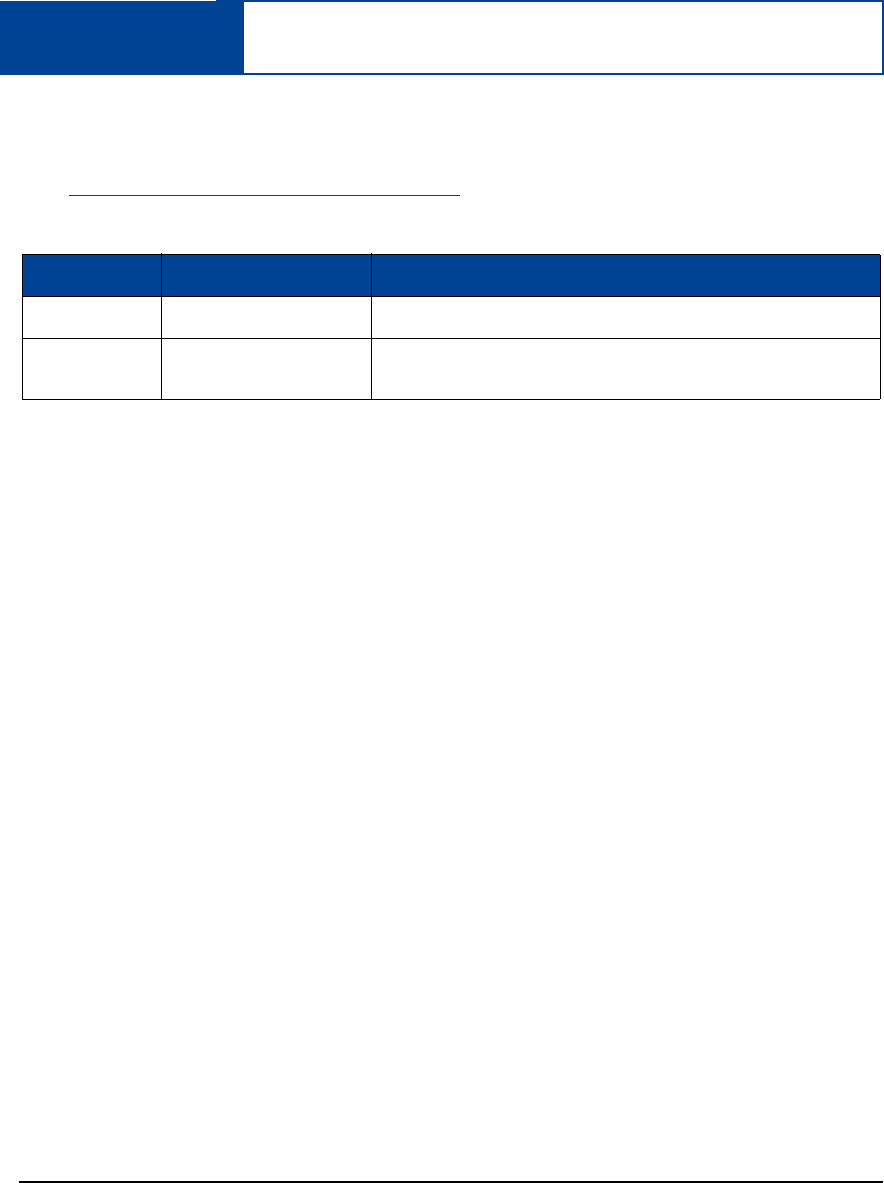
SMART-AG User Manual Rev 3C 74
Appendix C Logs
The SMART-AG firmware generates the logs in Table 14, in addition to those of the OEMV Family
log set. Refer to the OEMV Family Firmware Reference Manual, which also contains procedures and
explanations related to data logging and is available from our Web site at:
http://www.novatel.com/support/docupdates.htm
Table 14: SMART-AG Logs in Alphabetical Order
Message ID ASCII Log Description
8193 RADARSIGNAL Radar signal and position information (New SMART-AG log)
37 VERSION Hardware versions, software versions, and serial numbers
(Existing OEMV log extended to SMART-AG)

SMART-AG User Manual Rev 3C 75
C.1 RADARSIGNAL ER Signal and Position Information
This log contains position and Emulated Radar (ER) signal information.
Message ID: 8193
Log Type: Asynch
Recommended Input:
log radarsignala onchanged
ASCII Example 1 (stationary SMART-AG):
#RADARSIGNALA,COM1,0,61.5,FINESTEERING,1501,248381.628,00000000,8a1c,3723;
SOL_COMPUTED,WAAS,0.0139,0.00,0.00*f0d580ca
ASCII Example 2 (moving SMART-AG):
#RADARSIGNALA,COM1,0,42.5,FINESTEERING,1428,206179.600,00000000,baa8,3349;
SOL_COMPUTED,WAAS,0.3315,2,0.3152,473.97,29.62*c1479c20
Field # Field type Data Description Format Binary
Bytes
Binary
Offset
1RADAR-
SIGNAL
header
Log header H 0
2sol status Solution status, see Table 16, Solution Status on
Page 77
Enum 4 H
3vel type Velocity type, see Table 15, Position or Velocity
Type on Page 76
Enum 4H+4
4speed Speed over ground (m/s) Double 8H+8
4varf freq External VARF output frequency (Hz) Double 8H+16
5radar freq Radar signal frequency (Hz) as output by the
Emulated Radar Out signal. See SMART-AG
Development Kit Cable starting on Page 60.
Double 8H+24
6 xxxx 32-bit CRC (ASCII and Binary only) Hex 4H+32
7[CR][LF] Sentence terminator (ASCII only) - - -
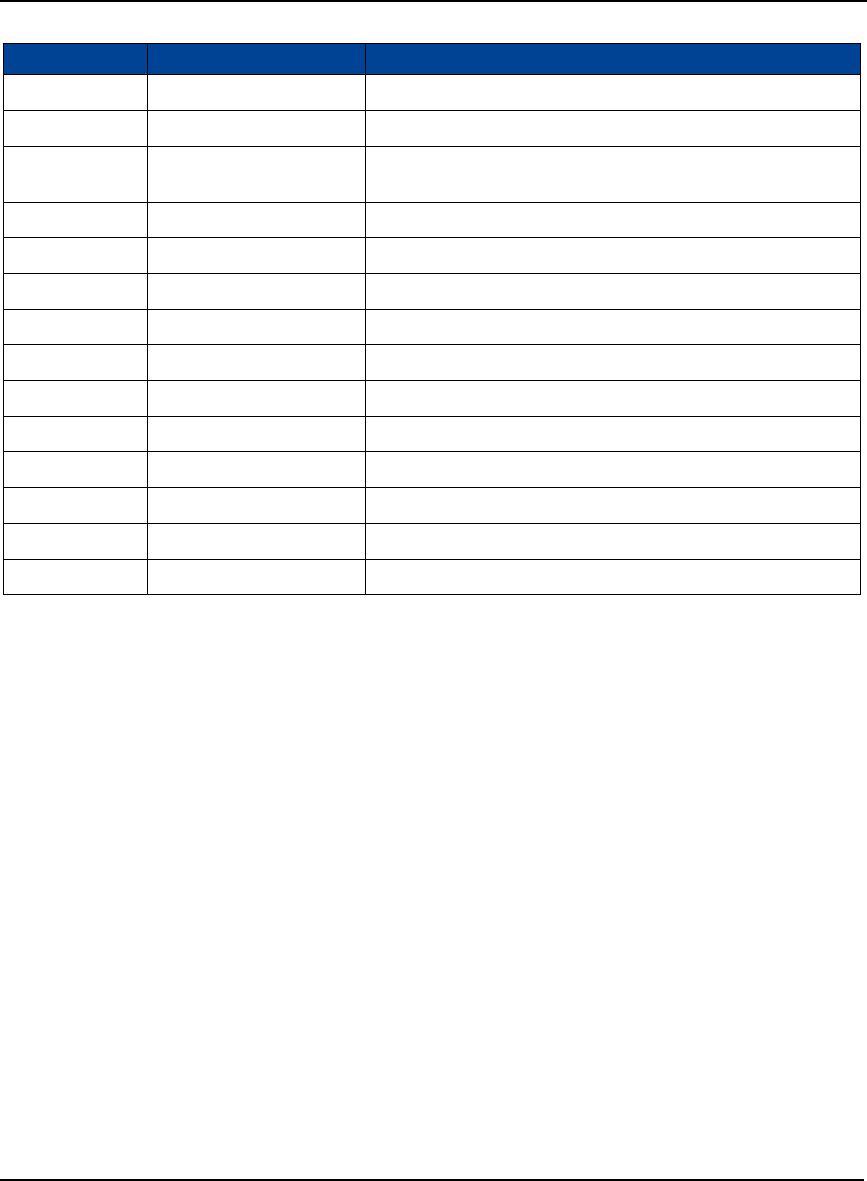
76 SMART-AG User Manual Rev 3C
Table 15: Position or Velocity Type
Type (binary) Type (ASCII) Description
0NONE No solution
1 FIXEDPOS Position has been fixed by the FIX POSITION command
2 FIXEDHEIGHT Position has been fixed by the FIX HEIGHT/AUTO
command
8 DOPPLER_VELOCITY Velocity computed using instantaneous Doppler
16 SINGLE Single point position
17 PSRDIFF Pseudorange differential solution
18 WAAS Solution calculated using corrections from an SBAS
19 PROPAGATED Propagated by a Kalman filter without new observations
32 L1_FLOAT Floating L1 ambiguity solution
33 IONOFREE_FLOAT Floating ionospheric-free ambiguity solution
34 NARROW_FLOAT Floating narrow-lane ambiguity solution
48 L1_INT Integer L1 ambiguity solution
49 WIDE_INT Integer wide-lane ambiguity solution
50 NARROW_INT Integer narrow-lane ambiguity solution

SMART-AG User Manual Rev 3C 77
Table 16: Solution Status
Solution Status Description
(Binary) (ASCII)
0SOL_COMPUTED Solution computed
1INSUFFICIENT_OBS Insufficient observations
2NO_CONVERGENCE No convergence
3SINGULARITY Singularity at parameters matrix
4COV_TRACE Covariance trace exceeds maximum (trace > 1000 m)
5TEST_DIST Test distance exceeded (maximum of 3 rejections if
distance > 10 km)
6COLD_START Not yet converged from cold start
7V_H_LIMIT Height or velocity limits exceeded (in accordance with
export licensing restrictions)
8VARIANCE Variance exceeds limits
9RESIDUALS Residuals are too large
10 DELTA_POS Delta position is too large
11 NEGATIVE_VAR Negative variance
12 Reserved
13 INTEGRITY_WARNING Large residuals make position unreliable
14-17 Reserved for SPAN-capable receivers
18 PENDING When a FIX POSITION command is entered, the
receiver computes its own position and determines if
the fixed position is valid a
19 INVALID_FIX The fixed position, entered using the FIX POSITION
command, is not valid
20 UNAUTHORIZED Position type is unauthorized - HP or XP on a receiver
not authorized for it
a. PENDING implies there are not enough satellites being tracked to verify if the FIX POSITION
entered into the receiver is valid. The receiver needs to be tracking two or more GPS satellites to
perform this check. Under normal conditions you should only see PENDING for a few seconds on
power up before the GPS receiver has locked onto its first few satellites. If your antenna is
obstructed (or not plugged in) and you have entered a FIX POSITION command, then you may see
PENDING indefinitely.

78 SMART-AG User Manual Rev 3C
C.2 TILT Compensation
Tilt Compensation affects existing logs as follows:
• NovAtel logs that provide the Extended Solution Status field (BESTPOS, BESTXYZ, PDPPOS,
and PDPXYZ, all documented in OEMV Family Firmware Reference Manual) use the 0x80 bit to
flag the fact that Tilt Compensation is being applied.
• For NMEA CPGGA, CPGGARTK, and CPGGALONG logs, the precision of various fields
indicates whether the Tilt Compensation is being applied.
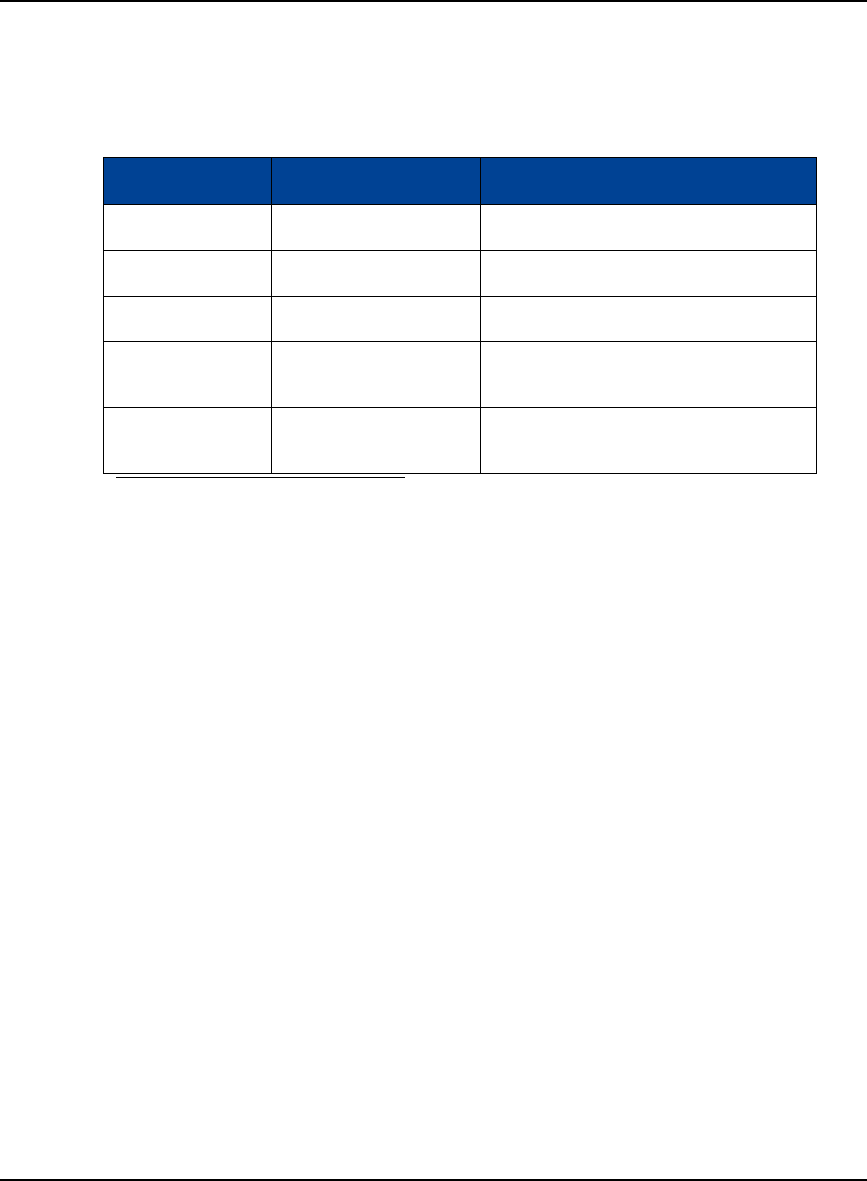
SMART-AG User Manual Rev 3C 79
C.3 VERSION HW & SW Versions and Serial Numbers
The Component Type of the VERSION log, refer to the OEMV Family Firmware Reference Manual,
is extended to include SMART-AG information as in Table 17.
Table 17: Component Type
Binary Valuea
a. Unused numbers are reserved for future use.
ASCII Value Description
0 UNKNOWN Unknown Component
1 GPSCARD OEMV GPSCard Component
3 ENCLOSURE SMART-AG Receiver
8 USERINFO User-application information
component
981073925
(0x3A7A0005)
DB_USERAPPAUTO Auto-starting user-application
firmware
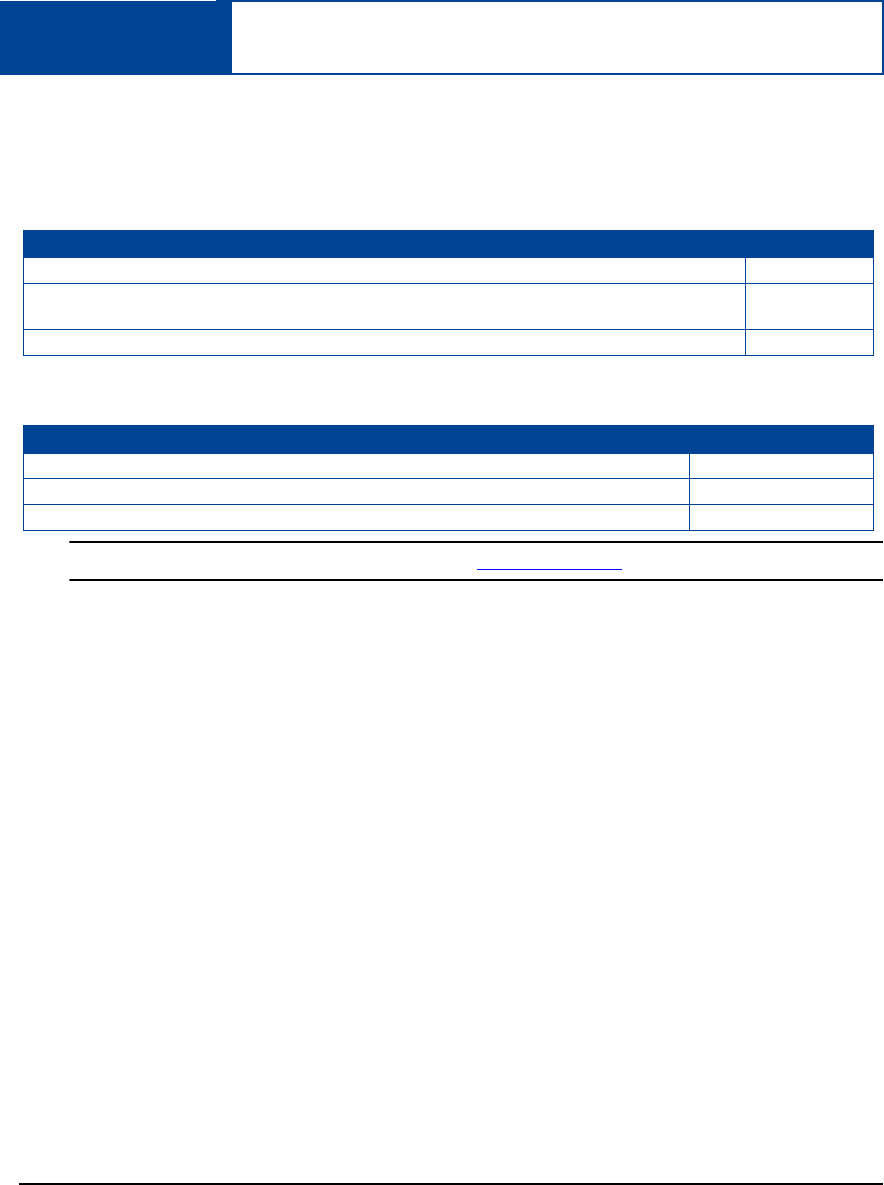
80 SMART-AG User Manual Rev 3C
Appendix D Replacement Parts
The following are a list of the replacement parts available for your NovAtel SMART-AG receiver.
Should you require assistance, or need to order additional components, please contact your local
NovAtel dealer or Customer Service representative.
D.1 SMART-AG
D.2 Accessories
The accessories above are also available from www.novatel.com
Part Description NovAtel Part
SMART-AG 01018203
Cable: 14-pin socket to 2 DB-9 connectors, twisted CAN I/O pair, and other bare wire
connectors (see Section 25, SMART-AG Development Kit Cable starting on Page 60)
01018256
Mounting Plate 70023072
Part Description NovAtel Part
OEMV Family Compact Disc with PC utilities including CDU 01018235
OEMV Family Installation and Operation User Manual OM-20000093
OEMV Family Firmware Reference Manual OM-20000094

SMART-AG User Manual Rev 3C 81
Index
$PMDT command, 71
A
accuracy
position, 30, 57
velocity, 57
almanac, 65
antenna
internal, 18
mounting, 23
single-frequency, 23
specifications, 58
ascii, 44
AUTH command, 47
authorization, 48
AUX port, 70
B
base station, 34
baseline, 30
baud rate, 27
bidirectional communication, 28
Bluetooth, 22
configuration, 53–56
buffer, 27, 66
C
cable
serial, 27
warranty, 12
Caution, 27
CDU software, 38, 67, 80
CMR, 33
cold start, 57
COM port, 67
command, 64
Bluetooth, 55
CDU, 29
communication, 27
error message, 30
example, 30
in CDU, 42, 47
interface, 33
multiple, 34
note, 29
port, 27
pre-configure, 32
prompt, 29
RTK, 34
communication
bidirectional, 28
Bluetooth, 53
CDU, 29
getting started, 28
notice, 13
operation, 27
PC/laptop, 28
physical, 20
port, 23, 27
remote terminal, 28
COMVOUT command, 65
configuration
additional equipment, 20
base station, 32
Bluetooth, 53–56
CDU, 29
model, 19
port, 27
rover station, 33
RTK, 34
typical hardware, 27
configuring, 36
connector
input/output, 58
mounting bracket, 23
specifications, 58
Convert software, 44
copyright, 2
CPU, 66
Customer Service, 15, 47
D
data

82 SMART-AG User Manual Rev 3C
Index
Bluetooth, 53
collect, 24
erase, 65
format, 64
L-band, 65
link, 31
log, 66–67
NVM, 65
port, 23, 27
start, 28–29
storage device, 31
terminal, 28
Warning, 30
DC power, 58
dealer, 15, 47
default
Bluetooth, 55
factory, 65
interface mode, 33
log, 67
offset, 68
period, 68
port, 27, 66–68
reset, 65
trigger, 68
differential
configuration note, 34
corrections, 30, 60
operation, 30
serial cable, 60
setup, 31
directional communication, 28
distance exceeded, 77
E
EGNOS, 34
e-mail, 15
Emulated Radar (ER), 25, 72, 75
enable Bluetooth, 53
ESTB, 34
F
features, 19, 28, 47–48
firmware upgrades, 47–48
FRESET command, 65
G
GL1DE, 35
GLONASS, 45
GPSAntenna, 12
graphical user interface, 39
H
handshaking, 27
hardware
Bluetooth, 53
connector, 20
enclosure, 18
replace, 80
required, 20
setup, 22, 31
specifications, 59
header, 17
height limit, 77
hexadecimal, 17
hibernate mode, PC, 67
hold, 66, 68
I
identifier, serial port, 69
idle time, 27
input
command, 29–30
connector, 58
differential, 32–33
mark, 68
power, 22
syntax, 64
install, 16
installation, 38
integration, 16
interface
base or rover, 32–33
Bluetooth, 53
communication, 28
graphical, 22
serial, 27
introduction, 18
L
laptop power settings, 67

Index
SMART-AG User Manual Rev 3C 83
LED
front, 18
power, 21, 24
light emitting diode (LED), see LED
log, 26, 33, 66–67, 74
LOG command, 66
logs
tilt compensation, 78
logs in CDU, 43
M
memory, 66
message trigger, 68
model, 19
N
note, logging, 66
Notices, 13
NovAtel Inc., 2, 15
O
operation, 27
optionality, 17
output
connector, 58
convention, 17
log, 67–68
status, 28–29
syntax, 64
overload, 66
P
parity, 27
PC power settings, 67
period, 66, 68
port
Bluetooth, 55
COM, 20, 27, 29, 33
identifier, 69–70
interface mode, 32–33
log, 66–68
output, 68
prompt, 29–30
serial, 27
settings, 27
position
accuracy, 30
base, 30, 32
best, 75
command, 30, 34
power, 21–22
pseudorange, 34
R
RADARCFG command, 71
RADARSIGNAL log, 75
receiver status, 66
replacement parts, 80
reset
FRESET command, 29, 65
option, 65
target, 65
RESET command, 71
revision, firmware, 1, 47
Rinex, 44
rover station, 34
RTCA, 33
RTCM, 32–33
RTCMV3, 32–33
S
satellite, 23, 27
self-test, 28, 66
serial
cable, 27
number, 47
port, 33, 69
standby mode, PC, 67
status, receiver, 66
support, 12, 15
syntax, 64
T
technical specifications, 57
terrain compensation. See tilt compensation
tilt compensation, 26, 36
$PMDT command, 71
checksum, 36
disabling, 36
logs, 78
message format, 36

Index
SMART-AG User Manual Rev 3C 85
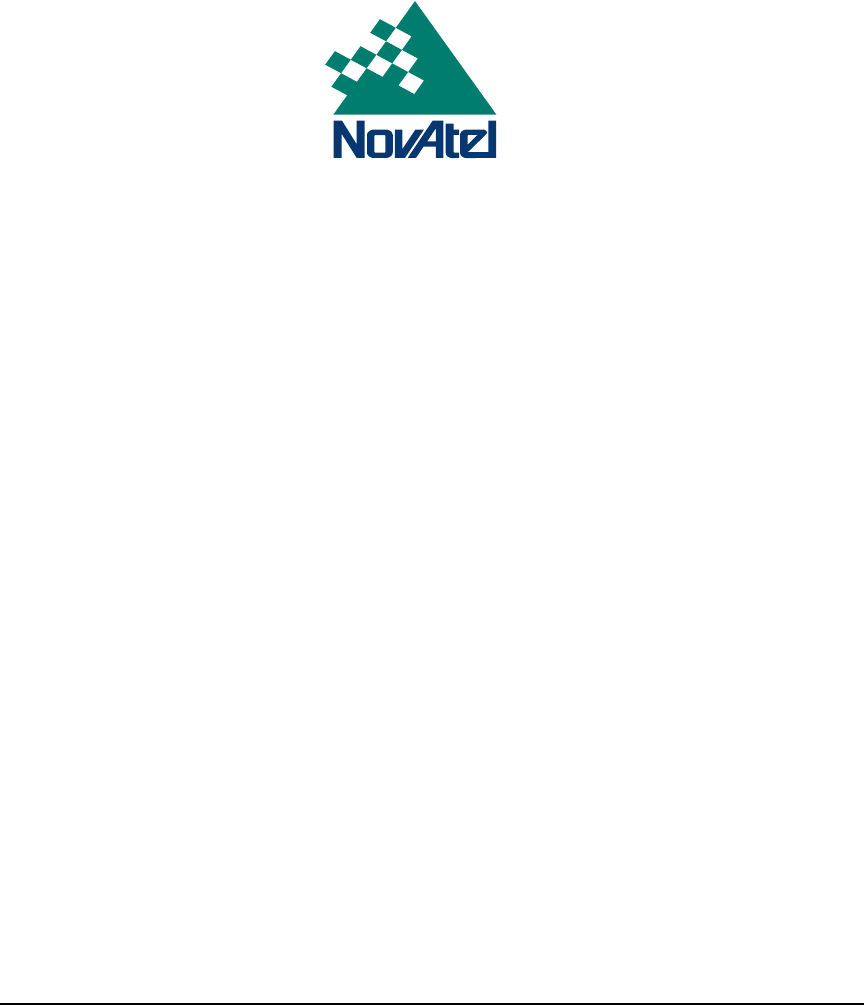
OM-20000123 Rev 3C 2009/10/19
